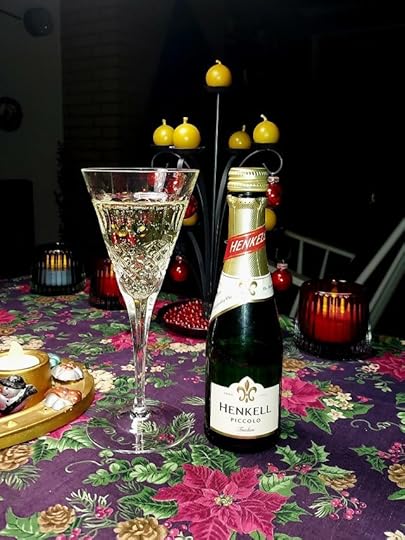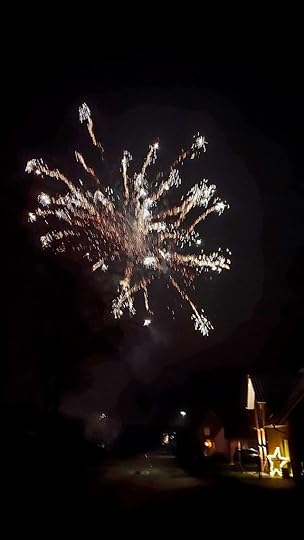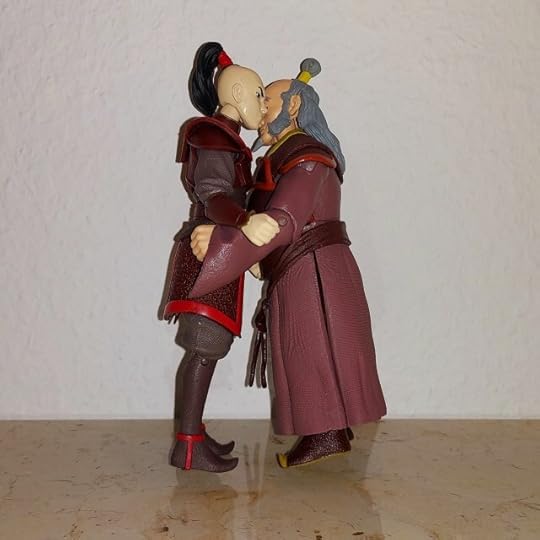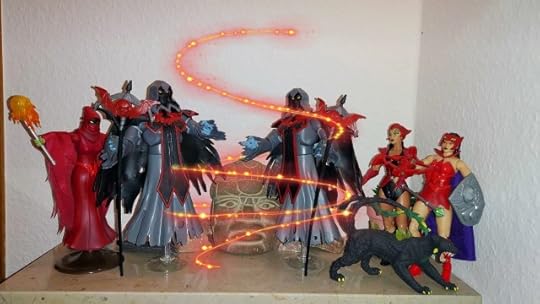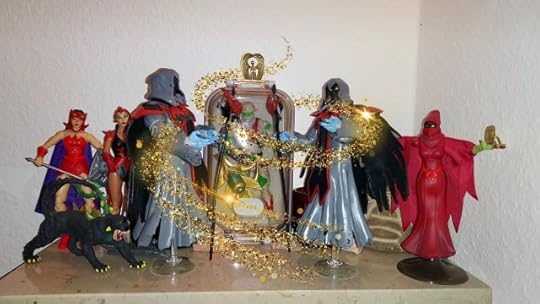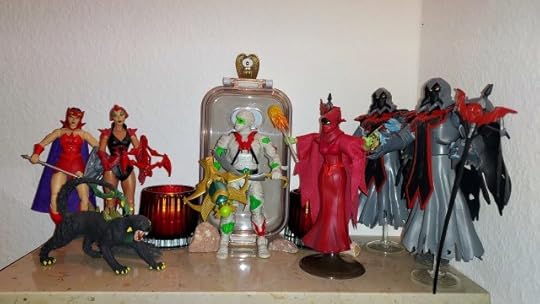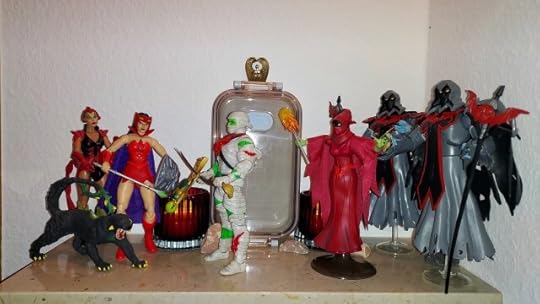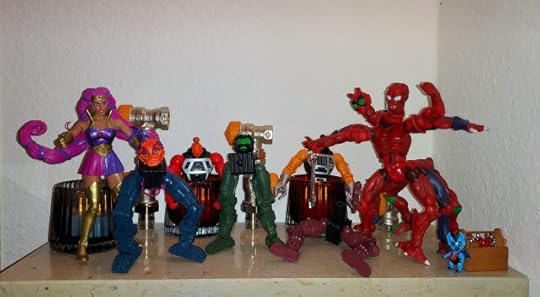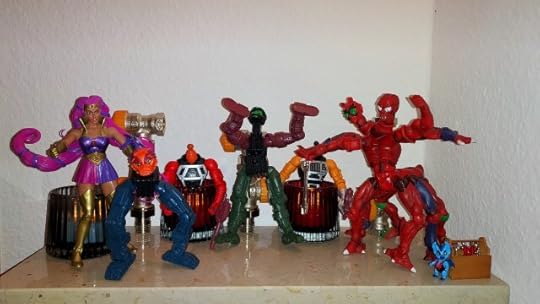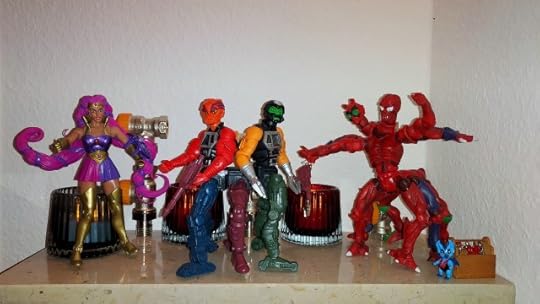Cora Buhlert's Blog, page 4
January 4, 2025
Happy New Year 2025
2025 is already three days old by now and so far, things don’t look too bad, though I am apprehensive about the general election coming up in February.
Now I have to admit that I’ve never been a huge fan of New Year’s Eve celebrations. Part of the reason is that New Year’s Eve is just too close to Christmas and I’m usually all holidayed out from three days of Christmas celebrations, so I don’t really feel like having another celebration. Of course, I did the party thing and the “standing around on the market square in the cold, watching fireworks” thing, when I was younger. But in the past few years, I mostly celebrated with my parents at home and/or in a restaurant.
My parents are both gone now and most of favourite restaurants in reasonable distance have closed down, so I was at home all alone, which suits me just fine. I initially planned to make something special for New Year’s Eve dinner. However, while my parents had both an electric fondue pot and a raclette set, I couldn’t find either, so the New Year’s Eve stand-bys fondue and raclette were out. I considered making some kind of vegetarian hotpot, but in the end I just made myself a nice hot bowl of ramen noodles, albeit jazzed up with vegetables and an egg, because that’s both quick and tasty.
Come to think of it, I think I had a bowl of ramen last year for New Year’s Eve as well, so maybe that’s my new tradition now. Unless I find the fondue pot or raclette set after all or break down and buy a new set. In fact, I should probably replace the raclette set anyway, since my parents’ set isn’t electrical as far as I recall, but uses an alcohol burner. And I don’t want open fire in my home.
When I was a kid, my parents always spent New Year’s Eve with friends in the village of Teufelsmoor (literally Devil’s Moor), who went all out decorating their living room for New Year’s Eve with garlands, streamers, cardboard silhouettes of scantily clad women and good luck charms. The decorations were about the only thing I liked about New Year’s Eve in Teufelsmoor and I wish I could have saved the silhouettes and one of the good luck charms, which I suspect were lost when my parents’s friends (well, just the wife – the husband died quite suddenly) moved out of that isolated farmhouse in Teufelsmoor into a city apartment.
Meanwhile, my own New Year’s Eve decorations are limited to the dining table, though I think we have paper garlands somewhere.
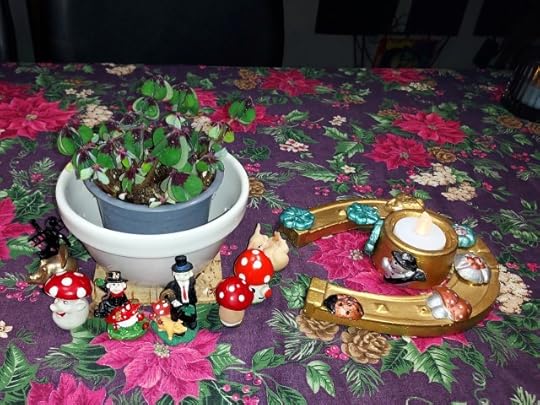
New Year’s Eve decorations
I bought a pot of four-leaf clover and arranged my own collection of good luck charms – chimney sweepers, pigs and toadstools – around the pot. I also got out my New Year’s Eve candle holder. It was a gift from a friend, when I hosted a New Year’s Eve Party sometime in the 1990s. It’s handmade, plaster-cast and painted and almost thirty years old by now, but I still treasure it, even though I long lost contact with the friend who made it.
New Year’s Night in Germany is also time for fireworks. As I explained here and here, there have been complaints about money wasted on fireworks as far back as the 1980s and in recent years, there have been more and more calls – usually from Green adjacent folks – for a fireworks ban for private citizens and for private fireworks to be replaced with professional displays or drone shows, disregarding that this requires driving during New Year’s Night and that people in small towns and villages won’t get to enjoy any fireworks at all.
It’s a stupid debate. There certainly are improvements to be made, such as stricter noise limits, ban of plastic in fireworks, requirements to pick up your trash and maybe even banning thrown firecrackers that just make noise but don’t produce a pretty lightshow altogether, since those are the biggest issue, but a total ban isn’t the answer. Though it would really help, if we could harmonise fireworks regulations across the EU, since the biggest problems and also the majority of injuries are caused by illegal fireworks imported from Poland. The fact that Berlin is very close to the Polish border and has easy access to illegal fireworks is also part of the reason why certain neighbourhoods in the city regularly turn into war zones on New Year’s Eve. I why I suspect a lot of the problems with fireworks we’re currently seeing would vanish if Poland had stricter fireworks regulations or enforced them better.
The fireworks debate is something of an annual event or rather an annual annoyance by now. However, this year – or rather last year – it just didn’t happen for some reason. I suspect the fact that there is a general election coming up in February might have something to do with it. The Green Party, who is most fervently in favour of a fireworks ban, already has the reputation of a party who wants to ban everybody from having fun or just living their lives as they please. Not without reason, because the Greens really love to ban things they disapprove of, but then so does the conservative CDU/CSU, though they disapprove of different things. Nonetheless, the Greens probably preferred not to launch into a fireworks ban debate less than two months before an election.
Though we did get the annual fireworks ban discussion after New Year’s Eve, because there were several deaths – all from illegal or homemade fireworks – as well as significant property damage in Berlin, also due to illegal fireworks, which are already banned.
Meanwhile, it seems that the constant fireworks banning debates have also caused a defiant reaction among fans of fireworks, because buying a lot of fireworks and setting them off suddenly feels rebellious. The fact that many of the pro-ban people are also incredibly aggressive doesn’t help either. Last year some woman wished death upon for pointing out that even though a majority of Germans is supposedly in favour of a fireworks ban, the sheer amount of fireworks bought and set off tells a different tale. And while some stores and chains have stopped selling fireworks altogether, others upped the ante. For example, the lowest category of fireworks, which aren’t subjects to as strict regulations, were advertised and sold in several grocery and discount stores well before Christmas. It is legal to sell the lowest category of fireworks at any time, but normally they wouldn’t explicitly advertise and offer them so early.
Meanwhile, higher category fireworks may only be sold for three days per year, between December 29 and 31. Of course, December 29 was a Sunday this year, which in previous years meant “tough luck – one day less of fireworks sales”. This year, however, the fireworks sales started on December 28. Not sure if the regulations changed or if they always allowed for this. At any rate, it meant one more day of dealing with fireworks randomly going off, even though you’re only allowed to set them off between six PM on New Year’s Eve and one AM on New Year’s Day, but no one really cares about that. Fireworks randomly going off is a problem for pets and their owners and wild animals. There’s also a risk of vandalism, since some idiots like throwing fireworks into mailboxes and newspaper tubes to blow them up. So I taped off the newspaper tube and blocked the mailbox with a heavy tool (some kind of chisel I found in Dad’s workshop) every single day, which is annoying. And of course, I had to unblock the mailbox again the next day to receive my mail.
On New Year’s Eve at half past five, my normally quiet suburban street turned into a warzone. Fireworks were going off seemingly right outside the house, so I opened the door to see if someone was setting off their fireworks directly in front of my house (some folks do that, so others have to deal with the trash). However, it turns out that one of my neighbours was setting off what looked like his entire stash early, so his two young kids aged four and two could enjoy the spectacle. Which I have some sympathy for, except that I’m not sure why you’d set off extremely loud firecrackers – they’re called cannonball crackers – near toddlers. After all, you want them to enjoy the fireworks, not be traumatised by noise.
The air outside was also smoky and appallingly bad, because we had a temperature inversion which traps gasses in the lower atmosphere. The air quality was already bad from regular exhaust fumes and fireworks made things worse. Ironically, this means that both holidays where you absolutely don’t want to have a temperature inversion – Easter, because of the traditional Easter bonfires, and New Year – did have one this year. It was pretty cold, so normally I would have used the AC in heating mode, since my battery was full, but that would have blown the bad air indoors, so I had to resort to a space heater and to keeping the central heating running through the night. As the night went on, we got a winter storm, which blew away the fireworks smoke, but caused other issues, because heavy wind tends to make fireworks fly where they’re not supposed to go.
Once the neighbour had shot his shot (or so it seemed), New Year’s Eve calmed down again towards the usual background noise of explosions going off in the distance. I had dinner and then went to my computer to finish up the 2024 eligibility post. At around quarter ten, there was another round of very noisy fireworks nearby, so I looked out of the door again and saw the neighbours on the other side setting off fireworks in their driveway with friends.
Now my neighbourhood is currently undergoing one of its periodic demographic shifts, as the original residents who moved there in the 1960s and 1970s gradually move out or die off and younger people move in, often families with kids. We had a similar demographic shift in the 1990s, when the residents who’d moved in in the 1950s or before moved out died off. The majority of the houses on my street date from the 1960s and 1970s, but some are older.
More younger people means more fireworks. In fact, the remaining older residents mostly barricaded themselves in and didn’t even come out onto the street at midnight to admire the fireworks, which is sad. The neighbourhood is also getting more diverse – there’s a Russian German family living behind me, a Turkish German couple living next door and a Lebanese family living a bit up the street and possibly others as well. Though there isn’t much of a difference in fireworks enthusiasm between Germans and people with an immigrant background, to use the politically correct expression. The traditions and celebrations might be different, but they all like fireworks and there are several people on my street and in the wider neighbourhood who set off a lot of them.
The Russian German family whose backyard borders on mine celebrated New Year’s Eve – and New Year’s Day – with a backyard barbecue, sauna and hot tub. This is how they celebrate pretty much everything – birthdays, Christmas, New Year – with barbecue, sauna and hot tub. At midnight, they briefly emerged from the sauna to set off fireworks and then retreated into the sauna again. The next day, there was more barbecue (their barbecue is really tasty BTW), more sauna and more hot tub.
At around twenty to midnight, the party next door spilled out into the driveway, as evidenced by Turkish dance music punctuated with fireworks. A little grumbly, I shut down my computer and went downstairs to get the champagne out of the fridge. Luckily I remembered to purchase a small piccolo sized champagne bottle, because a regular bottle would have been too much for one person.
I also got out one of my Mom’s vintage lead crystal champagne glasses. Mom had a full set of lead crystal glasses which date from the late 1950s or early 1960s. They were really expensive at the time and have almost no value these days, because no one collects fine china or glassware anymore and they’re not dishwasher proof either. I basically only use them for New Year’s Eve or when I have guests, though they are pretty.
Just before midnight, the fireworks started going into overdrive outside, though I waited until midnight to toast an empty room with champagne from a vintage crystal glass. Then I grabbed my coat and my boots and went outside the admire the fireworks and wish the neighbours a Happy New Year.
And there was a lot of firerwork to admire. Remember the neighbour with the two small kids who apparently had set off his entire stash at half past five? Well, turns out that he did not set off his entire stash after all, since he still had plenty left to set off at midnight. Even more amazingly, his four-year-old daughter was still (or again) awake and set in the doorway, watching adoringly as Dad indulged his fireworks habit. The Mom had apparently gone inside. I ventured over to wish them a Happy New Year and the little girl waved at me.
Meanwhile, the neighbours on the other side whose party had spilled out into the driveway at half past eleven, were eagerly setting off fireworks, while listening to music. I went over to wish them a Happy New Year and offer that one of their guests could park their car in my driveway rather than at the curb, since parking your car at the curb on New Year’s Night isn’t the best of ideas. This is also when I learned that some of the guests at the party had actually come over from Turkey, where private fireworks are not allowed on New Year’s Night, so the guests were really thrilled by this suburban fireworks display.
Someone at the party next door also had some kind of pistol – I think it was a gas pistol or probably a starter pistol – and the guests were taking turns posing, while firing into the air. They asked if I wanted to shoot as well, an offer I politely declined.
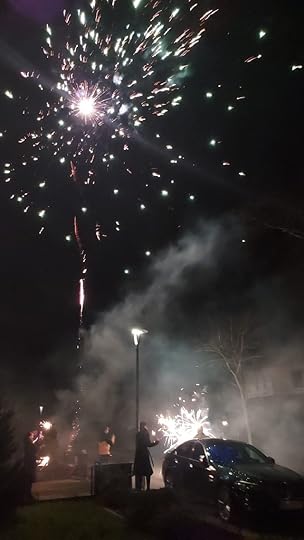
Fireworks and the silhouettes of the guests at the party next door.
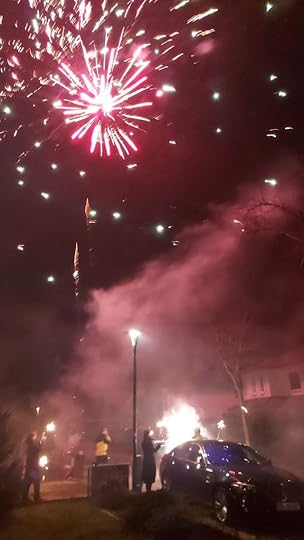
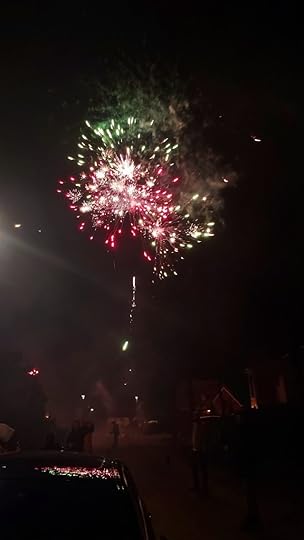 Meanwhile, a bit further down the street, some very fireworks-crazy people set off multiple of rockets all at once, which persuaded me to keep well away from them. Meanwhile, several cardboard boxes, which might have been the casings of fireworks batteries, were just left burning in the middle of the street. The entire thing had a distinctly post-apocalyptic ambience.
Meanwhile, a bit further down the street, some very fireworks-crazy people set off multiple of rockets all at once, which persuaded me to keep well away from them. Meanwhile, several cardboard boxes, which might have been the casings of fireworks batteries, were just left burning in the middle of the street. The entire thing had a distinctly post-apocalyptic ambience.
At around half-past twelve, the fireworks started to calm down a little and I ventured back inside. Though I kept hearing the occasional firecracker go off through the rest of the night.
The storm that had started to blow in on New Year’s Night fully hit us on New Year’s Day, accompanied by heavy rain, so I basically just stayed inside. Normally, I would have gone out to pick up any fireworks trash that ended up on my premises, but the weather was so bad that I didn’t. Besides, the storm might blow additional trash onto my premises, if I was unlucky, or blow trash away, if I was lucky.

Vegetarian red beans and rice
For lunch I made a big pot of vegetarian red beans and rice, since it’s a suitable New Year’s Day meal and extremely tasty. Plus, I had leftovers for the two following days.
After the storm had blown through on New Year’s Day, the weather became much more pleasant and the sun actually came out. I did go out to take an important letter to the mailbox and picked up some fireworks trash in the yard. Thankfully, there wasn’t a whole lot of fireworks trash. I guess the storm really did blow it away.
On January 3, finally, I did venture outside to go grocery shopping and also to pick up some pre-orders for myself and a friend at the Smyths Toys superstore (Smyths is an Irish chain, which took over the European Toy R Us stores after the demise of the parent company and is actively expanding) in Posthausen.
As for why Posthausen, a village of not quite 2000 people, has a Smyths Toys superstore, well, Posthausen also happens to be home to North Germany’s biggest shopping mall and one of the two biggest malls in all of Germany and the Smyths Toys store is one of the tenants.
As for why a village of not quite 2000 people in the middle of nowhere became home to one of Germany’s biggest shopping malls, which attracts some five million shoppers every year, that’s due to a man called Hermann Dodenhof, who opened a small village store in 1910. In 1925, he moved to a larger building and also acquired a large plot of farmland along with the building. The original store from 1925 could still be seen into the 1980s and may well still be there today.
The store was successful at serving customers in this very rural, very isolated area on the moors north of Bremen, so in 1961, they built one of those new-fangled department stores. The customers kept flocking to the store, which by now was also no longer in the middle of nowhere, but in easy reach of the Autobahnen A1 and A27 (in 1989, the Autobahn A1 got an exit named Posthausen, which is basically the Dodenhof exit), so in 1975 the Dodenhof family built a furniture store, then the biggest in North Germany. The Dodenhof store – and it was initially just a single big box store – kept expanding, adding a café, a children’s play area, a gas station, a gorcery store and a large warehouse where you could pick up self-assembly furniture, an idea they borrowed from IKEA. By the 1980s, Dodenhof in Posthausen was one of several big furniture stores around Bremen and I remember being taken there several times when I was a kid.
However, my Dad didn’t like Dodenhof, because an employee treated him badly once – which is ironic, because Dodenhof are famous for their well-trained and polite employees, which is why people go there over cheaper options. In fact, I have known several people who worked at Dodenhof – either as student jobs or permanently – over the years and they only praise for the company. So I guess we were just unlucky or Dad was being difficult, cause he could be a very difficult customer. Also, Dad really hated furniture shops in general, something I inherited. I was definitely there, when it Dad had his altercation with a Dodenhof employee, and I think it was about a lamp, though I don’t remember any details or even which lamp it was and if I still have it. What I do remember is going to the department store part afterwards – in the 1980s, people mainly went to Dodenhof for furniture – and being shocked at how messy the toy department was and how ugly the clothes on offer. That was it for us. I don’t think Dad ever set foot in the Dodenhof store again and neither did I.
Meanwhile, Dodenhof kept expanding and growing. They built a new multi-level fashion department, added a bridal saloon, which is where pretty everybody in the neighbourhood gets their bridal gowns, added an electronic department and a sports deaprtment and gradually turned the whole massive complex into a shopping mall, though I had no idea it was one of the two biggest malls in Germany until very recently. They also have lots of events like late night shopping, fashion shows, exhibitions, a Christmas market, etc… and they’re doing well. In fact, the one time I was at Dodenhof with my Dad after the affair of the lamp was when they hosted a motorbike show on their massive parking lot.
There are several photos on the official Dodenhof website about the history of the store and here’s a video about the history of the company and an interview with the current owner/manager. Yes, Dodenhof is still family-owned, which is extremely rare for both shopping malls and big box stores.
So on Friday morning, I got into my car and drove to Posthausen. The Smyths Toys store is on the edge of the gigantic Dodenhof premises, sandwiched between the gas station and an Aldi supermarket.
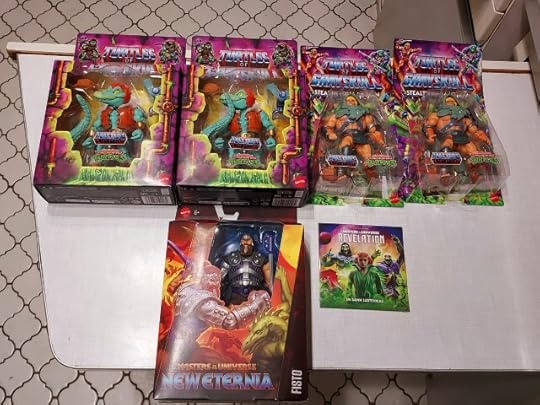
And here’s my haul from Smyths Toys on the kitchen table with two Turtles of Grayskull Leatherhead figures, two Turtles of Grayskull Stealth He-Men, a Masterverse New Eternia Fisto and a free audio drama on CD.
When I set out, the sun was shining. By the time I got to Posthausen – a trip that takes maybe 25 minutes – the sky was overcast. When I walked out of Smyths, there was dense snowfall outside. Initially, I had planned to go to the food court and grocery store area of Dodenhof afterwards, but because of the snow, I didn’t. Instead, I just took my purchases to the car and drove home.
By the time I reached Autobahn A1, the snowfall was so dense, plus the wind was blowing it directly against my windshield, that driving was unpleasant. So I left the Autobahn again at the next exit and headed for Autohof Oyten, which has a bakery café and an American style diner. I parked my car and checked the weather app on my phone to see how long the intense snowfall would last. Because if the snowfall would subside after half an hour or so, I would simply wait it out at the bakery café or the diner. However, the snowfall was projected to last for three hours and I did not want to spend three hours at Autohof Oyten, so I set off again.
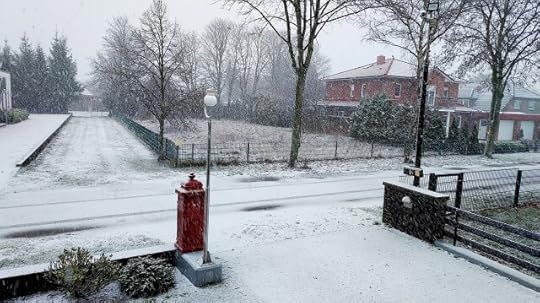
This is what my street looked like when I came home from Posthausen. Note how heavy the snowfall is.
When I made it home, it was still snowing. To my dismay, I discovered that the mail person had been there, while I was out and had stuffed a large envelope with a calendar I ordered from Amazon into the mailbox in such a way that half the envelope stuck out. The envelope was already soaked through, but luckily the calendar is salvageable.
The temperature was slightly above freezing, so I assumed the snow would quickly melt away and initially that’s what happened. But in the evening, there was more snow and because the temperature was below freezing by now, the snow was frozen as well. There’s more snow forecast for today, so it seems the snow will stick around for the weekend.
So that was how I spent the first three days of 2025. There will hopefully be more blogging in 2025, more interviews (since I didn’t do any of those in 2024), more toy photo stories, more roadtrips and of course the remaining parts of my adventures at the Church of Eternia holiday con in Hanau.
December 31, 2024
A handy guide to all SFF-related posts and works of 2024
I never felt particularly comfortable with eligibility posts, but I posted such an overview for the first time in 2016, when someone added my name to the Hugo Nominations Wiki. Eventually, it paid off, because I was a Hugo finalist for Best Fan Writer in 2020, 2021 and 2022 and won in 2022.
So if you’re interested in what I write, here is an overview of all SFF related blogposts of 2023, in chronological order, as well as a list of all the SFF and other fiction I published.
I separated the Masters-of-the-Universe-Piece Theatre Toy Photo Stories from the rest of the blogposts, because they are quite different from everything else.
That said, I have a shiny rocket on my shelf and there are many highly deserving fan writers who have never even been nominated, let alone won. Therefore, I’d like to ask to nominate some of those other great folks.
Finally, I know that there are people out there who don’t like me and don’t like what I have to say. That’s okay, no one has to like me and my work. But if you don’t like my work, just don’t read it. There’s no need to send harassment mobs my way.
And if you think you’re going to silence me, think again. Cause it’s not going to work.
At this blog:
The 2023 Hugo nomination statistics have finally been released – and we have questionsComic Review: Masters of the Universe: Forge of Destiny by Tim Seeley and Eddie NunezThe Revolution Will Be Televised: Some Thoughts on Masters of the Universe RevolutionReturn of the Son of the Bride of the Grimdark DebateThe 2023 Hugo Nomination Scandal Gets WorseMy Mom, Barbara Buhlert (1942 – 2024)An Open Letter to the 2024 Hugo Finalists, Whoever They May BeSome Comments on the 2023 Nebula FinalistsSome Thoughts on the 2024 Hugo FinalistsExploring the Hude Solar System (with Bonus Gothic Abbey Ruins)The Obligatory Birthday Post 2024 – with Bonus SkeletorJoin the Horde! Conquer the Universe! Sign Up Now!Cora’s Adventures at the Los Amigos Masters of the Universe Convention in Neuss or the Six Hundred Kilometer Roundtrip, Part 1: The Trip OutCora’s Adventures at the Los Amigos Masters of the Universe Convention in Neuss or the Six Hundred Kilometer Roundtrip, Part 2: The ConCora’s Adventures at the Los Amigos Masters of the Universe Convention in Neuss or the Six Hundred Kilometer Roundtrip, Part 3: The Road Home… and TecklenburgComic Review: Masters of the Universe Revolution Prequel #1 by Ted Biaselli, Rob David, Tim Sheridan and Daniel HDRSome Thoughts on the 2023 Nebula Award Winners – and Hamburg Traffic HellComic Review: Masters of the Universe Revolution Prequel #2 by Ted Biaselli, Rob David, Tim Sheridan and Daniel HDRThe 2024 July Short Story Challenge – Day by DayWe’re Having Hugo Drama… AgainComic Review: Masters of the Universe Revolution Prequel #3 by Ted Biaselli, Rob David, Tim Sheridan and Daniel HDRCora goes to the 2024 Worldcon in Glasgow, Scotland – plus bonus He-Man and TeelaBrief Worldcon Update – and a Fannish PoemCora Goes to Erasmuscon, the 2024 Eurocon in RotterdamSome Comments on the 2024 Dragon Award WinnersThe Guardian is Clueless about Masters of the UniverseInto the Heart of the Ruhrgebiet: Cora’s Adventures at the 2024 Toyplosion in Castrop-Rauxel, Part 1: The Trip Out and City ViewsInto the Heart of the Ruhrgebiet: Cora’s Adventures at the 2024 Toyplosion in Castrop-Rauxel, Part 2: The ConInto the Heart of the Ruhrgebiet: Cora’s Adventures at the 2024 Toyplosion in Castrop-Rauxel, Part 3: The Trip Home with Bonus Mineshaft Elevator TowerComic Review: Masters of the Universe Revolution Prequel #4 by Ted Biaselli, Rob David, Tim Sheridan and Daniel HDRA Baffled Guardian Writer Discovers the Autobahn – and the Best German Roadtrip SongsCora’s Adventures at the Church of Eternia Masters of the Universe Holiday Event in Hanau, Part 1: It’s Roadtrip TimeChristmas 2024The 2024 Darth Vader Parenthood Award for Outstandingly Horrible Fictional ParentsThe 2024 Jonathan and Martha Kent Fictional Parent of the Year AwardThe Complete Masters-of-the-Universe-Piece Theatre Toy Photo Stories:
Masters-of-the-Universe-Piece Theatre: “In Exile”Masters-of-the-Universe-Piece Theatre: “Puzzle”Masters-of-the-Universe-Piece Theatre: “Puzzle Expanded”Masters-of-the-Universe-Piece Theatre Halloween Special: “The Tomb of Sibor”At Galactic Journey:
“War is hell: Slaughterhouse Five by Kurt Vonnegut” and “A Tale of Two Wizards: The Face in the Frost by John Bellairs” in March 1969 GalactoscopeLife Beyond Conan: The Other Heroes of Robert E. Howard“Conan with a Metafictional Gimmick: Kothar, Barbarian Swordsman, by Gardner F. Fox” in The Men from Ipomoea (April 1969 Galactoscope)“A Five and Dime James Bond: Zero Cool by John Lange” in Strange Dreams (May 1969 Galactoscope)More Gems from the Pulps: Bran Mak Morn by Robert E. Howard and Jirel of Joiry by C.L. Moore“A Magical Mystery Tour: The Unicorn Girl by Michael Kurland” in Fun, Frivolity, and Flandry (November 1969 Galactoscope)West Germany Joins the Space Race: The Azur MissionElsewhere:
“An Open Letter to the 2023 Hugo Finalists, Whoever They May Be” in Zero Gravity Newspaper No. 14“Spector Creative Toy Controversy” in File 770.“Barkley — So Glad You (Didn’t) Ask #89, A Column of Unsolicited Opinions — Save the Retro Hugos: A Modest Proposal” with Chris M. Barkley in File 770.“Filers Meetup at Glasgow 2024” in File 770.“Fantastic Fiction: The Amazing and Fantastic Cele Goldsmith” in The Yesterday, Today & Tomorrow Blog“Fantastic Fiction: Knights versus Aliens: The High Crusade by Poul Anderson” in The Yesterday, Today & Tomorrow Blog“Today’s Birthday: Born December 7, 1915 — Leigh Brackett. (Died 1978.) in “Pixel Scroll 12/7/24 Get Your Scrolls Here, Just A Pixel Each” in File 770. “Fantastic Fiction: Early Science Fiction Meets Proto-Steampunk: The Time Machine” in The Yesterday, Today & Tomorrow Blog“Tanith Lee: Dark Mistess of the Weird” in New Edge Sword and Sorcery Magazine No. 3: Fall 2024“He-Man and She-Ra: A Christmas Special” in File 770.Podcast appearances:
“Readalong: God Save The Mark by Donald E. Westlake” in SFFAudio Podcast #776“Readalong: Zero Cool by Michael Crichton” in SFFAudio Podcast #777“Readalong: The Colorado Kid by Stephen King” in SFFAudio Podcast #779“Readalong: Lowdown Road by Scott Von Doviak” in SFFAudio Podcast #787“Readalong: The Weirwoods by Thomas Burnett Swann” in SFFAudio Podcast #792“Readalong: The Cave Girl by Edgar Rice Burroughs” in SFFAudio Podcast #796“Readalong: Return From The Stars by Stanis?aw Lem” in SFFAudio Podcast #798“SF Hall of Fame Stories Discussion Panel #5 ‘Microcosmic God’ by Theodore Sturgeon with Cora Buhlert, Bill Higgins and Gary Wolfe” in Postcards From a Dying World episode #143“SF Hall of Fame Stories Discussion Panel #8 ‘Mimsy Were the Borogoves’ by Lewis Padgett with Cora Buhlert and Brian Collins” in Postcards From a Dying World episode #156Fiction (SFF):
“Deer Stew” in 99 Fleeting Fantasies: A Fantasy Anthology, edited by Jennifer Brozek (flash fiction)December 30, 2024
The 2024 Jonathan and Martha Kent Fictional Parent of the Year Award
It’s the last day of the year, so we present to you, live from the Multiversal Nexus Ballroom, the winner of the 2024 Jonathan and Martha Kent Fictional Parent of the Year Award.
While I have been awarding the Darth Vader Parenthood Award for Outstandingly Horrible Fictional Parents for 44 years now, the Jonathan and Martha Kent Fictional Parent of the Year Award is a new prize that I only introduced in 2020 as a companion piece to the Darth Vader Parenthood Award. The 2020 winner may be found here, the 2021 winner here, the 2022 winner here and the 2023 winner here.
As for why I felt the need to introduce a companion award, depictions of parenthood in popular culture have been undergoing a paradigm shift in the past few years with more positive portrayals of supportive and loving parents and fewer utterly terrible parents. Personally, I believe that this shift is a very good thing, because the reason that I started the Darth Vader Parenthood Award in the first place is because I was annoyed by all the terrible parents in pop culture. For while most real world parents may not be perfect, at least they do their best. Maybe, the conditions that gave rise to the Darth Vader Parenthood Award will eventually cease to exist and we can permanently retire the award.
The bar is open for the adults, the play area and ball pit are open for the kids, and the kitchen is serving up delicacies from around Multiverse as well as the greatest selection of pastries and sweets found anywhere in any universe, so without further ado, let’s get started.
Warning: Spoilers for lots of things behind the cut!
So let’s give a big hand to all the good parents in pop culture that we have seen this year. As in the last four years, there were plenty of viable candidates and selecting the winner was a difficult choice.
So let’s have a brief rundown of the candidates who did not quite make it, but still deserve an honourable mention:
The Star Wars Universe has been a reliable source of parent figures both good and bad over the years. In 2024, Star Wars gave us two or rather three positive parents figures. The Acolyte may have fallen victim to the Culture Wars and while the usual suspects claimed to hate everything about it up to visible explosions in space (even though explosions in space in Star Wars have only been a thing since 1977) and an obscure Jedi council member being older than previously assumed, the one thing that really got them railed up was the existence of a coven of lesbian witches of colour manipulating the Force to make babies, cause manipulating the Force to make babies should only be reserved for white men like Senator and future Emperor Palpatine. But whether you like The Acolyte or not, one cannot argue that Mothers Aniseya and Koril do love their twin daughters Mae and Osha. They’re certainly better parents than the Jedi who come to take the force sensitive girls away, but then the Jedi are pretty terrible at raising kids as shown by the number of Jedi going off the rails and over to the Dark Side.
Meanwhile, Skeleton Crew, the most child-friendly Star Wars show since the nigh forgotten Ewok movies of the 1980s, not only seems to delight pretty much everybody, but also gave us a great reluctant father figure in Jod Na Nawood (played by Jude Law), who may be a Jedi or may be a pirate or may be both and unexpectedly finds himself in charge of the four runaway kids Wim, Fern, KB and Neel. However, Skeleton Crew is still airing and Jod Na Nawood’s story isn’t over, so he’s probably a better potential candidate for 2025.
The animated movie The Wild Robot seemed to come out of nowhere, at least to me (it’s apparently based on a popular children’s book, for which I’m not the target audience) and gave us Rozzum Robot Unit 7134 a.k.a. Roz (clever name choice) who goes rogue and becomes the loving adoptive mother of a gosling named Brightbill.
The anime series Spy x Family has been delighting audiences around the world for a few years now and in 2024 even received a movie version called Spy x Family: Code White. And while Loid Forger a.k.a. the master spy codenamed “Twilight” and his pretend wife Yor a.k.a. the assassin “Thorn Princess” certainly never plan to become good parents for the telepathic orphan Anya, whom Loid adopts to get close to his target via an exclusive school, they nonetheless are. Suggested by Juan Sanmiguel.
The so-called “Arrowverse” of DC superhero shows airing on the US TV network The CW not only consistently blew the DC superhero movies out of the water, but also gave us plenty of great and loving parent figures. Alas, The CW is being retooled into a channel for shitty reality programs courtesy of Warner Bros Discovery‘s CEO and real-life supervillain David Zaslav, and all the superhero shows have been cancelled along with everything else. The last one standing, Superman & Lois, ended its run a few weeks ago and went where Superman adaptations rarely go and showed up Clark Kent and Lois Lane as a happily married couple and loving parents of teenaged twins Jonathan and Jordan Kent. Clark and Lois would certainly have been great candidates for the Jonathan and Martha Kent Fictional Parent of the Year Award, except that they actually get to enjoy Martha Kent’s famous apple pie, whenever they want to, so let’s give someone else a chance.
Talking of Jonathan and Martha Kent, they also continue to be great parents to Clark over in My Adventures with Superman. In season 2, we also got a glimpse of Clark’s birth father Jor-El doing his best to be a good father, even if he’s only a hologram, and also delved into Lois’ troubled relationship with her father General Sam Lane, who falls into the “gray parent, who’s neither good nor bad, but tries their best” category.
Our 2021 winner, Duncan a.k.a. Man-at-Arms returned in Masters of the Universe: Revolution. Though now promoted to Lord Duncan and Man-of-War, he nonetheless continued to be a supporting father figure for Adam, who really needed one, having just lost his own father, as well as for Teela, Andra, Orko, Cringer and Gwildor. Duncan would have been a most worthy winner this year as well, except that he already got a bite of pie (quite literally), so it’s time to honour someone else.
To remain on Eternia for a moment, King Randor narrowly scraped past winning the Darth Vader Parenthood Award in 2021 due to his treatment of his son Adam. He does redeem himself somewhat in Masters of the Universe: Revolution and tells Adam on his death bed that he loves him and is proud of him. Of course, Randor also tells Adam that he must give up being He-Man when he becomes king, which leads to a whole lot of problems down the line, but he at least tries to be a better father in his final weeks/months than in the roughly twenty-five to thirty years before.
What is more, the Masters of the Revolution cartoon gave us a few glimpses of the childhood of Randor and his older brother Keldor and the prequel comics gave us even more insight into their childhood, from which we learn that even though Randor wasn’t always a great father, he was a much better parent and king than either his father Miro or his grandfather Rannen. Because Randor seems determined not to repeat his father’s mistakes and thus breaks through the intergenerational cycle of abuse in which his father was trapped and which completely consumed his brother Keldor. It’s not enough to win Randor the Jonathan and Martha Kent Fictional Parent of the Year Award, but we should recognise that he at least tries to do better.
While we’re at it, we should also give a shout-out to Queen Marlena, who – unlike her husband – always was a loving and supportive mother to Adam. And after Randor succumbs to a mysterious illness in the first episode of Masters of the Universe Revolution, Marlena – though in mourning herself – continues to support her son who has to deal with the dual responsibility of being He-Man and King of Eternia, while mourning his father, and then has to deal with his long-lost uncle showing up as well.
There’s a scene where Skeletor throws Adam, Cringer and Marlena into the royal dungeon. In this moment, Adam is at his lowest point. He has been cut off from the Power of Grayskull and doesn’t have his sword, he’s been thrown into his own dungeon, Skeletor is on the throne, his people have been turned into cyborg slaves and the Horde has occupied Eternia and Castle Grayskull. Adam blames himself for everything – not without reason. This is when Marlena gives him a pep talk and tells him that he doesn’t need the sword or the Power of Grayskull to be hero, that Adam and his enormous courage are enough.
Queen Marlena would surely be a most worthy winner of the Jonathan and Martha Kent Fictional Parent of the Year Award and she may well win one day, but not today, if only because she doesn’t have a lot of screentime in Masters of the Universe Revolution and there’s another viable candidate who has been deserving of this award for a long time now. Nonetheless, let’s give a big hand to Queen Marlena of Eternia.
Applause erupts around the auditorium. Queen Marlena, who is sitting in the front row, clad in an elegant black gown with gold embroidery – she’s still in mourning, after all – graciously waves like the queen that she is. Duncan is sitting next to her, still clad in his shiny Man-of-War armour. Lyn is sitting on Duncan’s other side, also still clad in the striking blue and purple gown she wore yesterday, and we can’t help but notice that she and Duncan are very cozy with each other. Marlena noticed this as well and smiles to herself, but then she’s always been a very perceptive woman.
Now we’ve got the honourable mentions out of the way, it’s time to get to the main event, namely the winner of the 2024 Jonathan and Martha Kent Fictional Parent of the Year Award.
This year’s winner is another character who probably should have won long ago, except that a) there was no Jonathan and Martha Kent Fictional Parent of the Year Award until 2020, and b) I wasn’t aware of this character at the time when he would have been a suitable winner. And indeed, this year’s winner was the first character a third party ever suggested to me (or rather demanded to know why this character had never won). Well, as I said before, I can’t award a character, if I don’t know they exist. However, sometimes a new season, a sequel or – as in this case – a remake give me the chance to honour a character who was originally overlooked.
Therefore, I am thrilled to announce that the winner of the 2024 Jonathan and Martha Kent Fictional Parent of the Year Award is none other then…
Drumroll
General Iroh of the Fire NationVoiced by Mako and Greg Baldwin in the animated series Avatar: The Last Airbender and played by Paul Sun-Hyung Lee in the live action remake (which is what made him eligible for the award), Iroh is the firstborn son of Fire Lord Azulon and heir apparent to the throne. He is a skilled firebender and brilliant miitary strategist. As General of the Fire Nation’s forces, he distinguished himself by claiming to have killed the last dragon in the world (spoiler alert: he didn’t), which earned him the nickname “the Dragon of the West”, and also besieged Ba Sing Se, the capital of the Earth Kingdom for one hundred days, because he believed he was destined to conquer the city (he was, though not in the way he thought).
Even though his military campaigns took him away from home a lot, Iroh was a loving father to his only son Lu Ten and also had a close relationship with the children of his younger brother Ozai, Zuko and Azula. Tragedy struck, when Lu Ten was killed in action during the siege of Ba Sing Se. Though he’s never been as war-hungry as his grandfather, father and brother, Iroh was a changed man after the loss of his son, becoming more philosophical and contemplative. He did not contest his brother’s ascendance to the throne of the Fire Lord, but instead focussed on being a supportive mentor and father figure to his hot-headed nephew Zuko. When Fire Lord Ozai banished his own son Zuko and forbade him from returning until he had captured the Avatar, a task considered impossible, since the Avatar had vanished after an unfortunate encounter with an ice berg one hundred years before, Iroh followed Zuko into exile and continued to mentor and support his nephew.
Iroh is the one person who is responsible for Zuko not following in the genocidal footsteps of his great-grandfather, grandfather and father, but finding his own path, a better path. Iroh also served as a mentor to the young Avatar Aang and his motley collection of friends Katara, Sokka, Toph and Suki. Later, after his ascendance into the Spirit World, Iroh even mentored young Korra*, Aang’s successor as Avatar.
Iroh is the supportive uncle we all wish we had and therefore we name him a most worthy winner of the 2024 Jonathan and Martha Kent Fictional Parent of the Year Award.
ApplauseApplause erupts around the auditorium. Iroh hugs Zuko, who’s sitting next to him and munching on a skewer of chicken satay, and then ascends to the stage, clad in his customery plain brown robes and still holding the ugly vase that his brother Ozai received in absentia as winner of the 2024 Retro Darth Vader Parenthood Award the night before.
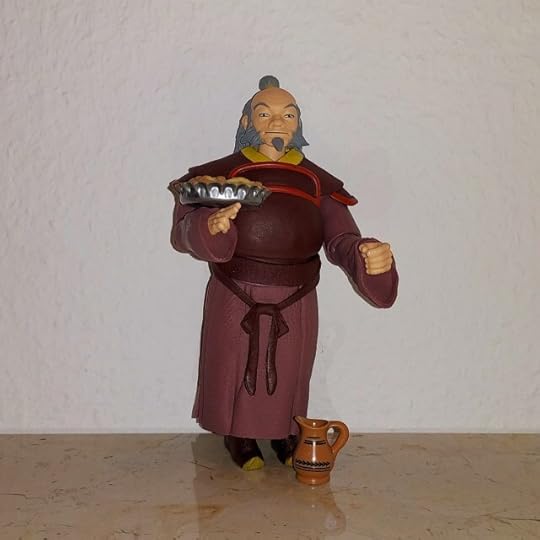
General Iroh accepts his award. This time around, the pie is a dollhouse miniature.
Iroh bowed and held the following speech:
Thank you. Thank you for this great honour.
Honour is very important to my people, the Fire Nation. However, we view honour almost entirely in terms of military honour and valour. This is wrong, for there are many kinds of honour that have nothing to do with war.
One of the greatest honours a person can have is to raise and mentor the next generation. For our children are our greatest wealth, greater than all the treasures of Ba Sing Se.
A single tea runs down Iroh’s cheek.
I had a son once, Lu Ten. He was the sweetest, gentlest boy you can imagine. As he grew older, he wanted to follow in my footsteps and became a soldier just like me. But war has a way is taking away all that makes life worth living and so the Siege of Ba Sing Se took my son and also all the light from my life.
However, life gave me a second chance and so I did my best to be the father and mentor to my nephew Zuko that my brother Ozai couldn’t be and to show him that his father’s path, the path of war and destruction, isn’t the only path. Over time, my nephew Zuko grew into a fine young man and the first Fire Lord of true honour in four generations.
Iroh looks straight at Zuko.
I’m proud of you, boy. You found your own path and have displayed true wisdom and honour.
But life also placed other young people in need of guidance into my path. The young Avatar Aang, Katara, Sokka, Toph, Suki. Lovely young people one and all. It has been an honour to mentor them.
“This is the way,” 2020 winner Din Djarin, who is sitting in the front row, exclaims. Meanwhile, Grogu, who’s sitting on his lap, uses the Force to help himself to some cod roe sushi from a passing waiter’s tray.
My only regret is that I was not able to save my niece Azula from her father’s darkness like I saved Zuko. This is one failure I must live with, just as I most live with losing my son to a senseless war.
You may wonder, honoured audience, why I carry around the ugly vase that Zuko and I were given as a reminder of my brother Ozai’s utter failure as a father and a human being. It is exactly for this reason, to remind myself of how my brother squandered the greatest gifts he was given, his children, that I am keeping this vase and will put it in a place of honour in my tea house in Ba Sing Se.
Because our children are our greatest treasure and raising them to become good, honourable people is the greatest honour of all. Thank you.
Iroh bows and accepts his award, one of Martha Kent’s famous apple pies. “This looks most delicious, my dear lady,” Iroh says politely to Martha, “I am sure it will go perfectly with a nice cup of tea.”
Martha smiles at Iroh. “Well, in Kansas we prefer coffee, but I’m sure my pie will go wonderfully with tea as well.”
Zuko leaps up to the stage and hugs Iroh again. “That was a great speech, Uncle. And you’re a much worthier winner than Father.” Zuko spots the pie and helps himself to a slice. “I’m so hungry and this looks delicious.” He takes a bite. “Yum, it tastes delicious as well.”
Iroh sighs. “Zuko, you can’t possibly still be hungry after everything you ate last night and today.”
Martha smiles. “Oh, these young men are always hungry. Just like my Clark.”
The 2023 winner Master Splinter ascends the stage to congratulate his successor. “You’re human and I don’t like humans,” Splinter says, “But you’re also a father and a martial artist like the Master Jackie Chan and I respect that.”
“I am afraid I am not familiar with this Master Jackie Chan, but I would like to know more.”
“So they don’t have videotapes of Jackie Chan’s exploits where you come from? Inconceivable. You should visit us in our sewer lair and I will show you some tapes.” Splinter look at Zuko, who is stuffing his face with apple pie. “That’s a good boy you have there. I have four myself.”
“Four sons! You truly are blessed.”
Splinter nods. “Here they come.”
At this moment, Leonardo, Raphael, Donatello and Michelangelo storm the stage and introduce themselves to Zuko.
“Hey, guys, it’s one of those sweet pizzas again. Those are sooo good.”
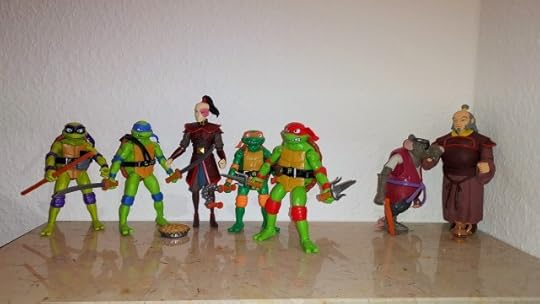 Iroh sighs. “I guess I will not get to enjoy my own pie. But maybe I could interest you in a nice cup of tea, Master Splinter. And you of course as well, my dear Mistress Kent.”
Iroh sighs. “I guess I will not get to enjoy my own pie. But maybe I could interest you in a nice cup of tea, Master Splinter. And you of course as well, my dear Mistress Kent.”
“That sounds lovely,” Martha Kent replies, “And just between us, I always bake a spare pie, because I know how hungry young people can be.”
Meanwhile, Din Djarin, carrying Grogu in his arms, has walked over to Duncan, Lyn and Marlena.
“Excuse me, but that armour is most impressive.”
“Thank you,” Duncan replies, “Yours is very impressive as well.”
Din leans forward to examine Duncan’s armour. “Is that Beskar?”
“No, Eternium with some corodite reinforcements.”
“Fascinating.”
While Din and Duncan geek out about their respective armour and are soon comparing stats and designs, Grogu uses the Force to help himself to a deviled egg from passing waiter’s tray.
“Well, aren’t you the sweetest little boy!” Marlena exclaims, “May I hold him?”
Din nods and hands Grogu off to Marlena, who bounces him on her lap, ignoring the fact that Grogu just snagged a smoked salmon canapé.
Lyn leans over and asks, “Are you practicing for grandchildren?”
Marlena sighs. “If only. But Adam and Teela are.. well, they’re a little slow.”
“Tell me about it.”
***
Since everybody is happily chatting and eating, it’s time to conclude our live broadcast of the 2024 Jonathan and Martha Kent Fictional Parent of the Year Award. Who’ll win next year? You’ll find out in this space.
Disclaimer: I don’t own any of these characters, I just gave them an award and wrote acceptance speeches for them. All characters and properties are copyright and trademark their respective owners.
*When spelling out my name, I’ve always had to explain that my first name is “Cora with a C”. However in recent years, I’ve also had to explain that my first name is spelled with only one R, unlike the lead character from Avatar: The Legend of Korra.
December 27, 2024
Christmas 2024
It’s been a while since I did a Christmas post, because in the past few years I was either busy with work and holiday preparations or sick on Christmas or both.

Holiday He-Man and She-Ra wish everybody a Merry Christmas and Happy Holidays.
Initially, it seemed as if Christmas 2024 wouldn’t be much better, since I was busy with translation work well into last week. I also wasn’t feeling well, got tired very quickly and my blood pressure was way too low, leaving me feeling woozy. Low blood pressure and feeling woozy was a massive issue in my teens, which somewhat improved in adulthood, but still recurs on occasion, often dependent on the weather.
But before we get to the meat of the post (literally in one case), here are some links to other recent posts by me. For a seasonal starter, I revisit the 1985 He-Man and She-Ra Christmas Special at File 770. Also for File 770, I wrote a piece to commemorate the birthday of Leigh Brackett. At Galactic Journey, I reviewed The Unicorn Girl by Michael Kurland and wrote about (West) Germany’s first ever satellite, Azur, which launched in November 1969. I’m also writing for the Yesterday, Today & Tomorrow Blog of the 2025 Seattle Worldcon on occasion and have written about legendary editor Cele Goldsmith Lalli, the 1960 science fiction novel The High Crusade by Poul Anderson and the 1960 movie The Time Machine so far. Finally, I’ve also got an article called “Tanith Lee: Dark Mistress of the Weird” out in issue 3 of New Edge Sword and Sorcery, though my copy hasn’t yet reached me.
Back to the holidays: 2024 is also the first Christmas with both my parents gone. Last Christmas, my Mom was still alive, though in a nursing home and in an increasingly bad condition, bedridden and unable to even get into a wheelchair. So 2023 was actually the first Christmas I spent all alone. I visited Mom in the nursing home, of course, but that was just a short visit since she tended to fall asleep after half an hour or so.
There’s something of a stigma about spending Christmas, particularly Christmas Eve, which is the main event in Germany, all alone. It’s considered a very sad thing to spend Christmas Eve alone and there are meet-ups for people who’d otherwise spent Christmas alone organised by churches and charities. I briefly considered going to one of those meet-ups, but then I realised that I didn’t want to. First of all, it wouldn’t be a proper Christmas Eve for me, because even though there would be other people, the food would be all wrong and it just wouldn’t be the kind of Christmas I enjoy. There also are platforms which connect people who want to host a Christmas Eve or Day dinner with people who’d like to attend. Once again, I considered this and then decided against it, because while I wanted to make my personal holiday foods, I didn’t necessarily want to feed strangers. Plus, inviting strangers into the house would mean extra work such as cleaning, whereas if I’m alone and the floor isn’t spotlessly clean, who’ll care except for me? Besides, I actually like my own company.
Initially, I also wondered whether to bother with a tree or decorations. But then I actually put up quite a lot of decorations, including things my Dad wouldn’t have liked like illuminated window decorations. Because my Dad didn’t care for Christmas lights or decorations at all. It usually took asking several times until he could be bothered to put up decorations I couldn’t put up myself like the star in the front window. This time around, I just asked a tall and fit neighbour to do it for me and he did.

This illuminated star, here pictured with the snowy garden, is one new decoration I got for myself, because Dad didn’t like putting things in the window.
So in short, now that I’m alone and no longer beholden to other people (though I would of course prefer having my parents back in the sort of good health they both still had in 2020/21), I could decide what sort of Christmas I want to have, what sort of decorations, food, etc… I also decided that I wanted a tree anyway, because though Christmas trees are a lot of work, they also bring joy. Though my tree is a little shorter than the ones we used to have and I decided to ditch the live candles that my Dad insisted on adding to the tree, because frankly I find live candles too dangerous and decorating the tree is a lot more fun, if you don’t have to worry about accidentally setting it on fire. Besides, not every tradition needs to be kept. I have more lights in my home for Christmas than ever, but not a single live candle, because live candles are too much of a fire hazard for my taste and modern LED candles look just as nice.
As for food, I decided to stick with our traditional holiday dishes, though scaled down for one person, which isn’t always easy, especially with older “feed a regiment” recipes. For example, for our traditional Christmas Eve lunch – grilled venison with red cabbage, apple cranberry sauce and some pasta to soak up the sauce – I ditched the venison (though I like it) and the red cabbage (though – again – I like it) and just kept the sauce and the pasta, because the sauce is actually what makes the dish special. Besides, there’s no law to say that I can only have venison and/or red cabbage on Christmas. I can have both whenever I want to.
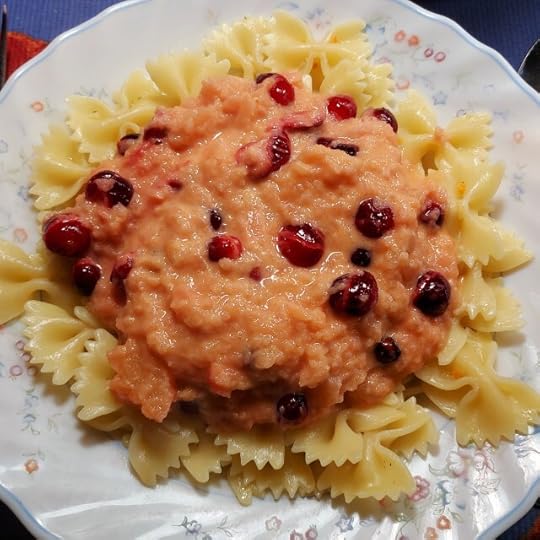
Pasta with apple cranberry sauce. Tha sauce is amazing and IMO doesn’t need the venison or red cabbage to shine.
Grandma Buhlert’s famous herring salad (the recipe for which I shared at The Skiffy and Fanty Show several years ago), which we traditionally have for dinner on Christmas Eve (and Christmas Day and Boxing Day and however long the bowl lasts, often up to New Year’s Eve), poses another problem. Grandma’s original recipe produces enough salad to feed a regiment. I’ve scaled it down over the years and scaled it down again this year, but there are some hard limits. For example, the recipe calls for a celeriac root and celeriac roots are big. Even if you buy the smallest one you can find on the market, it’s still big. Sometimes, we would just use half the root for the herring salad and use the other half to make celeriac salad, but the last thing you want when you’re making a lot of salad is even more salad. So the ratio of celeriac to the other ingredients gradually crept up, simply because celeriac is the most difficult to scale down. Boiling a celeriac root also takes forever, even in a pressure cooker (and Christmas is the only time I use pressure cooker and I inevitably curse the damned thing). This year’s celeriac root is a bit crunchier than usual – I guess I should have boiled it even longer – but otherwise the salad came out fine. Last year, I took a small pot of it to my Mom at the nursing home BTW, even though the nurses didn’t want her to eat solid food and insisted on pureeing everything.

Grandma Buhlert’s famous herring salad. The bright magenta colour comes from beetroot.
The sailor’s curry we traditionally have on Christmas Day was the least problematic, because you can easily freeze leftovers. Though I did scale it down last year and even more this year and it’s still enough to eat on Boxing Day as well, which means that I don’t have to worry about Boxing Day lunch as well. Though Boxing Day was usually the one holiday meal slot that was up for grabs and varied the most. When I was very small, it was often Chicken Fricassee (which I found bland and boring, though I might like it more today). Then, we had French style roast rabbit, because my Grandma gifted her stepdaughters a rabbit every holiday season. Grandma hailed from Moritzburg near Dresden and roast rabbit for Christmas is an East German thing. I actually have Mom’s recipe for the roast rabbit and may give it a try eventually, since I remember liking it. Even later, it became Boeuf a la Mode (which I actually quite liked, especially the way my Mom made it, which included currants and olives – and yes, I have her recipe) or Coq au Vin (which I also like). In recent years, once I took over the holiday cooking duties, I mostly made some kind of Cajun dish – Crawfish Etouffee, Shrimp Creole, Gumbo, whatever ingredients were available. But since the curry is enough for two days, I can enjoy it on Boxing Day as well and just have my Cajun food or Boeuf a la Mode or Coq au Vin or roast rabbit some other day. Not Chicken Fricassee, though. I looked up recipes and it still sounds bland and boring to me. Half the recipes had titles like “Chicken Fricassee just like Mom’s”, so apparently everybody’s Mom made this dish at some point, though other people clearly have fonder memories of it than me.
Of course cooking requires shopping. I hate crowds, so I tend to go grocery shopping either very early in the morning, just after the shops open, or in the evening just before closing time. A lot of ingredients could also be bought ahead of time, but some – particularly the pork for the curry and the salted herring for the herring salad – can only be bought just before Christmas Eve. I had planned to buy the foods that don’t keep well on Monday morning and everything else on Friday early in the morning, so I wouldn’t have to go out on the weekend and could do other things – clean the house and the living room, etc… – that needed to be done. However, it turned out that the one grocery store that usually carries them didn’t have fresh cranberries on Friday, but maybe they would get them in again on Saturday. So I set off again on Saturday – while not feeling well at all – and even drove to the big Edeka store in Delmenhorst to get fresh cranberries, only that they didn’t have any either. The nice lady stocking the shelves even checked the warehouse. So that meant trying once more for cranberries on Monday or use dried cranberries for the apple cranberry sauce.
Another unexpected issue was the pork for the curry. Normally, this shouldn’t have been an issue at all – I’d just send an e-mail to my local neighbourhood butcher, preorder the pork and pick it up on Monday. Alas, when I sent off my e-mail last Wednesday, I got a reply that they didn’t accept anymore preorders at this late date (since when is a week before Christmas late?), but that I could come to the store and buy it there. So I got up really early on Monday morning – in spite of still feeling sick and woozy – to make it to the butcher at opening time to beat the crowds. The butcher opens at 7:30 AM. I was there at 7:32 AM and not only had a war broken out on the parking lot – which is way too small for the shop – but the line was already around the building and all the way to the bakery next door. Apparently, lots of other people had the same idea. And the line didn’t move briskly, because many people take forever at the butcher, because it’s always five slices of this and five slices of that and ten different types of sausages and cheese and salad (which the butcher sells as well) and whatnot. Now note that I was feeling woozy and my blood pressure was already low, so spending twenty minutes or half an hour or more standing in line was out of the question, because I know that standing for extended periods completely wrecks my blood pressure. And I certainly didn’t fancy collapsing at the butcher shop on the day before Christmas.
So I drove onwards to get the herring and the cranberries (and this time around, they actually did have fresh cranberries) and thought I’d come back to the butcher afterwards, when the crowds had dispersed a little. I assumed many people had come before work to pick up the meat supply for the holidays and things would look better at 8 AM or later. Meanwhile, the butcher counter at the grocery store was completely empty – no line at all. I briefly considered just buying my pork there, but then I took one look at what the butcher counter at the grocery store called “filet of pork” and decided that I didn’t want it. Besides, whenever my parents caved in and bought the pork for the curry at a grocery store, we later regretted it. Chicken and turkey are perfectly fine to buy at the grocery store – pork is not and neither is beef. So nope. I wanted good curry, so I needed good pork. So I returned to the butcher shop after finishing my other grocery shopping and found that the line had gotten even longer. Frustrated, I drove back home and decided to try again around noon, when all of those people waiting in line were hopefully at home having lunch or at work or wherever. Anywhere as long as it wasn’t waiting in line at the butcher.
By noon, the line was a little shorter. Still snaking out of the door, but no longer all the way to the bakery. So I got in line and was visibly grumpy, which apparently annoyed some of the other customers. Meanwhile, people who had preordered – which I had tried to do – could just go through. At one point I said to an employee, “Well, I tried to preorder, but you wouldn’t let me.” – “Well, you have to be early enough.” – “I tried to preorder a week before Christmas.” – “Oh, that’s much too late. We stopped accepting preorders four weeks ago.” – “Well, maybe I should preorder for next year then, since I’m here already”, I said snarkily.
You may be wondering why this particular butcher shop is such a mess and so overcrowded. There are two reasons. For starters, stand-alone butcher shops are becoming increasingly rare in Germany. They have problems finding apprentices, are struggling with regulations and bureaucracy and neighbours not wanting “that sort of business” next door, though they’re happy enough to buy the products, plus the supermarkets are cutting into their customer base. The second reason is that this particular butcher shop has been consistently ranked as one of the best in all of Germany in the past few years, which means that there were people waiting in line from as far away as Hamburg. As if you couldn’t find a good butcher somewhere in Hamburg, a city of 1.4 million people.
Not that I begrudge the butcher their success – and besides, the meat really is good. However, this is my neighbourhood butcher. They opened a year after I was born and I have literally been going there since forever. I remember how the shop looked before it was all snazzy and modern, long before it was officially one of the best butcher shops in Germany. I remember when the grey-haired ladies behind the counter were fresh-faced apprentices. I am one of the original customers and yet I get treated like crap, while some people from Hamburg, who couldn’t even find Seckenhausen on a map, get preferential treatment, because they preordered five weeks ago.
I wasted twenty-five minutes standing in line at the bloody butcher and once it was my turn, I was out of the shop in maybe three minutes. The guy who was in line before me took longer to get all his umpteen purchases than I took to get my six hundred grams of filet of pork. Anyway, it seems that next year I will either have to preorder a month before Christmas or find myself another butcher. Which is a pity, because I have been a customer there for much longer than those people from Hamburg – and they looked like wealthy jerks from Hamburg, too.
Once I made it home from the butcher’s, my neighbour (the same one who put up my Christmas star in the window) set up the tree in the living room, because it would have been too heavy for me to carry it inside. We always had a natural tree and though I considered getting an artificial one, none of the ones on offer really did it for me, so a natural tree it was. It’s a Nordmann fir, because pretty much all commercially sold Christmas trees in Germany are, though personally I prefer regular firs.
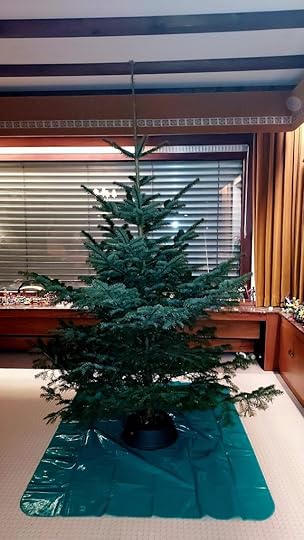
The undecorated Christmas tree in the living room.
Because my blood pressure was still too low, decorating the tree took longer than it normally would. And after I was finished, I was so tired that I just went to bed.
On Christmas Eve (which is the main event in Germany), I got up fairly early to chop up the last ingredients for the herring salad and make the apple cranberry sauce. In previous years, I also baked a cake for the holidays, but I decided not to do that this year, because I have plenty of cookies and a cake just for me would have been too much. My blood pressure was also still way too low and I was exhausted, so after lunch I just laid down for an extended afternoon nap.
Now the way Christmas Eve in Germany usually works is that there is coffee and cookies or cake in the afternoon. Some people attend a church service in the afternoon, others go to midnight mass and some don’t go to church at all. After the afternoon coffee and church, if applicable, the tree is lit and duly admired. Depending on the family there is singing, poems are recited or the Nativity from the Gospel of Luke is read out. Then the presents are opened. Afterwards, there is dinner (some families also have dinner before opening the presents, but that’s cruel to young children) and then the family hangs out, tries out new presents, drinks a glass of wine or beer or whatever they prefer. In recent years, the present opening has crept ever earlier into the afternoon to the point that some families are opening present directly after lunch. I’m not a fan of torturing kids by making them wait forever, but the kids can handle some waiting and opening presents before it’s dark is way too early IMO. Besides, keeping the kids occupied and out of the way until it’s time to open presents is the reason why Christmas TV specials are broadcast in the afternoon and also why the first church service of the day is very child-friendly with a nativity play put on by older kids, etc… Honestly, if I had impatient kids at home, I’d send them to the child-friendly Christmas service, because it’s a lovely experience, and IMO children should at least know why they’re celebrating Christmas.
I’d set my alarm for late afternoon to have my cookies and coffee, but when it went off, I still felt woozy and not well, so I snoozed for another half hour or so. After all, I was all alone and no one cares if I have my herring salad at eight PM or when I light up my tree. When I finally did get up around six PM, I still felt woozy and my blood pressure was still low. I didn’t feel like having dinner just yet, so I made myself a coffee and a cookie platter. And then a minor Christmas miracle happened, because after I’d eaten the cookies and drank the coffee, I suddenly felt a lot better and my blood pressure evened out, too. So maybe I just needed caffeine or sugar or both.

Holiday cookie platter, featuring clockwise from the top, spelt cookies, chocolate cookies, nut kipferl, almond cocoa cookies, brown cookies (North German specialty), gingerbread triangles and in the center Spekulatius and black and white coffee cookies.
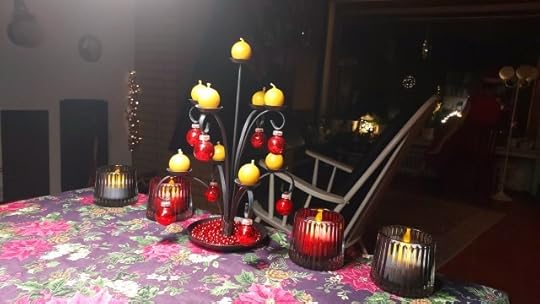
This Scandinavian modern wrought iron candle holder dates from the 1960s and adorns my dinner table along with some glass votice candle holders.
So I retreated to the living room, switched on the tree and the various LED votive candles in decorative candle holders scattered around the room. Normally, I’d sit with my parents, sip wine, listen to holiday music on CD and open presents. When I was a kid, I also used to recite holiday poem in front of the Christmas tree, while my parents took pictures, but I haven’t recited a poem in years. We also used to sing Christmas songs as a family, but we eventually stopped, because we all are blessed with terrible voices and realised that we all hated it. One tradition we kept, however, was the reading of the nativity story from the gospel of Luke. This tradition started when I won a reading contest in school in sixth grade and just kept going. I always read the nativity story from an old Bible of my maternal grandmother’s printed in blackletter font and stuffed with all sorts of paper ephemera such as ancient church programs and the Seneca quote Mom wanted on her death announcement in the newspaper, because that only that old Bible had the German translation that everybody knows, not the modernised version, which I don’t like. As Bible translations go, I’m a traditionalist. Whenever I need the English version of a specific Bible verse (it happens occasionally when you’re a translator), I tend to go with the King James Bible.
Last year, I took the old Bible to the nursing home and read the nativity story to Mom in her bed. This Christmas Eve, I was all alone, but I still got the old Bible from my Mom’s nightstand drawer, where it’s kept, and read the nativity story to an empty room. Except that it wasn’t really empty, because my Playmobil nativity and a sizable part of my Masters of the Universe collection are currently there. So I read the nativity story to a bunch of toys and it only felt a little weird.
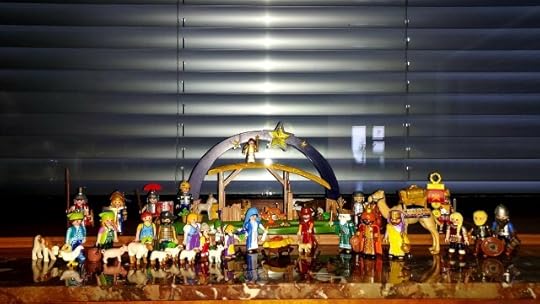
My Playmobil nativity, complete with Roman soldiers directing the traffic and a lot of farmer women and their animals as well as the more traditional players.
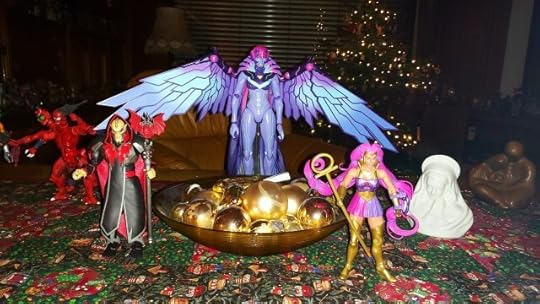
“Have yourself a merry little Hordemas” – The Masters of the Universe Masterverse Motherboard action figure is so big that she only fits on the living room table. And when the time came to redecorate the living room for Christmas, I decided to just leave her there and added some other members of the Evil Horde to hang out with her.
Then I made myself some Christmas punch (the alcohol-free version of mulled wine) and put We Wish You a Merry Christmas by the Ray Conniff Singers into the CD player. Now one thing you should know about traditional German Christmas music is that it’s terrible. The songs sound like funeral dirges and are usually performed by choirs or Schlager singers. Nowadays, you have alternatives such as the various pop Christmas songs, but when I was a kid, these terrible German Christmas songs were all there was. And even today, the radio stations still play this crap on Christmas Eve starting just after noon, because people apparently demand it. I call it the terror of Besinnlichkeit. The closest English term is “contemplation”, but it doesn’t quite hit the point. Basically, “Besinnlichkeit” means Christmas being quiet and austere and depressing. Personally, I suspect it’s a conspiracy of the Germanic pagans of yore to make Christmas Eve in Germany as depressing as possible.
However, when I was a kid we had two vinyl Christmas albums that my Dad brought back from the US. One was a Bing Crosby/Frank Sinatra album, which sadly was interrupted by a lot of talking from Bing and Frank (Guys, I want to hear you sing, not talk), and the other was We Wish You a Merry Christmas by the Ray Conniff Singers, first released in 1962. For years, this was literally the only Christmas album we had that wasn’t German terror of Besinnlichkeit stuff, so we pretty much listened to it on an endless loop during afternoon advent coffees and on Christmas Eve. Eventually, we got a CD player and other Christmas albums like the two CD Rock Christmas set which has most of the 1970s and 1980s pop holiday songs, Elvis Presley’s Christmas album and some country music Christmas compilations my Mom picked up at the discount store superceded the Ray Conniff Singers, especially since our vinyl record player no longer functioned reliably. And then three years ago, I bought our old Ray Conniff Singers Christmas album on CD, so we could all listen to it again.
Listening again to that album as adult, I’m struck by the fact that the songs on the album are mostly the English version of the sort of traditional Christmas carols that I dislike so much in German – “Little Drummer Boy”, “Let It Snow” and “Count Your Blessings Instead of Sheep” are the two newest songs and they date from 1941, 1945 and 1954 respectively. However, English language Christmas carols are cheerier in general and Ray Conniff’s arrangement and the performance of his group make them sound fresher and a lot more fun than the depressing German Christmas dirges.
There were no presents to open, because while I had declared books and toys delivered just before the holidays “Christmas presents”, I didn’t bother to wrap them. The closest thing to proper presents I got were a bag of homemade holiday cookies from one neighbour and a bag with chocolate and a bottle of wine from another and those didn’t need unpacking either.
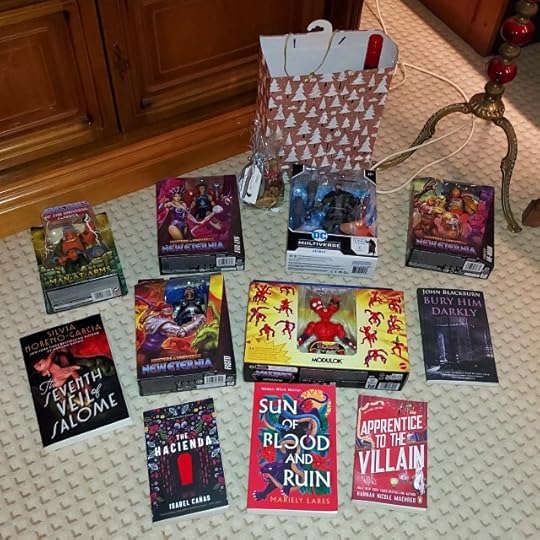
This year’s “Christmas presents” include various toys and books which happened to arrive shortly before Christmas as well as two nice goodie bags from my neighbours.
So I just sat in the living room, sipped Christmas punch and listened to the Ray Conniff singers. And it was good.
Of course, I also took some pictures of my tree and decorations.

A view of the full Christmas tree.
As I’ve undoubtedly explained before, my Christmas tree is basically a legacy tree with the oldest ornaments dating back to the 1960s, when my parents bought them as newly-weds. There were new ornaments added almost every year – sometimes as gifts, sometimes bought – while occasionally older ornaments were cycled out, because they broke (it happened, even if you’re careful) or because we no longer liked them or – for gifts – never liked them in the first place.
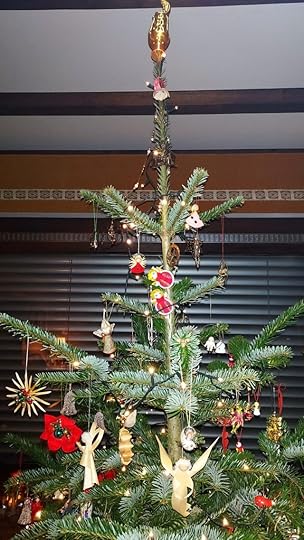
A close-up view of the top of the Christmas tree, where most of the vintage ornaments of my parents are. They date from the 1960s and are incredibly fragile. Near the top you can also spot a Santa head ornament I made from a seashell when I was five. No one showed me how to make it, I designed and crafted the whole thing myself as a gift for my parents.
This gives me a beautiful tree with a lot of personal history, which I prefer to the more uniform design many people have.
However, there’s also a problem and that is that the vast majority of ornaments are not things I bought for myself, but things my parents bought and ornaments that were given to me, often by my Aunt Gisela who gave me at least one ornament every year for more than forty years. Now I love many of the vintage ornaments of my parents’ and I love many of the ornaments I was given as a kid. However, the ornaments I love most are usually the ones I bought or picked for myself.
Last year, as I was decorating the tree, I realised that I wasn’t decorating my own tree or even my parents, but I was decorating Aunt Gisela’s tree. Which is ironic, because Aunt Gisela and Uncle Reinhard never had a Christmas tree of their own in all the time I’ve known them. I guess they were worried that stray needles might mess up their beautiful, perfect home. What is more, Aunt Gisela had a very different taste from mine, especially as I grew older. I still kept the Aunt Gisela ornaments, since they’re part of my history (and some of them are nice in their own way, even if I wouldn’t have bought enough Santas and dwarves to recreate the questing party from the Hobbit with Christmas tree ornaments. However, I also bought some ornaments of my own that match the person I am now. This included replacing the tree topper (I think we went through four different tree toppers in my lifetime and I was never really happy with any of them) with a golden tentacle.
Some of my all-time favourite ornaments are three woodcut and hand-painted ornaments shaped like Disney characters – Pinocchio, Jiminy Cricket and Winnie the Pooh. A woman called Jenny gave them to me when I was five. She lived in Florida with her husband Jack, who was the manager of a shipyard, which is how my Dad knew this couple. Jenny had a full set of Fiesta Ware (which I used to call Jenny pottery before I knew the proper name) and she was a crafter. She had built the most amazing dollhouse and she also made those woodcut Christmas tree ornaments and gave me three of them, which I’ve treasured ever since. I have no idea what Jack and Jenny’s surname was and whether they are still alive. They were older than my parents at the time, so I doubt it. However, I have treasured Jenny’s handmade Disney ornaments for forty-six years now.
Now pop culture Christmas tree ornaments have never really been available in Germany. I guess cartoon or pop culture characters on the Christmas tree would be too vulgar and also interfere with “Besinnlichkeit” – heavens beware that people might actually have fun. Check out the Christmas address of Germany’s president Frank Walter Steinmeier for a look at what the ideal German Christmas tree looks like – straw stars, red baubles that are not too shiny and real wax candles. Austere and boring. Every year, I marvel at that terrible tree, which looks like something an impoverished Grandma would put up rather than our head of state, and wonder if this will be the year that the tree catches fire and sets the flag, the President and Bellevue Palace on fire. And yes, that bloody tree looks the same every year going back to the 1990s at least. So by German standards, my tree is actually quite gaudy.
What is more, Hallmark, the prime producer of pop culture themed Christmas tree ornaments, doesn’t sell their Christmas tree ornaments in Europe at all. IMO, they’re leaving a lot of money on the table there, because the one thing that every German person who travels to the US brings back are Hallmark Christmas tree ornaments. So I do have a couple of Hallmark ornaments that my parents bought in the 1970s and even one that Aunt Gisela bought during a trip to New York – and whenever I have that ornament – two bells decorated with holly – in my hands I marvel how Aunt Gisela managed to purchase the single dullest ornament Hallmark ever produced. However, I have only one Hallmark pop culture ornament – the Tasmanian Devil of Looney Tunes fame – and that’s one I bought for myself.
Luckily, you can get Hallmark ornaments in Europe via the Internet now, though they are quite pricey. Nonetheless, I got myself two pop culture ornaments last year and another this year, so my tree will reflect the person I am a little bit more. You can probably guess which ones they are in the photos below.
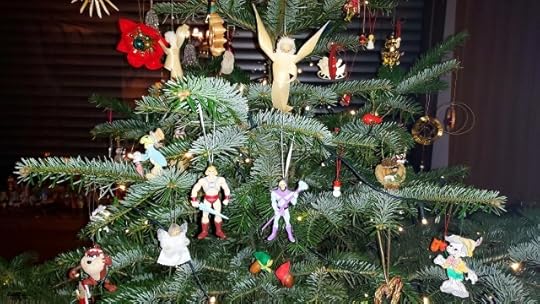
Christmas tree close-up with He-Man and Skeletor, the Tasmanian Devil, the three Disney ornaments a lady called Jenny gave me and a vintage wood shavings angel which we got from my Grandma.

Vintage wooden angels hover around Baby Grogu, because Christmas has room for more than one very special baby. Also note the Wedgewood ornament in the background.
On Christmas Day, I went over to my neighbours to deliver some presents and then I heated up the sailor’s curry, cooked rice and prepared the side dishes for our traditional Christmas Day lunch.

Sailor’s curry and basmati rice

The side dishes for the curry. Clockwise from the left: Hardboiled egg, gherkins, pickled beetroot, banana, onions, atjar tjampoer (Dutch Indonesian pickled vegetables), lime pickle and mango chutney.

The sailor’s curry all mixed up on the plate.
The rest of Christmas Day was quiet and so was Boxing Day, where I had the rest of the curry.
And that was Christmas 2024, which all in all went better than I thought it would.
I’m not sure if I’ll get the second part of my adventures at the Church of Eternia Masters of the Universe holiday event posted in 2024 (the post is about half finished), but of course there will be the eagerly awaited announcements of the winners of the 2024 Darth Vader Parenthood Award for Outstandingly Horrible Fictional Parents and the 2024 Jonathan and Martha Kent Fictional Parent of the Year Award.
December 18, 2024
Cora’s Adventures at the Church of Eternia Masters of the Universe Holiday Event in Hanau, Part 1: It’s Roadtrip Time
In November, a German Masters of the Universe collector told me that there would be a Masters of the Universe themed holiday event on December 14, which sounded like a lot of geeky holiday fun.
The only problem was that the event took place in Hanau, a city some twenty kilometers to the east of Frankfurt on Main. That’s 471 kilometers away and driving there would take between four and five hours, depending on the traffic. That’s too far for one day. The train wasn’t really an alternative either in this case, because there is no direct connection, so I’d have to change trains two or three times, which would take longer than driving. Besides, German trains are always overcrowded on the weekends and tickets are more expensive. The trains also switch to a new schedule this weekend. Theoratically, there also was the option to fly from Bremen to Frankfurt and take a train to Hanau, but that’s not happening.
So the best possibility would be to drive down to Hanau on Saturday, spend the night there and drive back the next day. I dithered for a while, checked the 14-day weather forecast (because frost and snow are not conductive to long drives), checked available hotels along the route and then said, “Okay, I’m doing it.”
And you know what that means. It’s roadtrip time!
Autobahn A1 and A27Because I had a long drive ahead of me, I set out at shortly after five AM. Because it’s December, roughly a week before the winter solstice, it was pitch dark. In fact, the sun wouldn’t rise until half past eight.
I made my way to the Brinkum exit of Autobahn A1, because in my region every longer journey starts on the A1, and counterintuitively drove in northbound direction towards Hamburg for the first fifteen kilometers or so. Indeed, Else, my GPS, keept insisting I should exit the Autobahn and turn around.
Now there are two different routes to get from Bremen to Hanau. The first is to take the A1 in southbound direction and then change onto the A45 until Hanau. This was also the route that Else wanted me to take. The major issue with this route is that not only would I have to brave the 33 kilometers monster construction zone between Lohne/Dinklage and Bramsche as well as the northern edge of the Ruhrgebiet, but the A45 is also beset by construction work every couple of kilometers, because all the highway bridges and viaducts have to be replaced at the same time and there are sixty of them. The second generation of German Autobahnen were all built in the 1960s and by now the bridges are crumbling and need to be replaced, which is why there is so much construction work everywhere.
The second route is somewhat longer, but also faster due to less construction work along the way. It takes the other major north-south route through Germany (and Germany’s longest Autobahn), Autobahn A7. This was the route I was going to take, even though I don’t like the A7 very much, because it’s unpleasant to drive and has even been called “Germany’s longest nightmare”. But more on that later.
After approx. fifteen kilometers on the A1, I changed onto Autobahn A27 at the intersection Bremer Kreuz or “das Kreuz”, as we call it here, because all the other intersections are quite far away, so there’s no risk of confusion. The A27 connects the North Sea ports of Cuxhaven and Bremerhaven with Hannover and from there with Berlin and Eastern Europe, so it’s quite important and can also be busy, particularly with truck traffic. However, at five AM on a Saturday morning, it was largely empty. Even the trucks were still parked in the rest areas along the road.
The A27 is a very dull Autobahn, because from Bremen it basically passes through a lot of nothing in both directions. In southeastern direction, this whole lot of nothing is mainly woodlands, punctuated by a few towns. Though at least I wasn’t missing anything by driving in the dark, because there’s nothing to see here by day either.
All direction signs on the A27 point towards Hannover, but that’s not actually where the highway goes. Instead, it goes to a town called Walsrode, which is notable for an abbey, which dates all the way back to the 10th century, though the current buildings mostly date from the 18th century, as well as for Walsrode Bird Park, a popular local attraction. Indeed, the area around Walsrode is home to several theme parks (Magic Park Verden, Walsrode Bird Park, Serengeti Park Hodenhagen and Heidepark Soltau), because even though the region itself is sparsely populated, it’s within easy reach of Hamburg, Bremen and Hannover with some four million people altogether.
Autobahn A7In Walsrode, the A27 meets Autobahn A7. Here, the A7 cuts through the Lüneburg Heath and Südheide nature parks. By daylight, you can see tufts of heath and the distinctive pale sandy soil of the Lüneburg Heath by the roadside. By night, you can see nothing, but then it’s not heath bloom time anyway.
In recent years, the A7 has been newly paved and expanded to three lanes in each direction, so in theory it should be pleasant to drive. In practice, however, the tarmac they used is oddly slippery and unpleasant. Supposedly, this type of tarmac dampens noise emissions, which is a good thing. However, it’s also really unpleasant to drive on.
After approximately thirty-five kilometers, you reach Hannover. There’s not much to see here either, because the A7 swings around Hannover in a fairly wide arc. In addition to several intersections, the only thing you can really see of Hannover – and the first thing I associate with the city – are the marl quarries and cement factories on the edge of the city. Even at six AM – I had been driving for roughly an hour by now – they were brightly lit.
This was also where I made my first brief pitstop, at the Seckbruch rest area. I wanted a sip of water, but fiddling with a water bottle, while going 130 kilometers per hour or so on the Autobahn in the dark, isn’t a great idea, so I drove onto the Seckbruch rest area to drink some water and have two pieces of chocolate, before heading onwards.
After another twenty-five kilometers I reached Hildesheim, a city famous for two Romanesque cathedrals, which are a UNESCO World Heritage site, as well as a sacred rosebush that’s supposedly more than a thousand years old, though you obviously can’t see any of this from the highway. My Mom always insisted that the thousand year old rosebush was a scam BTW.
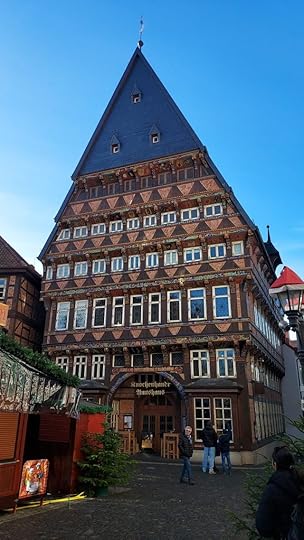
The House of the Butchers Guild in Hildesheim, built in 1529. This photo was not taken during this trip, but during another trip to Hildesheim in late November.
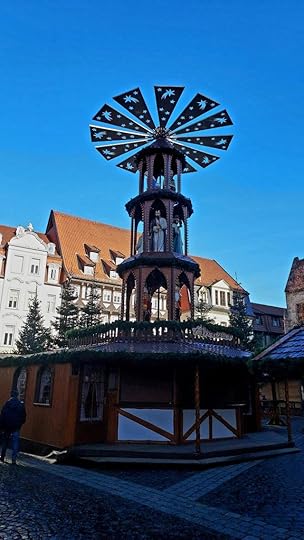
A giant Christmas pyramid at the Hildesheim Christmas market. This photo was also taken during the visit in late November.
Up to this point, I was quite familiar with the route, because I’ve driven it lots of times. In fact, I visited Hildesheim only three weeks before, which was also part of what inspired me to go on the longer trip to Hanau, since I figured I’d already done half the trip easily (well, more like one third). Beyond Hildesheim, however, my knowledge of the route gets fuzzy.
Harz and SollingJust beyond Hildesheim, you also reach the point where the glaciers of the last ice age stopped and you suddenly get mountains. Okay, they’re more like hills, but if you come from the North German lowlands where the highest elevation is 80 meters above sea level, even hills of 200 or 300 meters sure look like mountains. This effect is most pronounced at Porta Westfalica, where the mountains literally jut out of flat land at the Weser gorge, but it happens elsewhere as well.
The first hills just south of Hildeheim are called Vorholz (literally pre-wood). Shortly thereafter, you get the more famous Harz with North Germany’s highest mountain (and yes, this one is a real mountain), the Brocken, which reaches up to a stunning 1142 meters above sea level. According to legend, the Brocken is a gathering place for witches and demons. Johann Wolfgang von Goethe mentions it in Faust and it also gave its name to the optical phenomenon known as the Brocken spectre, since the Brocken is nigh permanently shrouded in fog.
The Harz is a popular holiday region, both in summer and winter. In summer, you get hiking and picturesque towns, in winter you get the northermost place in Germany where you can go skiing. The peak of the Brocken is usually covered in snow from September to May, though climate change is also hitting the Harz.
However, even though I was passing through the western edge of the Harz, I only knew where I was was from the names of the highway exits and service stations and the tourist information signs along the Autobahn. Because it was still dark at this point, so I couldn’t see any mountains. Though occasionally, I’d catch a glimpse of lights above the Autobahn or I’d cross a bridge and see lights below.
But even though the Harz is a popular holiday destination and only about two hours away, we never went there. In fact, the only time I’ve actually been in the Harz mountains (though not on the Brocken, because that was still East Germany at that point) was during a school trip at the age of twelve. Because my parents preferred the other mountain ranges in the area, the Weser Uplands and the Solling. Indeed, my parents often said that they didn’t understand why so many people insisted on visiting the Harz, even though the Weser Uplands and Solling were much prettier. Not that I could tell, because it was still dark by this point.
My Dad also told me once that the mountains to the east of the A7 were called the Harz and the mountains to the west were called the Weser Uplands and the Solling. As a kid, I found this baffling, because the mountains had clearly been there long before the A7 was built, so how would people have known which mountains were which without the Autobahn to use as orientation? Of course, the A7 passes through a natural lowland dividing Harz and Solling and follows the approximate route of much older roads, so people clearly knew which mountains were which.
But even though my knowledge of the A7 beyond Hildesheim is fuzzy, I realised that I recognised many of the exits and town names, particularly on the Solling side. Because even though I haven’t been in this area recently, I visited the Solling and Weserbergland lots of times with my parents in the past and was familiar with many of the town names.
GöttingenThe next bigger city along the A7 is Göttingen, famous for its university. Göttingen is also where my Aunt Irmgard (nicknamed Aunt Irmgard from Göttingen to distinguish her from another Aunt Irmgard) used to live. Aunt Irmgard was a cousin of my Dad. Her husband was what we would now call a hoarder. We visited them several times when I was a kid and I was always told not to comment on the stacks of newspapers and magazines everywhere.
Indeed, Aunt Irmgard is part of the reason why I’m familiar with the are around Göttingen. Because I have or rather had family in the area. My Great-Aunt Mariechen, the older sister of my grandfather, worked as a nurse in WWI. Here she met Heinrich, who was a member of the famous Prussian Lange Kerls (Tall Guys) regiment of extremely tall soldiers. Mariechen was small and plump, Heinrich was tall and dashing. They fell in love, married and moved to Heinrich’s family farm in the village of Offensen near Göttingen. Aunt Mariechen and Uncle Heinrich kept in close contact with my grandparents and my Dad and his brothers often spent the holidays on the farm in Offensen. Later, when my Dad met my Mom, he’d take her on holiday to Offensen – even before they were married, because Tanta Mariechen and Uncle Heinrich made sure there would be no hanky-panky. Uncle Heinrich died before I was born and Aunt Mariechen died when I was two. The only memory I have of her is oddly enough of her funeral. The chapel had stained glass windows and angels, which so impressed me that I had to point out how pretty it all was in the middle of the funeral service, so a nice lady from the village took me for a walk on the cemetery, where I found a cool white stone. I still have the stone. But even though Aunt Mariechen and Uncle Heinrich were gone, we still visited Offensen whenever we were in the area. By that time, the family farm had been taken over by a nephew of Uncle Heinrich’s. He later died as well and his widow remarried. Dad kept visiting them until a few years ago, often with his motorbike. I tried to call them after Dad died, but the number was no longer current.
When I saw the town Adelebsen listed as one of the destinations at the exit Göttigen North, I realised that Offensen had to be not just somewhere in the general area, but pretty close by, because Adelebsen was the neighbouring town of Offensen. At this moment, I decided that on my way back I would stop by in Offensen and ring the bell of the farmhouse to see if anybody was home. But more on that later.
By now, I was also feeling some pressure in my bladder. Most rest areas along German Autobahnen are equipped with public toilets, but the cleanliness is highly questionable. And since my need wasn’t that urgent, I could wait until the next proper service station, which happened to be Göttingen East. I perused the toilet and – when I saw that the coffee counter was already open and manned or rather womanned at 7:45 AM I decided to have a coffee as well to refresh myself for the journey.
By the time I left service station Göttigen East, the relentless oppressive darkness outside was getting ever so slightly lighter, slowly fading into relently greyness. As I drove onwards, I could gradually make out the outlines of misty mountains on both sides of the highway.
The Kasseler MountainsThough there were not just misty mountains on both sides of the highway – no, the Autobahn itself suddenly started getting hilly and curvy. There were plenty of curves, slopes and inclines – the steepest was a whopping 8% – and speed limits of 100 to 120 kilometers per hour. Not that you could drive any faster anyway without putting yourself and others at risk. I had reached the infamous Kasseler Mountains.
Of course, Kasseler Mountains is not the proper name of this area. The mountains have names like Sandwald, Kaufunger Wald, Knüllgebirge, Habichtswald and Großer Staufenberg. However, to people unfortunate enough to drive along this curvy and steep stretch of Autobahn, they are known as the Kasseler Mountains, because Kassel is the next big city along the route and the one which is listed on all the direction signs. Particularly truckers hate the Kasseler Mountains and would often use country roads instead, much to the annoyance of the people living in the towns along those roads. At one point I even saw an emergency stop lane for trucks suffering brake issues.
Now the very point of an Autobahn is that they don’t have many curves and steep inclines, so the main question which comes to mind while crossing the Kasseler Mountains is “Why?” Why is this Autobahn so curvy and steep, even though the mountains it crosses aren’t all that high? After all, it’s not as if the Kasseler Mountains are the Alps?”
The answer is that the Göttingen-Kassel leg of the A7 is one of the original Third Reich era Autobahnen, built between 1934 and 1938, though the planning phase goes back to the Weimar era. The Nazis mostly adopted the Weimar era Autobahn plans and claimed them as their idea, but in the case of the A7 they made an exception and threw out the original plans, which would have followed a more sensible route with fewer curves and steep inclines and viaducts. Instead, the Nazi planners came up with the current curvy route with its steep inclines and high viaducts, because they wanted to prove that they could do it. Besides, this route would offer lovely views to tourists. And some of the views are indeed lovely – or would be, if I could actually see more than mist and December gloom.
That said, the actual Autobahn has long been repaved, expanded and replaced since the Nazi era . But the idiotic route is still in place, because no one wants to build a completely new Autobahn, when there is an existing one already in place. As for why the Nazis were so eager to build this stretch of Autobahn, even though the area between Göttingen and Kassel and beyond isn’t particularly densely populated even today and was even less so in the 1930s, Kassel was the locasion of several big propaganda events in the 1930s (and I just realised that Aunt Mariechen and Uncle Heinrich must have witnessed the Autobahn being built), so this Autobahn was prioritised, even though there would have been more important stretches to to build first.
Though next town of note along the route through the Kasseler Mountains is not Kassel, but Hannoversch-Münden, where the rivers Werra and Fulda meet to form the Weser. I had already crossed the Weser back in Bremen and now, near the Hedemünden exit, I crossed the river Werra on the Werra valley viaduct, which is North Germany’s highest bridge at a whopping 59 meters. The Werra valley viaduct was part of the original 1930s Autobahn, though again it has been rebuilt and replaced several times. The current viaduct dates from the 1990s, though you can still see a Nazi era relief on one of the distinctive red stone pillars.
The Nazis were big on beautiful views and so they designed the Werra valley viaduct to offer a stunning view of the Werra valley. Originally, there even was a rest area allowing you to stop and enjoy the view, though that was removed ages ago, because it tended to cause accidents with trucks crashing into parked cars. As for the stunning view, the current viaduct is flanked by sound barriers, so you can’t see any of it.
After crossing the Großer Staufenberg, the A7 descends towards Kassel and for once you can actually see the striking view that the Nazi era planners intended. At any rate, I suddenly saw the lights of Kassel shimmering below in the morning mist. I’m sure it’s a great view, if the weather is better. There’s even a rest area called Herkulesblick (Hercules View) in reference to Kassel’s famous Hercules statue.
Kassel itself is known for the Wilhelmshöhe park, which is a UNESCO World Heritage site, and for the documenta art exhibition, which takes place every five years. Yet for some reason, it’s not a city I’ve ever visited, just a spot I’ve driven past. In fact, I considered stopping at Kassel to visit the Wilhelmshöhe park on my way home, but that’s best done in the spring and summer, when the weather is nicer and the artificial waterfalls are switched on. As for the documenta, the next one is in 2027, which give me plenty of time to decide whether I want to go. In recent years, the documenta has been more notable for scandals than art.
Terra IncognitaWhile my knowledge of the route became fuzzy after Hildesheim, it was pretty much entirely gone after Kassel. I know that I must have driven this route before with my parents, but I recognised very few of the town names and exits. And those I recognised, I didn’t recognise because I’d been there before, but because I associated these towns with books, movies or stories by relatives.
At a town called Guxhagen beyond Kassel, the A7 crosses the river Fulda, which means that I had now crossed the river Weser and both its source rivers. A bit later, you also pass Castle Neuenstein, which sits directly next to the Autobahn and is one of the more interesting sights along a route that’s mostly woodlands and mountains.
Meanwhile, the information signs along the road and the exits told me that I was passing the Rhön mountains. My Aunt Ilse and Uncle Uwe always spent their holidays here in the 1980s and 1990s. In fact, Hilders, the town where they stayed, was listed on one of the exit signs.
By now, it was approaching nine AM and I decided to stop somewhere for breakfast. I passed several Autohöfe and one service station, but the service stations are over-priced and the food quality usually isn’t good. And the Autohöfe only had internationl fast food chains like McDonald’s, Burger King or Subway, which I tend to avoid. That said, the Malsfeld Autohof also turned out to have a restaurant of the Maxi chain, a German chain of truck stops which is pretty decent. However, I only spotted the Maxi logo, once I’d already driven past the exit. So onwards it was.
I finally did leave the Autobahn at the exit Bad Hersfeld West, because I faintly recalled reading somewhere that Bad Hersfeld had a Rosi’s Autohof, another German truck stop chain, which is pretty decent. However, Bad Hersfeld is quite a bit away from the A7, which means there are several exits named Bad Hersfeld. And the Rosi’s Autohof I remembered seeing advertised is actually on the A4, a completely different Autobahn.
Worse, Bad Hersfeld West is one of those Autobahn exits that disgorge you in the literal middle of nowhere. Or rather, it disgorges you into a village called Aua (the onomatopoeic German word for the sound you make when you stub your toe), which has a couple of houses, a Shell gas station and a depot of the GLS logistics company. What they do not have is a place to have breakfast – unless you fancy gas station coffee.
So I checked Google Maps on my phone and saw that the next exit Kirchheim had an Autohof and a retail park directly by the Autobahn, probably because the junction Kirchheimer Dreieck, where the A4 meets the A7, is one of the busiest in Germany. There’s construction work going on there and so the Autohof restaurant turned out to be closed for renovations. But there was a Rewe supermarket with a bakery café called Guter Gerlach (Good Gerlach). I immediately wondered whether there was also a bakery called Bad Gerlach in the area, cause that would be funny.
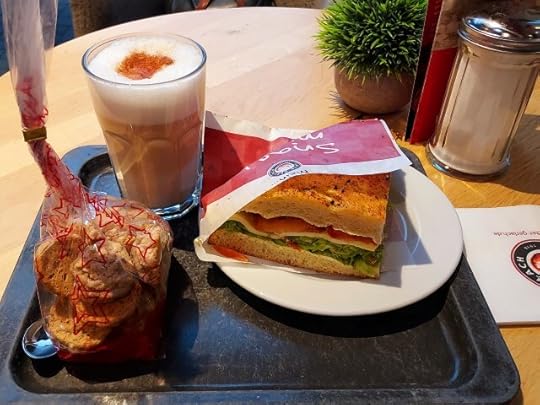
My breakfast at Bakery Guter Gerlach. The cookies are supplies for the road.
I had a tomato and mozarella sandwich and a latte macchiato for breakfast and also bought a bag of holiday cookies to keep me supplied for the rest of the way. Thus refreshed, I set off again for the final hour or so of my journey.
Into the Fulda Gap… and Post-Apocalyptic LandsAfter Kassel, the next city of note along the A7 is Fulda. I always found it somewhat irritating that the city bears the same name as the river on whose shores it lies.
Fulda is also (in)famous for another reason entirely, namely because it lend its name to the so-called Fulda Gap, where World War III was expected to begin.
Basically, Fulda is located only approximately 35 kilometers from the former border between East and West Germany, because East Germany, more specifically Thuringia, juts furthest into West Germany at this point. The US military, for reasons best known to themselves, expected that should the armies of the Warsaw Pact ever attack West Germany, they would do it here. And since there are quite a lot of difficult to cross mountains and woodlands in the region, the US Army expected that there were specific routes the Warsaw Pact armies would take – routes which correspond to valleys and also various Autobahnen. The endgame was conquering Frankfurt on Main, West Germany’s financial capital, as well as the Rhine-Main Air Base. There was even a boardgame which allowed you to play your own version of World War III.
Now I have to admit that I never quite understood why the US Army expected an attack from the East to happen at Fulda Gap. Personally, I always expected if the armies of the Warsaw Pact were ever to attack, they would do so in North Germany in the area around the Helmstedt-Marienborn border crossing, where there were no pesky mountains in the way. And since I had visited East Germany before the Fall of the Wall and had seen the generally dilapidated state of the country and its people (and the Red Army soldiers stationed all over East Germany), I always used to joke that the tanks would maybe get as far as Braunschweig, before they broke down, but the soldiers themselves would never get past Helmstedt, because they would stop to loot the first supermarket on the western side and then pass out from too much food and drink and that would be the end of it.
However, the US military took the Fulda Gap deadly seriously. There were plans and preparations made to blow up important roads and – worse – to nuke the area around Fulda and the Kinzig Valley to slow down the advancing Warsaw Pact troops. Okay, so these were only “low yield tactical nukes” with a limited radius of destruction, but that would be small comfort the people who happened to live around Fulda and in the Kinzig Valley.
One of the first intended targets for nuclear “friendly” fire was the village of Hattenbach, home to some 580 people today, because the Hattenbacher Dreieck Autobahn junction, where the A5 meets the A7 happens to be right next to the village. Indeed, as I drove through the Hattenbacher Dreieck and tried to make sense of its confusing signage (they have separate lanes for trucks and passenger cars), I wondered why the name “Hattenbach” seemed so familiar, even though very little else in the region was.
Once the plans of the US military to turn a swathe of Eastern Hesse into a nuclear wasteland came out, many West German people were understandably furious. Learning that the people who were supposed to be our allies were willing to nuke us proved beyond a doubt that to the US military, the people of (West) Germany weren’t allies or even human, but just collateral damage. They didn’t give a damn how many people their nukes would kill in Eastern Hesse, as long as they could protect their precious air base. Meanwhile, many West Germans probably thought that if the Soviets wanted Frankfurt on Main so badly, they were welcome to it (Frankfurt was beset by drugs, poverty and crime in the 1980s). And no one except politicians gave a damn about Rhine-Main Air Base. To regular Germans, it was just that part of Frankfurt Airport that normal planes couldn’t use.
Rearmament and the establishment of the Bundeswehr in 1956 had been highly unpopular in West Germany. I don’t know anybody who was alive back them and didn’t hate that idea and there was also huge protests, even though those are largely forgotten today. However, in the 1950s and 1960s and even into the 1970s, the overall attitude towards the US soldiers stationed in West Germany was mostly positive. I remember there being programs organised by the German towns that were home to US military bases to bring US soldiers and German civilians together such as US soldiers spending the holidays with German families, so they wouldn’t be lonely. That said, many US soldiers and their families tended to stick to themselves and stay on their bases. Germans also weren’t allowed to enter the shops at the US military bases to buy all the cool American books and comics and other products they had there. And yes, I know that there are legal reasons for this, but as a kid and teenager who just wanted Americans books and comics, this irked me to no end.
However, the US plans to nuke the region around Fulda pretty dispelled any illusion that the US was our friend and together with the NATO Double Track decision galvanised the West German peace movement and led to massive protests – some of the biggest ever seen in the country – in the early 1980s. Indeed, my high school chemistry teacher quit the Bundeswehr over this. And yes, the Fulda Gap boardgame played a role, too, because it demonstrated only too clearly what the US military was planning. Ironically, that boardgame was really popular among members of the West German peace movement, who used to play it to demonstrate what would happen. This also is part of the reason why the Green Party was founded, because all other parties were pro-NATO and pro-militarisation. Indeed, the roots of the Green Party in the peace movement of the late 1970s and early 1980s is part of why the party’s 180 degree heel turn with regard to the war in Ukraine feels like such a betrayal, though not necessarily an unexpected one, because it’s been clear since the Balkan Wars of the 1990s that the reason the Greens always hated “war toys” so much is because they will take any chance they get to play with tanks and missiles and bombs.
The Fulda Gap ceased to be relevant in 1990. Even if Russia were ever to attack Germany – which I don’t believe they will, though sadly plenty of people in positions of power do – it wouldn’t happen here, because there no longer is an inner-German border and Thuringia is not going to attack Hesse anytime soon. The former border stations and observation stations on both sides of the border – there were a lot of those particularly in the Rhön mountains – are now museums. Nonetheless, driving through the area and reading the town names on the exit signs, I couldn’t help but think about how World War III was supposed to start here. The fact that the gloomy day and the bleak wintery landscape felt distinctly post-apocalyptic, didn’t help either.
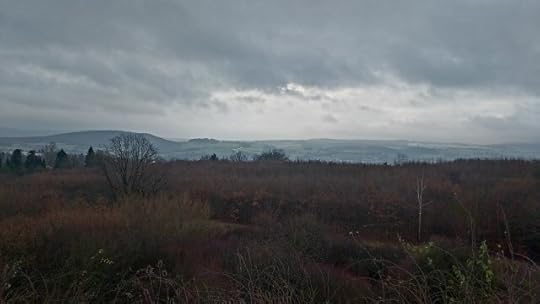
This view across the Kinzig valley towards the Spessart mountains from the rest area Kinzigtal on the A66 is extremely bleak and reminiscent of the apocalypse that never came.
The Fulda Gap also appears in nuclear war fiction and movies of the 1980s. In the 1983 nuclear war movie The Day After, World War III starts at the Fulda Gap as well as Helmstedt-Marienborn (see, I was right), though it’s Würzburg rather than Fulda or Hattenbach that gets nuked first, albeit off screen. Meanwhile Denise, one of the most annoying characters ever to appear on screen, complains that she doesn’t care about what happens in West Germany, because her upcoming wedding is so much more important. Then Kansas City and a college town called Lawrence get nuked and the movie expects us to care about that, while dismissing the deaths of the people of Würzburg. As for annoying Denise, her husband-to-be gets incinerated by the bomb and Denise stupidly runs out into the fallout and eventually succumbs to radiation sickness. In fact, I think the cavalier way that the deaths of thousands of German people is handled in the movie, which then expects us to care about American soap opera clichés is why I actively dislike The Day After. In the much superior British nuclear war drama Threads, WWIII starts in the Persian Gulf BTW.
However, my main associations while driving along the A7 towards Fulda were two German post-apocalyptic YA novels, Die letzten Kinder von Schewenborn (The Last Children of Schewenborn, 1983) and Die Wolke (The Cloud, 1987) by Gudrun Pausewang. Both books were ubiquitous if you were a kid in (West) Germany in the 1980s and 1990s, frequently assigned in schools and also showing up as gifts in the hand of that one relative who kept up with award-winning children’s books (in my case, it was my German teacher cousin). Even if you didn’t read those books yourself, you knew someone who had.
The Last Children of Schewenborn is about nuclear war randomly breaking out. The first person narrator, a twelve-year-old boy from Frankfurt on Main, is on route to visit his grandparents in the Hessian village of Schewenborn (based on Schlitz, where Gudrun Pausewang lived and worked as a teacher) when the bombs fall. The family survives the initial strike on Fulda and make it to Schewenborn, but over the course of the book everybody except the narrator and his father dies in various horrible ways.
Because nuking her hometown once wasn’t enough, Gudrun Pausewang did it again four years later in The Cloud. This time around, the culprit is a Chernobyl scale nuclear disaster at the nuclear power station Grafenrheinfeld in Northern Bavaria. Indeed, Gudrun Pausewang was one of the guests at the decommissioning ceremony of the Grafenrheinfeld power station in 2015. The protagonist is a fourteen-year-old girl who’s at school when the sirens go off. Her parents are in Schweinfurt for the day, which just happens to be next to Grafenrheinfeld, and the protagonist is left alone with her younger brother in Schlitz, which actually gets to be Schlitz this time around. The protagonist and her brother try to make it on bikes to the train station in Bad Hersfeld to escape on the last train before the fallout – the titular cloud – arrives in Schlitz, but neither of them makes it. Once again, pretty much everybody in the book except for the protagonist dies in various horrible ways. The Cloud even had a movie adaptation in 2006, where the sirens literally go off when the heroine first kisses the boy of her dreams.
The Last Children of Schewenborn and The Cloud must be two of the bleakest and most depressing books ever written. They’re also very much works of their time, capturing popular anxieties of the 1980s. Revisiting them as an adult, I’m also stunned by how graphic they are. The various grisly deaths and injuries are described in loving detail, dogs, children and even babies are killed on the page (indeed, the one scene from The Last Children of Schewenborn that everybody remembers is how the narrator’s father kills his newborn baby sister, because she’s deformed and they don’t have milk to feed her). I could never imagine scenes like those even in the bleakest of American YA books.
And based on the ages of the protagonists and also the writing – no romance and a strong family focus, only to kill off everybody – these books are closer to what we’d consider Middle Grade today rather YA. Indeed, recently pedagogues issues a warning that The Last Children of Schewenborn shouldn’t be read by elementary school kids, i.e. ages 6 to 10. I have recommended these books to adults with the warning that they’re massively depressing and would never recommend them to anybody under 16 or so.
The books are also so didactic and message heavy that you dislike them even if you agree with the message, which I do. There’s also a lot of stuff that’s just plain wrong, particularly in The Cloud, where soldiers shoot civilians trying to escape irradiated Schweinfurt, because they’re so fatally irradiated they would pose a risk to everybody else and would just die anyway, since they received lethal doses, and where protagonist Janna-Berta spends much of the book bald, because she lost her hair due to radiation sickness. This is complete nonsense – there are people alive today who were on the premises of the Chernobyl power station during the meltdown as well as plenty of people who lived in Pripyat. And while many people died or got cancer, no one lost their hair except for the worst affected plant workers and firemen. Soviet soldiers also did not shoot civilians in Pripyat, though they did shoot pets and domestic animals. To be fair, a lot of this wasn’t known in 1987, but I do remember many children from irradiated Ukraine and Belarus receiving treatment in German hospitals in the late 1980s and early 1990s and if they were bald, it was from chemotherapy, not radiation.
The real town of Schlitz is famous for five castles in various states of ruin in the area and bills itself as “the romantic castle city”. However, to someone my age seeing the name Schlitz on a highway exit sign only conjures up images of death, destruction and nuclear holocaust. I guess Schlitz’s tourism marketing is very grateful to former resident Gudrun Pausewang. Meanwhile, the spa town of Bad Hersfeld conjures up images of people, including children, getting graphically trampled to death while trying to catch the last train out of the nuclear hellscape.
Autobahn A66 and the Kinzig ValleyI finally made it to Fulda without getting nuked and changed onto Autobahn A66 for the last leg of my journey to Hanau. This part of the A66 is fairly new, built between the 1990s and 2014. Indeed, part of the A66 is so new that my aging car GPS (which can’t be updated anymore – I asked) doesn’t recognise it.
Shortly after Fulda, I drove through the 1.6 kilometer long Neuhof tunnel and then through the Kinzig valley on the same route that the armies of the Warsaw Pact were once assumed to take towards Frankfurt and that the armies of Napoleon actually did take. I guess that’s probably also why the Hanau-Fulda leg of the A66 wasn’t finished until after the Fall of the Wall – they didn’t want to make it too easy for the Soviets and besides, there wasn’t a lot of traffic eastwards in this area anyway, because the East German border was so close.
Once I changed onto the A66, I didn’t recognise any of the town names on the exit signs at all, even though there were quite a few exits and towns. One thing I did recognise was the massive headquarters with factory and outlet center of the Engelbert Strauss company, a popular manufacturer of workwear and protective gear. My Dad never bought Engelbert Strauss products for some reason, but plenty of gardeners, handymen, etc.. do wear their gear, particularly the younger ones, because their stuff looks pretty cool by workwear standards. I never knew where the company headquarters was, though, and neither did my neighbour Vladimir, who is an eager customer of their products.
The other thing I recognised were the Spessart mountains and woodlands to the south of the Autobahn. Because the Spessart is rather famous, both as a destination for hiking and nature holidays and because it’s the setting of the fairy tale collection The Spessart Inn by Wilhelm Hauff, which was adapted into a delightful movie in 1958, which I reviewed here. If Fulda and Schlitz are associated with nuclear war, the Spessart is associated with robbers. The robbers actually did exist, largely because the Spessart was a poor region and many people were depserate, though they were a far cry from the romantic robbers of the movie.
I finally made it to Hanau at shortly before eleven AM, i.e. I’d been on the road for a little under six hours, though stopping for coffee, breakfast and a toilet break means the actual driving time was more like five hours.
As for the con, that will be covered in the next post.
November 20, 2024
A Baffled Guardian Writer Discovers the Autobahn – and the Best German Roadtrip Songs
In the Guardian, I came across a piece entitled “‘A road trip like no other’: my epic drive on Kraftwerk’s Autobahn” by one Tim Jonze, associate editor of culture. It’s a long and rambling essay about Jonze travelling to Germany on the trail of the band Kraftwerk and their song “Autobahn”, which also includes driving on the Autobahn. If you want to listen to the Kraftwerk song, the three and a half minute single version (and the one you’ll hear on the radio) is here and the full twenty-three minute version is here, if you want to torture yourself or really like Kraftwerk (I don’t, but more about that later).
If you’re German and the Autobahn is not some kind of mythical experience for you, but just a way of getting from A to B, the whole piece is rather silly. Indeed, I normally don’t even use the word “Autobahn” in English (unless referring to s specific Autobahn), but prefer the more generic “highway” or “motorway”, because that’s what an Autobahn is, a multi-lane road optimised for long distance, higher speed traffic. Just because Germans were the first to come up with the concept – and as Tim Jonze correctly points out, the Autobahn network was planned during the Weimar Republic and not invented by Hitler, though the bulk of the early construction happened during the Third Reich – doesn’t mean it’s unique to us. Many countries have similar highway networks and indeed there are places where a German Autobahn seamlessly turns into the Dutch or Belgian or Austrian or Swiss or Danish or French or Polish equivalent.
Tim Jonze starts his essay by waxing lyrical about Kraftwerk and their importance as pioneers of electronic music. Now I don’t dispute that Kraftwerk were important pioneers of electronic music. That said, I never liked Kraftwerk. Part of it may be that I’m just a little too young to appreciate them – the “Autobahn” song came out when I was one and a half years old. And by the time I was old enough to actively appreciate music, synthesizers and electronic music were no longer as new and innovative as they had been in 1974. In fact, the time of my musical awakening were the 1980s, the heyday of synth pop. It’s a clear case of the pioneers being eclipsed by those who came along later and did the thing better.
However, as Tim Jonze finds out when he is wandering in the footsteps of Kraftwerk in Düsseldorf or at least tries and is frustrated by the lack of memorial plaques or historical markers or locals caring about the band, I’m not the only German person who doesn’t like Kraftwerk very much. Most Germans don’t. Kraftwerk is a very clear case of a German band that’s more popular outside Germany. Rammstein is another example and to a lesser degree the Scorpions.
A large part of the reason for this are the lyrics. Whenever I heard Kraftwerk songs on the radio growing and occasionally saw the band on TV growing up, I always thought, “That song is so stupid.” Because the monotonous lyrics of Kraftwerk songs do sound stupid, when you actually understand them. Now Kraftwerk obviously doesn’t have a monopoly on stupid lyrics sung in German – not in the country that gave birth to “Da Da Da” by Trio (which nine-year-old Cora thought was as stupid as any Kraftwerk song and which also became an unlikely worldwide hit). However, if you look at the Trio live performance on the popular music show Hitparade, you can see that they’re clearly taking the piss.
BTW, I just checked if Kraftwerk ever performed on Hitparade – the show only played German language songs, so they would have been qualified – and they did in 1978, singing “Wir sind the Roboter”. Bonus points for poor baffled host Dieter Thomas Heck trying to explain what a vocoder is. In retrospect, I feel sorry for Dieter Thomas Heck, who only wanted to present sappy German Schlager music – there’s a reason Hitparade only featured songs sung in German, namely to keep anything too modern and newfangled out – and found himself faced with increasingly strange music and performers.
Unlike Trio and many of the other weird bands and performers that baffled Dieter Thomas Heck on Hitparade, Kraftwerk didn’t seem to have the slightest sense of humour. Indeed, looking at the vintage photos of the band accompanying the Guardian article, my reaction was they look like “Spießer”, stuffy bourgeois arseholes (and Tim Jonze confirms that the founders were basically rich kids, because otherwise they couldn’t even have afforded the pricy synthesizers). And that’s probably why many Germans never liked them and preferred the anarchic punk and German New Wave bands. It’s telling that when Tim Jonze asks people in Düsseldorf about Kraftwerk, everybody instead mentions the local punk band “Die Toten Hosen”, whom I personally also vastly prefer to Kraftwerk. Check out “Hier kommt Alex”, which was inspired by A Clockwork Orange and almost seems like a counter-argument to Kraftwerk. Not to mention that in later years, Kraftwerk was more notable for lawsuits and legal disputes with former members and producers than for their music.
However, Tim Jonze doesn’t just traipse around Düsseldorf on the trail of Kraftwerk, he also wants to experience the Autobahn itself. Cue the deep sigh that a British or American or generally foreign tourist wanting to experience the Autobahn usually elicits among Germans. Because frankly, a lot of them are menaces who drive too fast without being used to it, in cars they’re not familiar with and on stretches of Autobahn or under conditions where driving extremely fast is not a great idea.
And indeed, Jonze’s first attempts to capture that Autobahn experience occur on various Autobahnen in the Rhine-Ruhr metropolitan region (his trip started in Düsseldorf after all), which will certainly give him an Autobahn experience, but not the one he craves. Because as I explain here and here, driving through the Ruhrgebiet and the Rhine-Ruhr metropolitan region is not very pleasant, because the area is extremely densely populated, so the Autobahnen are fairly narrow (and all named A-fortysomething), there are a lot of intersections and junctions, it’s very confusing and there’s often a lot of traffic. Indeed, Tim Jonze decided to start his Autobahn adventure on the A555, a regional highway link between Cologne and Bonn that’s a whopping twenty kilometres long, though it is the oldest Autobahn in Germany. opened in 1932 (not counting the AVUS in Berlin, which started out as a race course before being integrated into the Autobahn network). Not that you’d notice, because the original Autobahnen of the 1930s have been expanded, rebuilt and paved over so often by now that no trace of the originals remains.
And if you want to drive very fast, forget about it, because due to being so densely populated and so busy, almost all the Autobahnen in the entire Rhine-Ruhr metropoltitan region have a speed limit of 100 or 120 kilometers per hour, in some areas even less. Because as Tim Jonze quickly found out, even though there theoretically is no upper speed limit on the German Autobahnen, many of then actually do have a speed limit for reasons of safety, traffic, noise protection or road construction zones.
This is maybe as good a time as any to talk about speed limit or lack thereof which apparently is a large part of the myth surrounding German Autobahnen in the rest of the world and in parts of German society as well. The Green Party demands the introduction of a speed limit on German Autobahnen with nigh religious fervour – it’s as much a fetish for them as nuclear power is for the conservative CDU and immigration is for the far right AfD. Like most religious fetishes, it’s also silly and has little connection to reality.
For starters, large parts of German Autobahn network already have a speed limit. And even if there is no speed limit, this doesn’t necessarily mean that you can drive as fast as you want to, because there’s usually other traffic and also quite a lot of traffic jams. If there’s a truck in the right lane going 80 kilometers per hour, a car pulling a camping trailer in the middle lane going 100 kilometers per hour and a car in the left lane overtaking the car with the trailer at 130 kilometers per hour, guess what? You’re driving 130 kilometers per hour in the left lane, even if you want to go faster. And believe me, this happens a lot, especially if one truck overtakes another truck and a long line of cars piles up behind.
But even if the road or at least the left lane is clear and there’s no speed limit, most people actually don’t drive 180 or 200 kilometers per hour or more. For starters, going at such high speeds is expensive, because it consumes a lot of fuel. It’s also not very pleasant, especially if you’ve got a smaller or older car, and potentially dangerous. Personally, I usually drive between 120 and 130 kilometers per hour when there’s no speed limit. I may go up to 140 kilometers per hour occasionally while overtaking another vehicle. And yes, I have gone faster on occasion – usually when trying out a new car – but I find everything above 160 kilometers per hour actively unpleasant.
Most drivers are like me and rarely go faster than 120 to 130 kilometers per hour. Quite a few rarely go faster than 100 kilometers per hour. You do have chronic speeders who race down the left lane at 180 or 200 kilometers per hour or even more, flashing their headlights at any car that dares to get in their way. However, these people are a minority. Most of us also think they’re arseholes. Oh yes, and if you introduce a general speed limit, the very people who are the most likely to drive extremely fast are also the most likely to just plain ignore speed limits.
If you want to drive as fast as the car will go – because you’re trying out a new car or just want to know what it feels like – your best bet is picking a stretch of Autobahn that’s not very busy and rather boring. A27 eastbound after Bremer Kreuz or A28 westbound after Hasbruch service station work well, as does the stretch of A1 between Bremer Kreuz and Hamburg. Pick a quiet time – no rush hour and preferably a Sunday, when there are almost no trucks about. Six or seven AM on a Sunday morning in June, when the sun is already up, is perfect. In general, make sure the weather is good – no rain, frost or snow – and that it’s daylight. Wait until the road ahead is clear as far as you can see (and it should be a straight stretch of road, no bends or hils which impede the view), change onto the left lane and hit the accelerator. But get ready to decrease speed and or brake, if anything shows up on the horizon. Even you think it’s far off, trust me, at such high speed it’s not.
This is also where the problem with foreigners driving on the Autobahn comes in. They’re often driving an unfamiliar car, they’re not used to high speeds and also don’t know where and when it’s reasonably safe to go fast. See Tim Jonze starting his Autobahn adventure in the Rhine-Ruhr metropolitan area, where it’s definitely not safe to go fast (and not allowed either). At one point, Jonze also opens the driver’s side window, while going 150 kilometers per hour, which makes me wonder if he’s fucking crazy.
What’s even more hilarious is that while Kraftwerk were on the road a lot in the 1970s, travelling from gig to gig, usually on the Autobahn, often by night, their car was a Volkswagen Beetle. Tim Jonze has apparently never driven a Volkswagen Beetle, but I have, because my parents had one in the 1970s and early 1980s. So I know that they couldn’t go any faster than 130 kilometers per hour and the car started rattling like crazy at approx. 100 kilometers per hour. The Beetle‘s successor, a 1980 Volkswagen Jetta, which I continued to drive until 2008 (I wanted to keep it to hit the thirty year mark, when a car is considered a historical vehicle in Germany and gets a special licence plate, but unfortunately the Jetta fell apart two years before), capped out at 160 kilometers per hour and also started to rattle like mad at anything above 130 kilometers per hour. So Kraftwerk were travelling at the relatively leisurely pace of approx. 100 kilometers per hour in a Volkswagen Beetle, when they wrote the “Autobahn” song.
Apparently, one of the Kraftwerk guys said in an interview that the “Autobahn” song was inspired by a roadtrip from Düsseldorf, where the band was based, to Hamburg, with the more industrial sounds early on in the 23-minute version supposed to evoke the hammering of the Ruhrgebiet (the “heartbeat of steel”, which Herbert Grönemeyer famously sang about in his ode to his hometown “Bochum” in 1984, imitated by a drumset in that song), while the gentler sounds of flutes and other acoustic instruments were supposed to evoke the rural Münsterland, all of which just made the “Autobahn” song a lot more interesting than it ever was before, though not interesting enough to subject myself to 23 minutes of Kraftwerk. Coincidentally, my favourite musical evocation of the hammering of steelworks is “Allentown” by Billy Joel from 1982, which is actually a song about the dying of the coal and steel industry in Pennsylvania and about the “heartbeat of steel” going silent forever. I’d never heard of Allentown, when I first heard that song, but I immediately knew what it was about, especially since the Ruhrgebiet was facing the same issues as the Pennsylvania rust belt in the early 1980s. Coincidentally, if you watch this footage of Billy Joel performing “Allentown” live in what was then still Leningrad during his groundbreaking tour of the Soviet Union, you can tell that the young people in the audience (try to spot the totally not obvious KGB agents in the audience) know what the song is about as well, even though they likely didn’t understand the lyrics and I don’t think they understood that what happened to Allentown and the Ruhrgebiet was coming for them, too.
Since he already is in the Rhine-Ruhr metropolitan region anyway, Tim Jonze decides to go in search of the Ruhrgebiet and its heartbeat of steel and has the same experience I had during my trip to Castrop-Rauxel. That Ruhrgebiet is gone and what’s left are museums and monuments. Tim Jonze actually mentions going to Castrop-Rauxel and visiting the Zollern Mine museum. The Zollern Mine museum is actually in Dortmund, not in Castrop-Rauxel, but then the cities do tend to bleed into each other in the Ruhrgebiet. It’s also close enough to Castrop-Rauxel that I may pay it a visit sometime, either when I’m in town for next year’s Toyplosion or just as a cool roadstrip destination.
Since the “Autobahn” song was inspired by a trip from Düsseldorf to Hamburg, Tim Jonze decides to drive that route for the true Autobahn experience, which is certainly a better choice than bopping around the Ruhrgebiet on a succession of A-fortysomethings, since there actually are stretches of Autobahn where you can go very fast, should you so wish. Coincidentally, Jonze’s route also pretty much parallels my trip to the Los Amigos convention in Neuss earlier this year. In fact, one of the dashcam videos that Jonze embedded in his article shows Neuss as a destination on a road sign.
Since I made the same trip (twice if you count my trip to Castrop-Rauxel) this year, I was of course interested in Tim Jonze’s description. He writes:
I pass green fields and red-brick farmhouses, remote churches and towering wind turbines. This is flute-solo country.
Actually, that’s the Münsterland or rather the stretch of the A1 between Kamener Kreuz (which Jonze totally fails to mention in spite of the distinctive ADAC monument of angels carrying a full-sise rescue helicopter) and Osnabrück and beyond. And yes, the description is pretty accurate, though it also matches much of the rural stretches of the Autobahn network in North Germany. Coincidentally, these are also the stretches where there’s no speed limit and it’s possible and reasonably safe to drive fast. At another point, he also mentions awe-inspiring valleys, which likely refers to several viaducts between Münster and the Ruhrgebiet, an area where you get mountains and where the A1 crosses various valleys. The most impressive one is probably at Hagen, where the A1 crosses the Ruhr valley and gives you a beautiful view of several mountains topped with ruined castles, monuments and observation towers.
Tim Jonze completely fails to mention the 33-kilometer monster construction zone between the exits Bramsche and Lohne/Dinklage, most likely because that very much not the Autobahn experience he’s seeking, though the frustration of endless construction zones that seem to take years to finish is very much an Autobahn experience, too. Coincidentally, he also fails to mention the nigh constant traffic jam before the Weser bridge in Bremen (which is in dire need of repairs, so one lane has been blocked and the speed limit reduced to 80 kilometers per hour, which tends to cause traffic jams all the way back to junction Stuhr in the south and the intersection Bremer Kreuz and beyond in the North. It’s a constant source of frustration for those of us in Bremen and surroundings, especially since two other bridges across the river Weser are also currently closed for construction work in a case of seriously terrible timing.
But then, Tim Jonze probably did not experience that particular traffic jam, because he mentions that the sun started to set as he approached Bremen. He writes:
As it turns out, the sun is starting to set as I approach Bremen. Its reflection looks glorious in my wing mirrors, while ahead of me the leaves on the trees are bathed in a brilliant red light.
There’s a photo, too, which looks like it was taken somewhere around the exits Groß Ippener or Wildeshausen North, where the A1 runs through the woodlands and fields of nature park Wildeshauser Geest. For me, this usually signals “I’m almost home” because my exit from the southbound direction is Delmenhorst-East a.k.a. Groß Mackenstedt, the next exit after Groß Ippener. Coincidentally, I never quite understood the reason why the exit Groß Ippener exists, because it literally spits you out into the middle of nowhere. The region around Wildeshausen has been inhabited since Neolithic times and the A1 roughly follows a road that’s thousands of years old. The massive Visbek Bride Neolithic tomb is so close to the A1 that you can hear the trucks and cars thundering by.
Tim Jonze then writes about letting the beat of Kraftwerk’s “Autobahn” (he must have the song on a loop, because he’s been driving three hours or more by now) towards “the shimmering lights of Hamburg”. Of course, if he’s in Groß Ippener, Hamburg is still more than an hour away and the shimmering lights he sees are either the signs of Autohof Groß Mackenstedt or the giant illuminated IKEA and Kibeck signs at the exit Brinkum or the lights of the industrial estate at the exit Bremen-Hemelingen.
There’s some dashcam footage of driving towards Hamburg after nightfalls embedded in the article, but it’s too brief to make out exactly where this is. It might be just before the Bremer Kreuz intersection or it might be near service station Grundbergsee (which Jonze would have no reason to mention, since he likely has no idea what happened there on the night of August 17, 1988 and why I still avoid that place like the plague) or even as far north as exits Rade (where my Dad and I once spent an hour stuck in a broken down car waiting for the repair service) or Hollenstedt.
That said, I’m pretty sure I know exactly what “the shimmering lights of Hamburg” refer to. It’s the sight that greets you when you emerge from the Elbtunnel (which is on Autobahn A7, not A1) and suddenly there’s Hamburg stretched out in front of you and to the right there is a majestic span of the iconic Köhlbrand suspension bridge. It’s a view I’ve loved ever since I first saw it as a very young kid and the reason why I always pestered my Dad “Can we go through the Elbtunnel please?” It’s also a view that’s best enjoyed when you’re not behind the wheel and don’t have to deal with the dense traffic and permanently gridlocked Hamburg. Coincidentally, now I’m an adult I understand why my Dad hated driving through Hamburg so very much, to the point that he once paid for a more expensive plane ticket, so I could fly from Bremen rather than Hamburg.
So is Kraftwerk’s “Autobahn” the best song for a roadtrip on the Autobahn? No, and it’s not even close. Because Germany has generated a remarkable number of songs about driving and roadtrips. Specific Autobahnen, intersections, exits or sometimes Bundestraßen (two-lane highways) are often mentioned in the lyrics and the songs are about truckers, bikers, hitchhikers and drifters. In particular, there are a lot of trucker songs, because Germany is located smack in the middle of Europe, which means there are a lot of truckers. Some artists specialised in trucker songs such as Gunter Gabriel, here singing “Er fährt ‘nen 30 Tonner Diesel” (He drives a thirty ton diesel truck) from 1974, an ode to all the truckers whose home is the Autobahn, or the Hamburg band based country band Truck Stop who referred driving, truckers and the Autobahn in many of their songs such as “Ich möcht’ so gern Dave Dudley hör’n” (I would love to listen to Dave Dudley) from 1978 about the pain of being on the road with only terrible music on the radio, or “Die Frau mit dem Gurt” (The woman with the seat belt) from 1977, which references a 1970s public safety post about an attractive naked woman wearing nothing but a seat belt (I couldn’t find the poster online, though I clearly remember seeing it) or “Der Trabi und der Truck” (The Trabi and the Truck) from 1990 about the German unification and roads and country becoming one (“Trabi” is short Trabant, the iconic East German car brand) or “Der Wilde, Wilde Westen” (The Wild Wild West) from 1980, which insists that the Wild West begins at Maschener Kreuz just before Hamburg, where the A1, A7 and A39 intersect. Maschener Kreuz is infamous for traffic jams, because this is where the two main north-south routes not just for Germany, but for all of Europe, intersect. It’s also where the band’s recording studio was located, “directly by the Autobahn” (it’s not specified which one). The studio closed in 2014 BTW.
“Der letzte Cowboy” (The Last Cowboy) by Thommie Bayer from 1979 is another German country song or rather a parody of country songs about a drifter, the titular last cowboy, who hails from Gütersloh and pretends he’s living in a western, a Marlboro commercial or Easy Rider. It’s a great, both hilarious and melancholic and also great for singing along on a long drive. “Im Wagen vor mir fährt ein junges Mädchen” (There’s a young girl in the car ahead of me) by Henry Valentino and Uschi from 1977 is about a male driver who decides to follow a pretty girl in a small car (specified to be a “duck”, i.e. a Citroen 2CV) going slow on the right lane of the Autobahn. The scenario is creepy, but the song knows it and switches between Valentino as the male driver following the young woman and fantasizing about her and Uschi as the young woman who is understandably creeped out by some old dude following her and finally takes the wrong exit to get away and hide from the guy. The rhythm and the chorus match the leisurely pace of the young woman’s Citroen 2CV, which like the Volkswagen Beetle couldn’t go much faster than 100 kilometers per hour. Henry Valentino was 49, when he performed that song. He died earlier this year, aged 96.
“Eine Ladung Weihnachtsbäume” (A load of Christmas trees) by Tom Astor from 1986 is a holiday song that tackles the downside of the trucker life. It’s about a trucker who is told to ferry a load of Christmas trees to West Berlin just before Christmas (which in 1986 meant passing through East Germany and braving the border controls and lengthy lines twice) and then doesn’t make it back home in time to celebrate Christmas with his own family. There’s also the tear-jerky “Teddybär 1-4” by Jonny Hill from 1979 about a trucker who befriends a disabled and lonely kid via shortwave radio (six-year-old Cora loved that song) or the equally tear-jerky “FFB” (licence plate sign for the town of Fürstenfeldbruck in Bavaria) by the Spider Murphy Gang from 1989, which is about a guy who picks up a female hitchhiker on the A3 from Frankfurt on Main to Munich, whose dreams of life in the big city didn’t pan out and so she just wants to go home to Fürstenfeldbruck. But she never gets there, because going 180 kilometers per hour in the fog by night isn’t a great idea.
However, not all German roadtrip songs are about Autobahnen. Occasionally, you also get songs about Bundestraßen, two-lane highways, which are an alternative for long distance motorised traffic, if there is Autobahn, if it’s closed due to a traffic jam or accident or simply if you don’t want to take it. Bundesstraße B96, which runs through the far east of Germany from Zittau on the Czech and Polish border to Sassnitz on the island of Rügen, may not be an Autobahn, just a two-lane Bundesstraße, but it has generated not one but two songs, “Straße nach Norden” (Street to the North) by Günther Gundermann from 1998 and “B96” by Silbermond from 2015. Both songs handle the decline of the East German industry after the unification, though in different ways. Gundermann, who was a former bulldozer driver and East German working class bard, explicitly sings about the death of the old industry, mass unemployment and newly built modern factories springing up like spaceships. Meanwhile, Silbermond singer Stefanie Kloß, born in 1984, sings about growing up post unification in the void left behind by the death of the old industry in a village on the B96 at what was then (and probably still is) the end of the world.
In 2005, Element of Crime (a German band in spite of the English name) created a musical monument to the Bundesstraße B75 with their song “Delmenhorst”. The song is about a man escaping an estranged love by moving to the town of Delmenhorst, where nothing reminds him of his lost love and no one cares if he’s cool or hip. It doesn’t mention the road directly, but it literally is about driving down the B75 from Bremen to Delmenhorst (where it ends and becomes Autobahn A28) and mentions landmarks along the way such as the river Ochtum, a creek behind Huchting which runs into the river Ochtum (the creek is named Vareler Bäke, but even many locals don’t know this) as well as the drinks mart/liquor store Getränke Hoffmann, which actually closed ages ago, but is still immortalised in the song. Element of Crime singer/songwriter Sven Regener hails from Bremen (Neue Vahr Süd, to be precise – used to live right around the corner from my cousin) and knew the road, though he moved to Berlin in the early 1980s (hence the reference to the long gone Getränke Hoffmann). The B75 is an elevated four lane road on the Bremen to Delmenhorst leg, but the speed limit is 60 kilometers per hour, going up to 80 kilometers per hour behind Huchting, because it runs through densely populated neighbourhoods, so the rhythm of the song matches the leisurely pace of driving along the B75, when the road is clear. It often isn’t, because it’s one of the main commuter routes into and out of Bremen, which is also probably why it’s called “the road of the damned” at one point in the song.
A lot of German roadtrip and Autobahn song are somewhat melancholic, but “Ich will Spaß” (I want to have fun) by Markus from 1982, which is basically about the joy of driving very fast. And yes, it’s pretty much about the kind of arsehole who tries to harass other drivers off the left lane, but there’s simply so much joy in the song – something which a lot of German New Wave songs had, which is also why they felt so fresh and new, when they burst onto the scene in the early 1980s. Just look at those joyful kids hopping around the Hitparade stage. Also, I totally had the skirt and blouse combo that the female keyboarder wears. Many years ago, that song was on the mixtape I had in the tapedeck of my car radio (until radio and tape were stolen, when someone broke into my ancient Jetta, while it was parked underneath the B75 in Grolland). If that song chances to come on, while I’m in my car, believe I’m going to sing along very loud. And since we’re on the subject of the German New Wave, that movement generated a remarkable number of science fictional songs and of remarkably rude songs, but it generated a few roadtrip songs, too. In addition to “Ich will Spaß”, there’s also “Irgendwie, Irgendwo, Irgendwann” (Somehow, Somewhere, Somewhen) by Nena (who was the girlfriend of “Ich will Spaß singer Markus at some point) from 1984, which not only perfectly captures the teenage desire to get away from their restrictive life and escape to someplace better, but also has the line “We’re driving on fiery wheels through the night into future”. Also check out that amazing video, which is full of SF imagery and features mummies, time travel, ninjas, Indiana Jones style archaeological adventures, Mad Max visuals, cars and Nena looking a lot like She-Ra’s frenemy turned lover Catra.
Kraftwerk are assured their place in musical history for their pioneering use of electronic music. But Germany has many bands and artists who are much better.
October 30, 2024
Masters-of-the-Universe-Piece Theatre Halloween Special: “The Tomb of Sibor”
October is the spooky month, so just in time for Halloween I present to you a spooky Masters-of-the-Universe-Peace Theatre toy photo story. The name “Masters-of-the-Universe-Piece Theatre” was coined by Kevin Beckett at the now defunct Whetstone Discord server.
Horror elements have been part of Masters of the Universe from the very beginning on – after all, the main villain is a guy with a skull face. However, the horror elements were really dialled up to eleven with the introduction of the Evil Horde in 1985, since the original five Horde members were all clearly based on classic horror movie monsters. We have the Wolfman (Grizzlor), the bug-eyed monster (Mantenna), the Creature from the Black Lagoon (Leech), Frankenstein’s Monster (Modulok) and their leader Nosferatu (Hordak). If you include the female Horde members from Princess of Power, you’ve also got the Evil Witch (Shadow Weaver) and the Cat Woman from Cat People (Catra). The classic horror theme was also continued in the toy version of the Horde’s base, the Fright Zone, which looks like a vintage horror movie set, whereas the Filmation version of the Fright Zone is a Giger-esque industrial gothic monstrosity.
But though the original Horde line-up was an all-star team of classic horror movie monsters, there is one monster that’s missing, namely the mummy. However, the Evil Horde was initially going to include a mummy character, but he never made it beyond the concept art stage. It took until 2018 for the character to be released as an action figure, now named Wrap Trap. Wrap Trap was only produced in limited quantities and is fairly hard to find and pricey, but I got lucky and managed to purchase one for my collection.
So let’s accompany the Evil Horde, as they try to recruit their latest member in…
The Lost Tomb of SiborEtheria, the Crimson Waste:
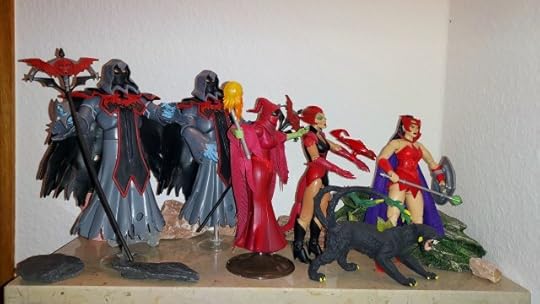 “Scorpia, Catra, you take the point. Wraiths, follow me.”
“Scorpia, Catra, you take the point. Wraiths, follow me.”
“Yes, Mistress.”
“Remember, girls, we are looking for the Lost Tomb of Sibor. Scorpia, since your people hail from the Crimson Waste, you have knowledge of this wasteland that the Horde lacks…”
“Yes, but…”
“So I get why you need Scorpia. But why am I here, Shadow Weaver?”
“Because you are Force Captain, Catra. And because Scorpia didn’t want to go without you.”
“I’ll get you for this, Scorpia.”
“So lead the way, Scorpia. You do know where the tomb is, don’t you?”
“Yes, but… I don’t think this is a good idea, Shadow Weaver. The Tomb of Sidor is an accursed place. My people shun it and never go there.”
“Silly barbaric superstition. The Tomb of Sidor contains something of great value to the Horde and I mean to retrieve it for Lord Hordak. And now go, Scorpia. Take us to the Tomb.”
“Yes, but it’s your funeral.”
“Is that a promise?”
“Hush, Catra, she’ll hear you.”
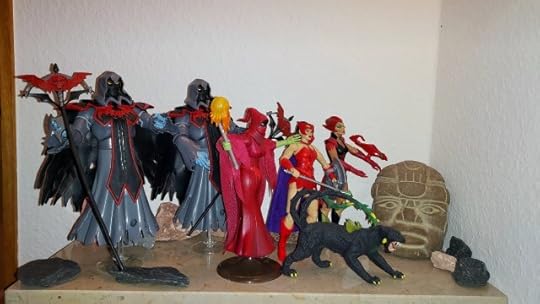
I don’t have any Egyptian looking trinkets in my collection, so this Olmec head my Dad brought back from Mexico years ago will have to do.
“Here we are.”
“The entrance to the Lost Tomb of Sidor. At last!”
“Are you really sure about this, Shadow Weaver? This place is shunned for a reason. The vile priest Sidor committed unspeakable acts, which is why he was sealed inside a tomb in the middle of the Crimson Waste, so he may never rise again.”
“Scorpia, I never took you for someone who believes in silly old fairy stories.”
 “So what’s the deal with this vile priest?”
“So what’s the deal with this vile priest?”
“According to ancient legends, the vile priest Sibor was infatuated with Naka-Ra, the daughter of King Kartan, ruler of the Crimson Waste. But Naka-Ra rejected Sibor, because he was disfigured by dark magic…”
“Yeah, we know something about that, don’t we, Scorpia?”
“Driven mad by unrequited love, Sibor murdered Naka-Ra. So King Kartan sentenced him to be mummified alive and then magically sealed inside a tomb in Crimson Waste for all eternity.”
“An excellent summary, Scorpia. The Lost Tomb was sealed via a spell from the Netherworld Tablet. A tablet I have recently managed to acquire for my personal library…”
“With all due respect, Shadow Weaver, but Scorpia is right. This vile priest murdered his girlfriend and is clearly dangerous. So why exactly do we want to break into his tomb?”
“To resurrect him, of course, as a servant to the Horde.”
“You want to resurrect Sibor the Vile?!?”
“Sibor was a powerful sorcerer, a master of dark magic. His skills will be very useful to the Horde.”
“You have plenty of dark magic of your own, Shadow Weaver. And you have… what are those creepy floating guys anyway?”
“Those are my Wraiths, mages from Mystacor who were captured by the Horde and enslaved by the power of the Black Garnet to do my bidding.”
“So if you already have two enslaved sorcerers, Shadow Weaver, what do you need this accursed priest for?”
“Because, my dear Catra, he might have knowledge of ancient Etherian magic that is beyond even my skills. And besides, you can never have too many evil sorcerers.”
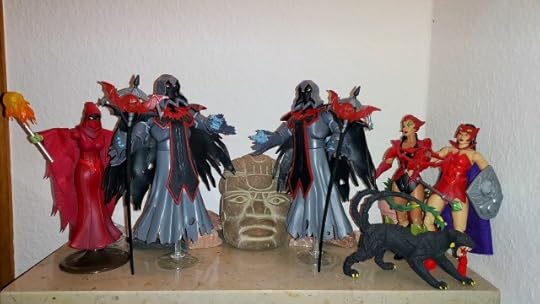 “Wraiths, I command you cast the spell of opening.”
“Wraiths, I command you cast the spell of opening.”
“Yes, Mistress.”
“I have a really bad feeling about this, Catra.”
“You and me both, Scorpia.”
Swoosh. Crackle. Groan.
“Is it just me or are Shadow Weaver’s Wraiths super-creepy?”
“It’s not just you, Scorpia. They are creepy. Shudder. Though on the plus side, if she has the Wraiths to boss around, maybe she’ll finally leave us alone.”
***
Later, inside the Lost Tomb of Sibor:
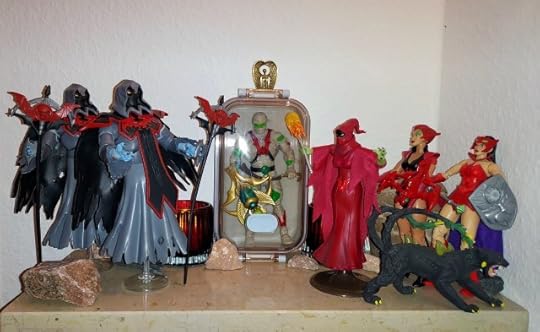
The sarcophagus of the vile priest Sibor is actually a bento box. The ornament on top of the sarcophagus is a stylized bronze angel I gave my Mom as a present once.
“Amazing. We are the first to lay eyes on the face of Sibor in a thousand years…”
“Personally, I’d have preferred if no one had laid eyes on his face for another thousand years.”
“Look, girls, how perfectly preserved his body is thanks to the embalming techniques of the ancients. Most fascinating.”
“I’d rather not look.”
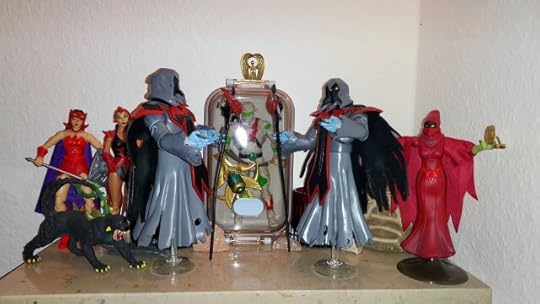
The Netherworld Tablet Shadow Weaver is holding is a golden cufflink of my Dad’s engraved with Egyptian imagery. It’s the only pair of cufflinks of my Dad’s that I kept.
“Wraiths, perform the spell of resurrection as laid down in the Netherworld Tablet.”
“Yes, Mistress.”
Groan. Creak.
“Yes, it’s working.”
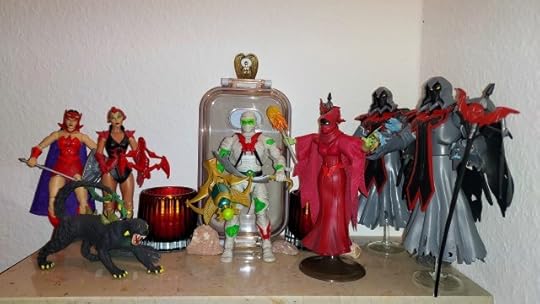 “I Am Alive. Sibor Lives Again.”
“I Am Alive. Sibor Lives Again.”
“Welcome back to the land of the living, Sibor. I am Shadow Weaver, second in command to Lord Hordak, Supreme Commander of the Mighty Horde Empire, and I have used the Netherworld Tablet to lift the curse that kept you imprisoned in this tomb…”
“Yeah right, Shadow Weaver lifted the curse. As if her creepy Wraiths didn’t do all the hard work.”
“Never forget that you owe your resurrection to the mercy of the Horde and that you must pledge fealty to Lord Hordak in order to remain alive….”
“Ahem, I am here and I am speaking to you as your mistress…”
“My Lady!”
“It’s looking at me. Why is it looking at me?”
“It’s shambling towards me. Scorpia, Shadow Weaver, help.”
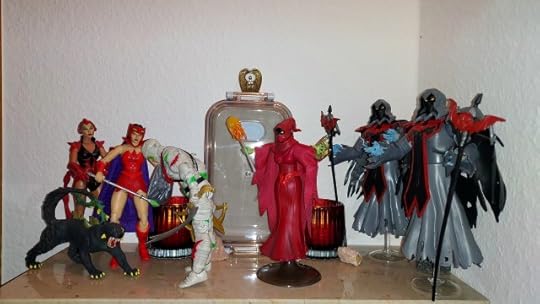 “My Lady, my Love, my Naka-Ra! I, Sibor, High Priest of Horokoth, am your most humble servant…”
“My Lady, my Love, my Naka-Ra! I, Sibor, High Priest of Horokoth, am your most humble servant…”
“Ahem…”
“I think he likes you, Catra. Snicker.”
“Fascinating. Most Fascinating. What an unexpected development!”
“Command and I shall obey, my Lady Naka-Ra.”
“You could start by taking a step back, bub. Cause you kind of reek. Also, have you never heard of personal space? Finally, my name is not Naka-Ra. I’m Catra.”
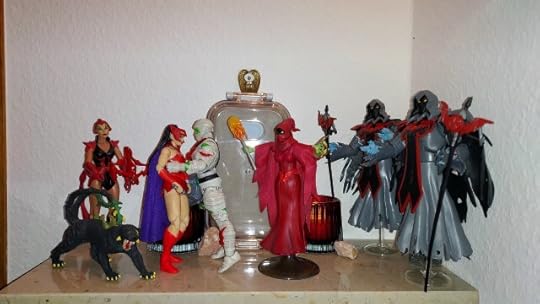 “But my Lady, do you no longer love me?”
“But my Lady, do you no longer love me?”
“Eeuw!”
“All this time, in the lonely prison of my tomb, I have dreamed of you and only you, my Lady. I dreamed of holding you, of feeling your warm, soft skin, your genle curves under my hands. I dreamed of holding you again, of loving you again…”
“Eeuw! Scorpia, Shadow Weaver, anybody, Help!”
“Most fascinating indeed…”
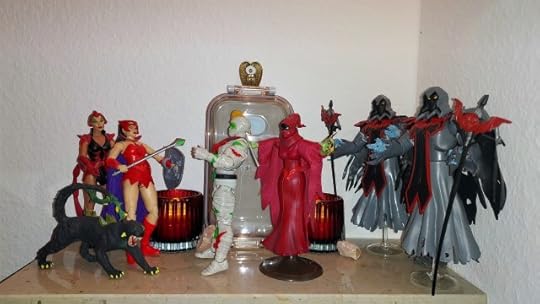 “Get off me, you creep! Or I swear I’ll grind you into mummy dust, so Shadow Weaver can use you for her magical concoctions.”
“Get off me, you creep! Or I swear I’ll grind you into mummy dust, so Shadow Weaver can use you for her magical concoctions.”
“But my Lady, my Naka-Ra, do you no longer love me?”
“Listen up and listen well: I don’t love you, I have never loved and I never will…”
“Yeah, dude, Catra only loves that despicable traitor Despara. Ask me how I know.”
“But my Lady…”
“Fuck, I don’t even know you. And for the last time, my name is not Naka-Ra.”
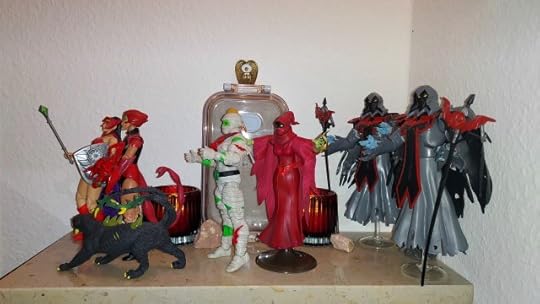 “Oh screw it, I’m outta here! Come on, Scorpia!”
“Oh screw it, I’m outta here! Come on, Scorpia!”
“My Lady, wait!”
“Most fascinating indeed. Hmm…”
***
Later, in Hordak’s Throne Room in the Fright Zone:
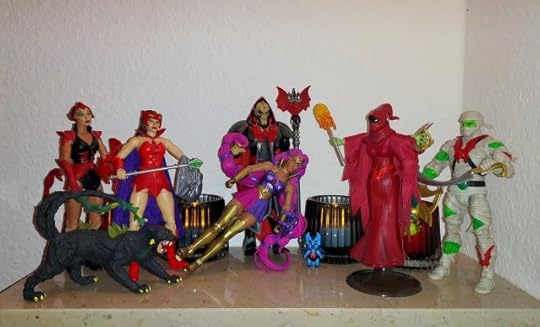
I don’t have a proper throne for Hordak unfortunately, since the 3D-printed Hordak thrones you can get on Etsy and eBay only work for the smaller Origins figures. But you get the idea.
“And one day, my Entrapta, I shall depose of my accursed brother and rule all of the cosmos and… – Who dares disturb us?”
“My sincerest apologies, Mighty Hordak, but I assumed you would want to meet our newest recruit at once.”
“Never dare to assume anything about me, Shadow Weaver. Still, it seems your mission was a success.”
“A most resounding success, Mighty Hordak. We managed to locate the tomb and resurrect Sibor using the Netherworld Tablet.”
“Hi Catra, hi Scorpia! How was the Crimson Waste? Did you find any interesting First Ones tech?”
“Is he… twirling her hair?”
“I told you so, Catra. Hordak and Entrapta are totally sleeping together.”
“Don’t be silly, Scorpia! How would that even work? I mean, does he even have a… well, you know what?”
“You’ve got to ask Entrapta that, not me. Giggle.”
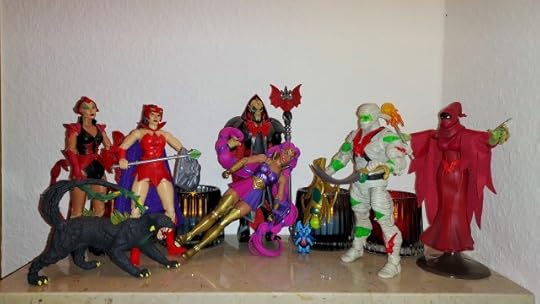 “Shadow Weaver, I would like to see my newest recruit.”
“Shadow Weaver, I would like to see my newest recruit.”
“Of course, Lord Hordak. May I present to you Sibor, High Priest of Horokoth, wielder of most mighty magics.”
“Sibor, eh? Too complicated. I think I’ll just call you Wrap Trap. So will you loyally serve me and the All-powerful Horde Empire, Wrap Trap?”
“Bow, fool. Lord Hordak is your master now. You only live and walk on his sufferance.”
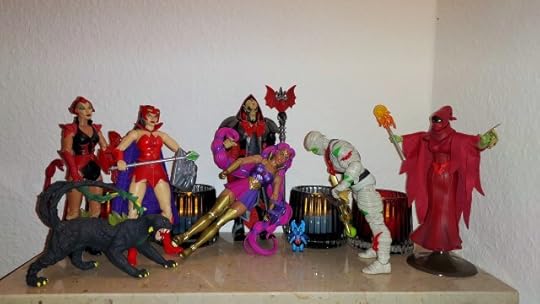 “My Lord, I thank you for reuniting me with my beloved Naka-Ra…”
“My Lord, I thank you for reuniting me with my beloved Naka-Ra…”
“He speaks. Fascinating.”
“He also reeks.”
“Shut up, Imp! So will you pledge your loyalty to me and of course to the All-mighty Empire, Wrap Trap?”
“My Lord, I shall pledge my loyalty to anyone who reunites me with my beloved Naka-Ra.”
“Shadow Weaver, who is this Naka-Ra he keeps speaking of?”
“Well, Lord Hordak, it seems that Sibor – I mean, Wrap Trap – has mistaken Force Captain Catra for his long-dead lover Naka-Ra.”
“Has he now? That’s… unexpected. And quite amusing.”
“Awww, you’ve got a new friend, Catra, That’s so sweet.”
“Shut up, Entrapta.”
“Due to Wrap Trap’s affinity for and infatuation with Force Captain Catra, I recommend assigning him to Catra’s Force Squad, Lord Hordak.”
“An excellent idea, Shadow Weaver. Wrap Trap, you are to report to Force Captain Catra at once.”
“I thank you Lord Hordak, for allowing me to serve under my beloved Naka-Ra once again.”
“I’m going to kill you for this, Shadow Weaver. One day I swear I’m going to kill you.”
***
Later, in the Crimson Waste:
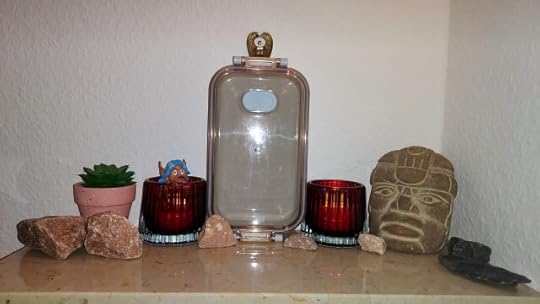 “Hi folks, it’s me, your friend Loo-Kee again. I hide everywhere, even in really scary places like a lost tomb in the Crimson Waste, to bring you the moral of today’s story, which is my sacred mission as appointed by the all-powerful Federal Communication Commission.”
“Hi folks, it’s me, your friend Loo-Kee again. I hide everywhere, even in really scary places like a lost tomb in the Crimson Waste, to bring you the moral of today’s story, which is my sacred mission as appointed by the all-powerful Federal Communication Commission.”
 “In today’s story, Wrap Trap is in love with Catra, but Catra is not in love with Wrap Trap. That’s okay, cause someone we fall in love with people who don’t feel the same. But Wrap Trap kept harassing Catra and tried to hug and kiss her, even though Catra didn’t want him to and said so, repeatedly. And that’s not okay. Cause consent is important, kids. Anyway, gotta go now, cause this tomb is really creepy and also dusty – hatchoo!”
“In today’s story, Wrap Trap is in love with Catra, but Catra is not in love with Wrap Trap. That’s okay, cause someone we fall in love with people who don’t feel the same. But Wrap Trap kept harassing Catra and tried to hug and kiss her, even though Catra didn’t want him to and said so, repeatedly. And that’s not okay. Cause consent is important, kids. Anyway, gotta go now, cause this tomb is really creepy and also dusty – hatchoo!”
***
Because Wrap Trap was never made as a figure in the vintage Masters of the Universe toyline, he never had a backstory either, so a new backstory for him was created for the Masters of the Universe Classics release, which basically took the plot of the movie The Mummy and transported it to Etheria. I mostly stuck to that backstory – with one exception. I made Catra rather than She-Ra the reincarnation of Wrap Trap’s lost love, because Catra dealing with a lovestruck mummy is a lot funnier. Plus, Catra looks a lot more like the reincarnation of a vaguely Egyptian princess than She-Ra.
In the Filmation She-Ra: Princess of Power series, Catra and Scorpia are rivals united only be their dislike for Adora. In the 2018 She-Ra and the Princesses of Power cartoon, they share a rather one-sided friendship, where Scorpia has a massive crush on Catra, while Catra is her usual prickly self and keeps pushing her away. Their relationship in this story is mostly based on the newer version.
Another thing I really liked about the 2018 She-Ra is the oddly endearing friendship/romance between Hordak and Entrapta, which I’ve decided to adopt for quite a few of my stories now. In fact, I tried to recreate the famous Esteban Maroto poster of Evil-Lyn draped at the feet of Skeletor’s throne (which like most of Maroto’s Masters of the Universe art was created for the German Masters of the Universe comics) with Hordak and Entrapta. I couldn’t quite get Entrapta in the right pose, but it still works, especially with Hordak twirling her hair.
The Horde Wraiths appeared in a handful of episodes of the 2002 He-Man and the Masters of the Universe cartoon as Hordak’s magic wielders and are basically stand-ins for Shadow Weaver as a way of getting around the She-Ra rights mess (legally, He-Man and She-Ra are considered separate properties, which is why it’s so difficult for She-Ra and her supporting cast both good and evil to appear in Masters of the Universe and vice versa). There was a Horde Wraith figure made in the Masters of the Classics toyline and I initially got one of them to complete the Evil Horde and then a second one, when I found one for a good price on eBay. There actually are three Horde Wraiths featured in the 2002 cartoon, but it’s unlikely I’ll get a third one unless he’s really cheap.
According to the bio created for the Horde Wraith figure, they are mages enslaved by Hordak to do his bidding, because enslaving people is what the Horde does. According to the bio, they Wraiths are Gar mages, which is why their hands are blue. However, there are no Gar in Etheria, so I made them mages from Mystacor enslaved by Hordak and Shadow Weaver to serve as Shadow Weaver’s personal flunkies instead.
Because their appearances in the 2002 cartoon are very limited, the Horde Wraiths hardly ever speak, though they chant a few spells. I actually checked what the Wraiths were chanting before writing their dialogue, but they basically just chant “Despondos, Despondos, Despondos”, when they try to banish King Grayskull to the dark and evil dimension of Despondos (spoiler alert: The spell backfires and Hordak and the rest of the Evil Horde wind up in Despondos instead), which is basically the equivalent of chanting “Bielefeld, Bielefeld, Bielefeld” when trying to banish someone to Bielefeld (which some folks would say is a worse fate than being banished to Despondos). So just borrowing the Wraiths’ chants from the 2002 cartoon was out.
There actually is a con-lang named Kudu-Kesh that was created for Masters of the Universe Revelation/Revolution, but again using that con-lang for the Wraiths was out, because Kudu-Kesh is an Eternian language and the Horde are on Etheria, a completely different world. So in the end, I just went the time-honoured route and had the Wraiths chant in Latin instead. At least, it’s reasonably correct Latin – unlike the time when an Irish spell to summon a demon in an episode of Buffy the Vampire slayer turned out to be a news item about bus lanes in Dublin instead. Not that summoning busses isn’t a lot more useful than summoning demons in most real world situations.
That’s it for today, folks. I hope you enjoyed this Masters-of-the-Universe-Piece Theatre Halloween Special, because there will be more.
Disclaimer: I don’t own any of these characters, I just bought some toys, took photos of them and wrote little scenes to go with those photos. All characters are copyright and trademark their respective owners.
October 20, 2024
Masters-of-the-Universe-Piece Theatre: “Puzzle Expanded”
It’s time for another Masters-of-the-Universe-Piece Theatre photo story. The name “Masters-of-the-Universe-Piece Theatre” was coined by Kevin Beckett at the now defunct Whetstone Discord server.
My Evil Horde recruitment ad continues to bear fruit, because I have now assembled almost all the Evil Horde members ever made in seven inch scale, though I’m still waiting for the Masterverse Deluxe Horde Troopers to be delivered. Once the Horde is complete, I will retake the epic Horde group shot.
One of the weirder members of what is a very weird group is Modulok, a sort of construction toy turned Horde scientist. I was recently able to acquire a Masters of the Universe Classics Modulok for a good price and promptly had some fun with him by having him join the Horde in the Masters-of-the-Univers-Piece Theatre toy photo story “Puzzle”, where resident Horde tech genius Entrapta tries to assemble Modulok’s body parts. Because that was Modulok’s deal. He had twenty-two body parts that could be assembled in different ways.
Modulok was clearly popular, because the following year Mattel introduced another build-your-own-monster character named Multi-Bot who functioned exactly like Modulok, only that he was a robot created by Modulok who was billed as the “Evil Robot of a Thousand Bodies”.
For even more fun, the Modulok and Multi-Bot pieces were interchangeable, allowing you to mix and match parts and also combine both Modulok and Multi-Bot into a creature called Megabeast. I didn’t build a Megabeast, but here is a video explaining how to build Megabeast with the original toys and here is a video explaining how to build Megabeast with the Classics figures. A Megabeast assembled only from Modulok parts also appeared in issue 2/86 of the German Masters of the Universe Magazine. Both the Classics and the original version require buying mutiple figures, so nope, not happening. Though Modulok has now been announced for Masters of the Universe Origins and I’ll probably buy an extra to make Megabeast, once Multi-Bot comes out.
I had a lot of fun playing around with Modulok and assembling him, so when I found a Classics Multi-Bot for a good price, I snapped him up as well. And of course, I decided to have some fun and have Modulok and Entrapta collaborate (reluctantly on Modulok’s part) to assemble him.
The Fright Zone, Modulok’s workshop:
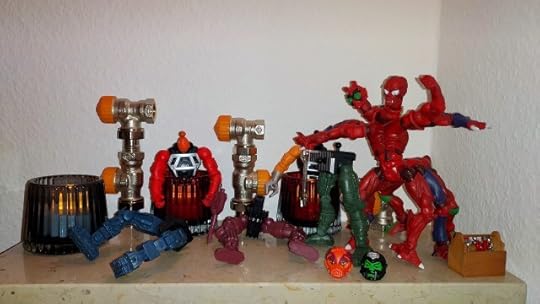 “I can’t wait to show my latest invention to Hordak. Perhaps now that I am about to provide him with the ultimate weapon, he will finally recognise my genius. Maybe I will be appreciated at last. And maybe, Hordak will finally make me chief scientist of the Horde rather than… that silly pink and sparkly girl.”
“I can’t wait to show my latest invention to Hordak. Perhaps now that I am about to provide him with the ultimate weapon, he will finally recognise my genius. Maybe I will be appreciated at last. And maybe, Hordak will finally make me chief scientist of the Horde rather than… that silly pink and sparkly girl.”
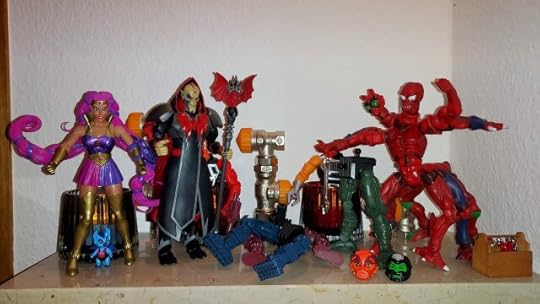 “Lord Hordak! And… Entrapta – sigh, why did he have to bring her? What is it about her, sigh?”
“Lord Hordak! And… Entrapta – sigh, why did he have to bring her? What is it about her, sigh?”
“Hey, don’t forget me!”
“And Imp, of course. That little annoying piece of…”
“Modulok, did you actually summon me for a reason or are you just going to stand around there muttering to yourself? Cause I still have a planet to conquer and a rebellion to crush, so don’t waste my time.”
“A… apologies, Lord Hordak. I… I summoned you, because I wanted to show you my latest invention. It’s the ultimate weapon that will help you to conquer Etheria and crush the rebellion. I call it…”
“Robot parts! Look, Hordak, robot parts!”
“Sigh…”
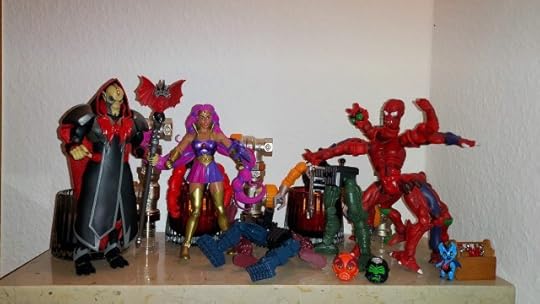 “Wow, there’s three sets of legs and two torsos and four arms and two heads and…”
“Wow, there’s three sets of legs and two torsos and four arms and two heads and…”
“Don’t touch that! Don’t touch anything!”
“You were saying, Modulok?”
“Ahem, this is self-assembling war-bot 2312, also known as Multi-Bot, the Robot of a Thousand Bodies. He can assemble himself into any shape you please, a tank, an aircraft, a warrior, a battalion of warriors, making him the ultimate weapon…”
“That’s sooo cool.”
“…what is more, I can also add 2312’s components to my own body, turning myself into Mega-Beast, the ultimate warrior…”
“Wow, that’s even cooler.”
“That sounds very impressive, Modulok, but right now I’m seeing only a mess of body parts.”
“Because 2312 is still disassembled. But if you’ll allow me to demonstrate…”
“Can I help?”
“No, you’ll only break things.”
“As I said, Modulok, I have better things to do than wait for you to put your new robot together. So call me when he’s actually ready. And now assemble your robot. Entrapta will help.”
“But sir…”
“Entrapta will help, Modulok. And Imp will watch to make sure that you play nicely together. That’s my final word.”
“Sigh. What have I done to deserve this?”
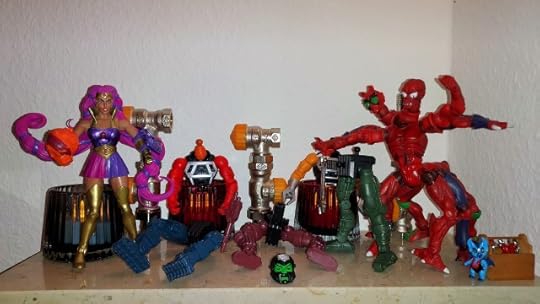 “Okay, so where do we start with putting him together?”
“Okay, so where do we start with putting him together?”
“We don’t start at all. I’ll start. And put that down!”
“That’s a great robot head. Love the bright orange colour.”
“I said, Put that down!”
“Careful, Modulok. Hordak said play nice with Entrapta. And Hordak gets very angry when people are mean to Entrapta. And trust me, you don’t want to see Hordak angry.”
“Shut up, you little flying pest! And you, put that down! You’ll only break it.”
“I promise, I’ll be very careful. And besides, I’m a scientist and you can’t do science without sometimes breaking things or blowing them up. I thought you knew that, cause you’re a scientist, too.”
“I never break things or blow anything up.”
“Oh yes, and what about that portal generator you promised you’d build for Hordak? You know, the one that blew up and knocked out a whole squadron of Troopers along with it.”
“Shut up, Imp! That was… an accident.”
“You silly girl! Those are just heads with legs. They don’t have arms. How are they supposed to hold weapons?”
“Oh, I thought they could shoot laser beams out of their eyes. Cause that would be really cool.”
“Fix them, you stupid girl!”
“But you wanted arms.”
“Arms, not legs. Now he’s just got four legs and still no arms. Argh, I’ll just do it myself.”
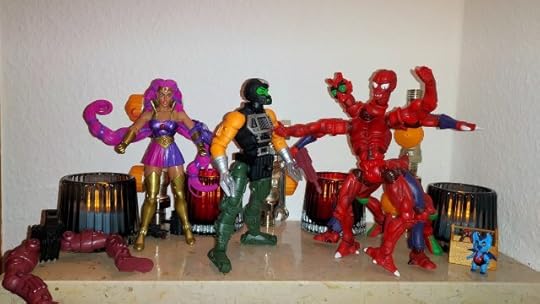 “There, that’s better. Much better. One robot warrior with two legs, two arms, one torso, one head and one very handsome face, if I may say so myself. I modelled it after Force Captain Keldor, you know?”
“There, that’s better. Much better. One robot warrior with two legs, two arms, one torso, one head and one very handsome face, if I may say so myself. I modelled it after Force Captain Keldor, you know?”
“Yeah right, you should know how many arms, legs and heads a person is supposed to have, Modulok. Also, your robot looks nothing like Keldor.”
“Shut up, Imp.”
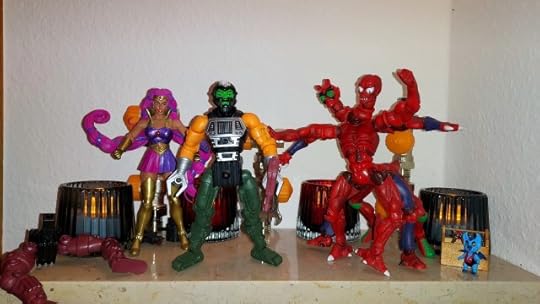 “Isn’t he impressive? Isn’t he handsome? Isn’t he menacing? Is he not going to strike fear into the hearts of those accursed rebels?”
“Isn’t he impressive? Isn’t he handsome? Isn’t he menacing? Is he not going to strike fear into the hearts of those accursed rebels?”
“I don’t think you can be both handsome and menacing at the same time, but he is cool. I think we should call him ‘Dean’.”
“His name is serial number 2312.”
“But that’s boring.”
“It’s logical.”
“Talking of logical, what’s that nub on the front for.”
“That’s…. ahem… a connection piece.”
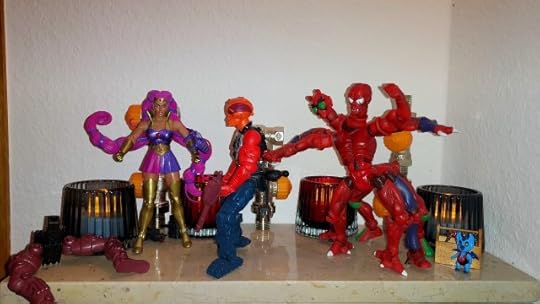 “Look, I’ve assembled the other one. With proper arms. I think I’ll call him Sam.”
“Look, I’ve assembled the other one. With proper arms. I think I’ll call him Sam.”
“His name is serial number 2312.”
“But you already called Dean that.”
“This one is serial number 2312-2, the other one is serial number 2312-1.”
“But that’s boring. And confusing.”
“It’s logical and… Argh, what is that?”
“What’s what?”
“That thing on his butt?”
“Oh, that. I gave him a tail.”
“Robots have no tails, you stupid girl!”
“But they have ‘connection pieces’ on their pelvis…”
“Shut up, Imp.”
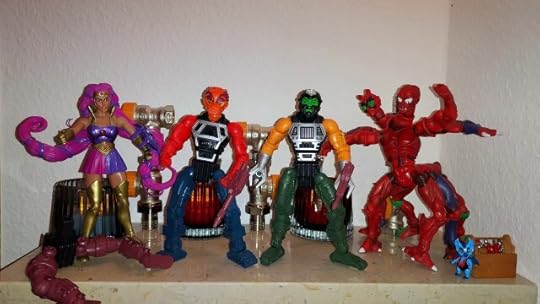 “Success. Two robot warriors to fight for the glory of Lord Hordak.”
“Success. Two robot warriors to fight for the glory of Lord Hordak.”
“Great job, Modulok! Sam and Dean look awesome all put assembled.”
“For the last time, their names are 2312-1 and 2312-2, not Sam and Dean.”
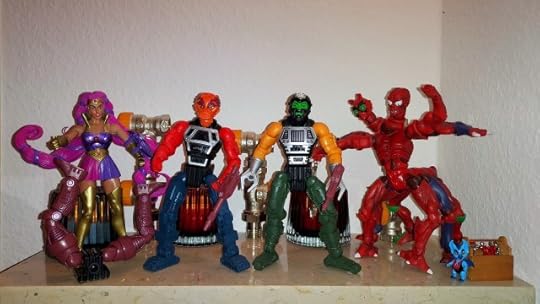 “Uhm, Modulok, I think we made a mistake. We have a pair of legs left over.”
“Uhm, Modulok, I think we made a mistake. We have a pair of legs left over.”
“I never make mistakes. Two legs are so unstable and insufficient…”
“Oh, I understand. You want your robots to have more legs like you do.”
“More legs mean more stability, more connectability, more power. Because connectability is power…”
“Oh dear, he’s off on one of his rants again.”
“Shut up, Imp! True, 2312 may look like two robot warriors with a pair of extra legs, but they are so much more than the sum of their parts. Behold the true power of connection…”
“That’s super-cool. But… uhm… his heads look in different directions. How does he decide in what direction to walk?”
“Better question: How will he walk at all, considering he’s fused together at the butt?”
“Like a crab. Multi-Bot walks like a crab. Sideways. Arrrgh, why am I cursed with ignoramuses like you two questioning my genius?”
“What genius?”
“It’s okay, Modulok. Sometimes, we only notice flaws and imperfections, when we put our inventions together.”
“I have no imperfections. My inventions are perfect. Perfect!”
“That’s all right. Imperfections are beautiful.”
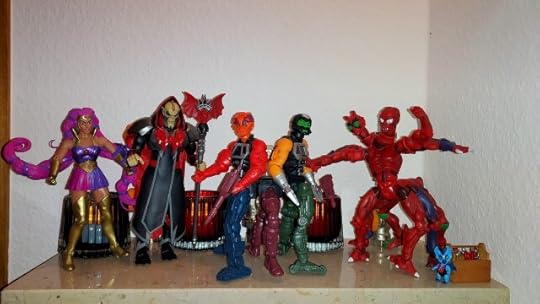 “Lord Hordak, may I present Multi-Bot, the ultimate warrior, the robot of a thousand bodies and a thousand configurations.”
“Lord Hordak, may I present Multi-Bot, the ultimate warrior, the robot of a thousand bodies and a thousand configurations.”
“Hmm, interesting. Very interesting. But why do both heads look in different directions?”
“So he can see the enemy coming from both sides and fire in two directions at once.”
“Very interesting. But how does he walk, when his heads look in different directions?”
“Why do I always have to repeat myself? He walks sideways…”
“Like a crab.”
“Like a crab. That’s brilliant, my Entrapta.”
“Yes, it’s brilliant because it was my idea. Harumph.”
***
Later:
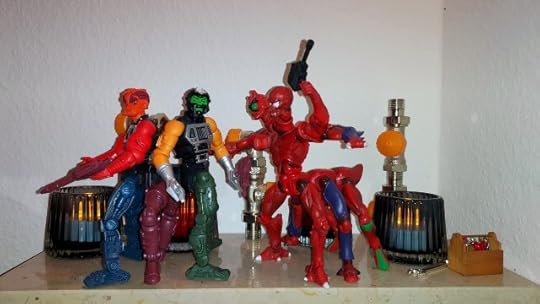 “Ah, 2312, I wonder what Hordak sees in that Entrapta person. True, she is… not bad as an engineer, but she’s also so unserious and silly. What does she have that I don’t? Am I not the smartest and most devious scientist in the Horde? Why does Hordak not appreciate me? Now Captain Keldor, that was a man. Handsome, dashing and he actually listened to me and praised me once in a while. But of course, Hordak had to drive him away. Sigh. Well, at least I have you to talk to now, 2312. Cause that’s the true reason I built you, to have someone to talk to who appreciates my genius, when talking to my second head isn’t enough. You do appreciate my genius, don’t you, 2312?”
“Ah, 2312, I wonder what Hordak sees in that Entrapta person. True, she is… not bad as an engineer, but she’s also so unserious and silly. What does she have that I don’t? Am I not the smartest and most devious scientist in the Horde? Why does Hordak not appreciate me? Now Captain Keldor, that was a man. Handsome, dashing and he actually listened to me and praised me once in a while. But of course, Hordak had to drive him away. Sigh. Well, at least I have you to talk to now, 2312. Cause that’s the true reason I built you, to have someone to talk to who appreciates my genius, when talking to my second head isn’t enough. You do appreciate my genius, don’t you, 2312?”
“Our names are Sam and Dean.”
“Aaarrrgh!”
***
Even later:
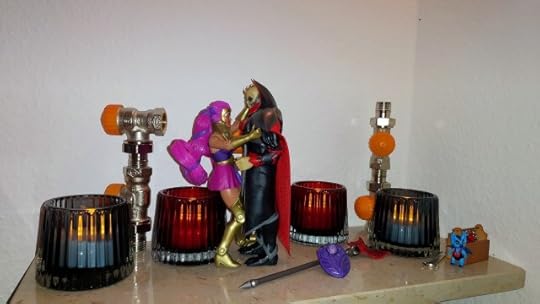 “My sweet Entrapta. I hope Modulok wasn’t too mean to you. I know his manners are abominable and trust me, he will be punished, if he insulted you. But he does have his uses.”
“My sweet Entrapta. I hope Modulok wasn’t too mean to you. I know his manners are abominable and trust me, he will be punished, if he insulted you. But he does have his uses.”
“That’s okay, Hordak. Modulok is just a little grumpy. And you used to be grumpy, too, before we were friends.”
“Oh my Entrapta, one day I hope we shall be more than friends. One day, I will overthrow my accursed brother and take the throne of the Horde Empire and then you, my Entrapta, you will be my queen.”
SMOOCH!
“Oh, I can’t watch when they do that. It’s just so weird, like watching your parents do… well, you know what. Time to scoot.”
***
Still later:
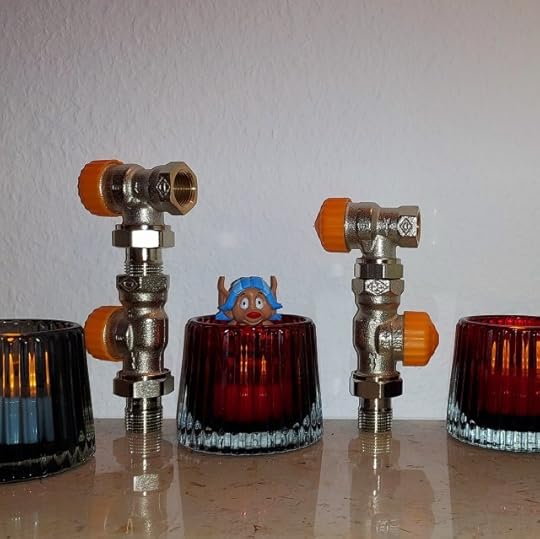 “Hi, it’s me, Loo-Kee. I hide in places, even scary places like the Fright Zone. And then, when no one is looking, I come out to tell you the moral of the story you just witnessed. Cause you see, every story has to have a moral. That’s – like – a universal cosmic law, established by the all-powerful council of the Federal Communications Commission. Not that I’ve ever met them, but I guess they’re like the Trollan Council of Mages or the Cosmic Enforcer Corps, really powerful and a little scary.”
“Hi, it’s me, Loo-Kee. I hide in places, even scary places like the Fright Zone. And then, when no one is looking, I come out to tell you the moral of the story you just witnessed. Cause you see, every story has to have a moral. That’s – like – a universal cosmic law, established by the all-powerful council of the Federal Communications Commission. Not that I’ve ever met them, but I guess they’re like the Trollan Council of Mages or the Cosmic Enforcer Corps, really powerful and a little scary.”
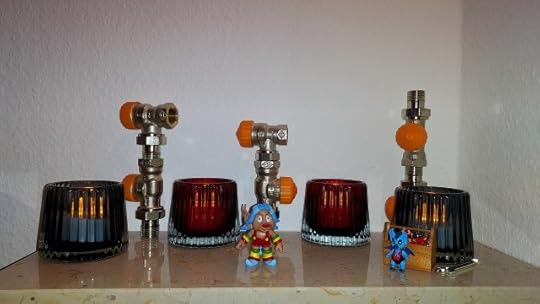 “Today’s story was about building robots. But it’s also a story about friends and about liking people. Hordak is really, really scary and terrible and an all-around awful person, but he also likes Entrapta and Entrapta likes him. Because even terrible people have friends. And Modulok is lonely, because he used to like Captain Keldor – who later became Skeletor and is really scary and terrible as well – but then Hordak drove Keldor away. And because Modulok is so lonely, he built himself a robot friend. But you can’t build yourself friends. Meanwhile, Modulok doesn’t realise that Entrapta wants to be his friend… – well, not like she’s Hordak’s friend, but you know what I mean.”
“Today’s story was about building robots. But it’s also a story about friends and about liking people. Hordak is really, really scary and terrible and an all-around awful person, but he also likes Entrapta and Entrapta likes him. Because even terrible people have friends. And Modulok is lonely, because he used to like Captain Keldor – who later became Skeletor and is really scary and terrible as well – but then Hordak drove Keldor away. And because Modulok is so lonely, he built himself a robot friend. But you can’t build yourself friends. Meanwhile, Modulok doesn’t realise that Entrapta wants to be his friend… – well, not like she’s Hordak’s friend, but you know what I mean.”
“You again! Alert, Troopers, we have a rebel spy in the Fright Zone. I repeat, there’s a rebel spy in the Fright Zone.”
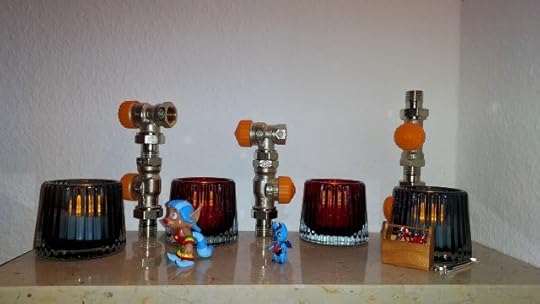 “Oops, I’ve been discovered. Gotta go. But remember, everybody deserves friendship and love, even scary and terrible people like Hordak and Keldor and Modulok and…”
“Oops, I’ve been discovered. Gotta go. But remember, everybody deserves friendship and love, even scary and terrible people like Hordak and Keldor and Modulok and…”
“Just wait till I’ll get you, rebel scum! Then Lord Hordak will send you to Beast Island or lock you up in his private zoo.”
“…and even a pest like Imp. Because love and friendship makes everybody a better person. Bye for now.”
***
I borrowed the relationship between Hordak and Entrapta from the 2018 She-Ra and the Princesses of Power cartoon, because I found it oddly endearing, both Hordak being besotted with Entrapta and Entrapta totally failing to be scared of Hordak. I have mixed feelings about the 2018 She-Ra and should probably articulate them in a separate post, but I love what they did with Entrapta’s character.
Modulok’s crush on Keldor was inspired by the Masters of the Universe Revolution prequel comic mini-series, where Modulok is Keldor’s science officer aboard the Horde Cruiser he commands, which is made even funnier by the fact that Modulok was conceived to be Mr. Spock, but evil, by J. Michael Straczynski, who created the character’s backstory, whereas Keldor is literally voiced by William Shatner, Captain Kirk himself.
Entrapta appears to be a secret Supernatural fan, while Modulok has apparently read Henry Kuttner (and yes, the Gallegher stories were solo Kuttner according to C.L. Moore, who should know).
Loo-Kee, meanwhile, does what he does best, namely deliver the moral of the story.
That’s it for today, folks. I hope you enjoyed this Masters-of-the-Universe-Piece Theatre Photo Story, because there will be more. I also have a Halloween Special planned, so stay tuned.
Disclaimer: I don’t own any of these characters, I just bought some toys, took photos of them and wrote little scenes to go with those photos. All characters are copyright and trademark their respective owners.
September 28, 2024
Into the Heart of the Ruhrgebiet: Cora’s Adventures at the 2024 Toyplosion in Castrop-Rauxel, Part 3: The Trip Home with Bonus Mineshaft Elevator Tower
Last Sunday, I attended the 2024 Toyplosion vintage toy con in Castrop-Rauxel. For the roadtrip to get there and some views of the city, see part 1 and for the con itself as well as my haul, see part 2.
By the time, I made it back to my car and had all my purchases safely stored in the trunk, it was maybe a quarter to four. The con was set to close at four PM, so I’d made the most of this adventure and I had a glorious haul to show for it.
However, before embarking on the long trip home, I made one more stop in Castrop-Rauxel. For during my quest to find an ATM, I had spotted a mineshaft elevator tower in the distance. And because mineshaft elevator towers are the iconic sight of the Ruhrgebiet, I of course wanted to visit it.
Mine Erin:Since there is no more coal mining in the Ruhrgebiet – the last coal mine closed down in 2018 – there of course was no active mine attached to the elevator. Instead, the mineshaft elevator stood in the middle of a roundabout in an office park, looking a little forlorn.
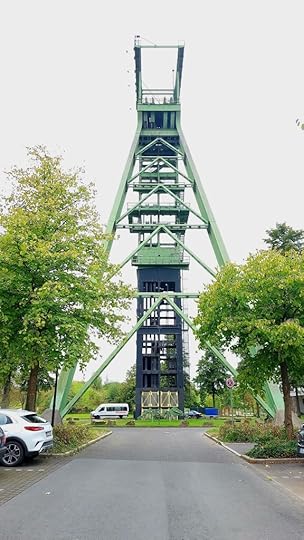
In the middle of a roundabout in an office park rises a reminder of the Ruhrgebiet’s industrial past.
I parked the car and walked around the mineshaft elevator tower, startling a few dog walkers. Mine shaft elevator towers usually have a big sign with the name of the mine and this one was no different. And the sign on top of the tower said “Erin”.

The mineshaft elevator tower viewed from the side. Note the name “Erin” on top of the tower.
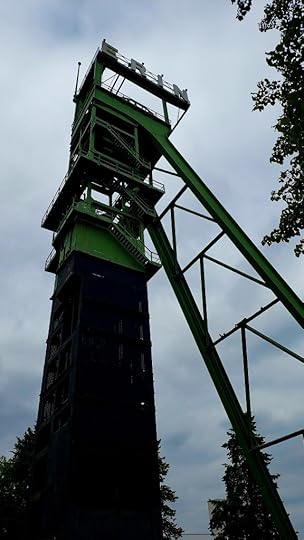
A better look at the “Erin” sign on top of the mineshaft elevator tower.
Now it’s quite common for German coalmines to have names. However, German coalmines are have names like Germania or Teutonia or Concordia or Zollverein or St. Bonifacius or Zollverein or Monopol or Heinrich Robert or Count Friedrich or Queen Elisabeth or Victoria Auguste or Sophia Jacoba or Ottilia or – if the mine was in former East Germany – Karl Liebknecht or Ernst Thälmann. Erin, however, sounds much more like an Irish maiden than a coalmine in the Ruhrgebiet.
Turns out that there is a reason for this, for the coalmine Erin was established in 1867 by William Thomas Mulvany, an Irish geologist and entrepreneur who came to the Ruhrgebiet in the 1850s in search of business opportunities that were difficult for a Catholic Irishman to access in Ireland under British rule. He wound up founding and operating several mines in the Ruhrgebiet and gave them all names relating to Ireland such as Hibernia, Shamrock and of course Erin. One of the companies he founded survived as Hibernia AG until 1970, when it was gobbled up by VEBA, not the e.on corporation. Here’s a nice profile of Mulvany from the Irish Times. I certainly did not expect Irish entrepreneurs founding coalmines in the Ruhrgebiet, which goes to show that history is a lot more complex than simple stereotypes. Though it’s also telling that as someone who’s not from the Ruhrgebiet, I know the names of the German coal and steel of the 19th century, but not Mulvany’s name. Though the city of Castrop-Rauxel named the office park around the mineshaft elevator tower after Mulvany.
William Thomas Mulvany only ran the Erin for ten years until 1877, when he went bankrupt. The mine was sold off and continued to operate under new management until the great mine dying of the 1980s. Mine Erin closed for good in 1983. Here is what it looked like the year it closed.
But even though the mines are gone, the mineshaft elevator towers – and sometimes the entire plant – remain as landmarks and reminders of the Ruhrgebiet’s industrial past. Indeed, if you’re into industrial history and architecture, the Ruhrgebiet is the place to visit.

The Erin mineshaft elevator tower seen from the rear.
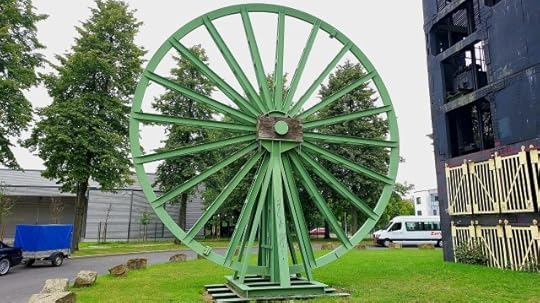
Elevator wheel of the Erin mineshaft elevator.
This particular mineshaft elevator tower was built in 1953 and was the final elevator tower built at the Erin mine before its closure. In addition to the office park, much of the former premises of the Erin mine have been turned into a park. Indeed, another thing about the Ruhrgebiet which doesn’t match the stereotypes is that the Ruhrgebiet is green. Yes, the region is very densely populated, but there are also a lot of nature preserves and parks, many of them literally built on top of former coalmines, belying those (mostly American) pro-nuclear-power trolls who always scream how dangerous and toxic coal is. I got into an argument with one of those pro-nuclear-power trolls maybe a week before my Ruhrgebit excursion and he screamed at me that coal is so toxic that nothing grows there. Of course, it’s possible that coal in the US really is more toxic than coal from the Ruhrgebiet, but I still told him, “Dude, there are literally parks growing on top of former mines in the Ruhrgebiet.”
There actually is another surviving mineshaft elevator tower of the Erin mine, which dates from 1929. I did not get see this one in person, because it’s on the other side of Castrop-Rauxel, though I’ll definitely visit the next time I’m in the area, perhaps for Toyplosion 2025. Or maybe I’ll just do a day trip to the Ruhrgebiet to visit historical mineshaft elevator towers and industrial sites.
The fact that the two surviving mineshaft elevator towers of the Erin mine are on opposite sides of town also means that the Erin mine once stretched under the entire city and the ground is riddled with mine tunnels, though many of them were likely filled in for stability. It’s not just Castrop-Rauxel either – the entire Ruhrgebiet is riddled with former mine tunnels, which actually is a great premise for a horror story about things living down there in the dark, surviving and even thriving after the humans have gone.
Bakery GeipingAfter my excursion to the Erin mineshaft elevator tower, I finally embarked on the trip home. However, it had been a long day and I had barely driven back onto the Autobahn that it occurred to me that I’d really like a cup of coffee and a piece of cake to fortify myself for the trip ahead. There was coffee available at the con, but the other attendants said it was bad and expensive, so I didn’t get any coffee there, but planned to stop somewhere on the way home.
There was only one problem. Cafés and bakeries in Germany usually close at five or six PM and it was almost half past four PM by now. Which meant that if I wanted a cup of coffee and a piece of cake, I needed to find a bakery café now or I would be stuck with the underwhelming service stations and Autohöfe along the highway.
So I left the Autobahn at the next exit, which happened to be called Dortmund-Lanstrop, and checked Google Maps for the nearest open bakery. Turned out that even thought the exit was called Dortmund-Lanstrop, the city of Dortmund was actually quite a way off, which is a common issue with German highway exits. Instead, the nearest town was called Lünen. And yes, they used to have a coalmine and still have a mineshaft elevator tower and a really interesting one, too, though I didn’t visit it, because I didn’t know it existed. Honestly, I want to do an industrial history day trip to the Ruhrgebiet now.
But I was in Lünen for coffee rather than sightseeing and so I found Bakery Geiping, a bakery chain established in 1924, which has branches all over the Münsterland and northern Ruhrgebiet. The Lünen branch was located next to an Aldi store in a residential neighbourhood. I was lucky, because it was half past four and they were due to close at five PM. Since it was half an hour before closing time, the bakery no longer had any cake left, so I just had a coffee. Then, fortified and alert, I returned to the Autobahn.
Service Station Tecklenburger Land:Even though it was Sunday, the Autobahn was a lot busier now than it had been that morning with returning holidaymakers and daytrippers as well as weekend commuters heading back to their workplaces. There was also a fair number of trucks, for even though the Sunday truck ban on German roads lasts until ten PM, there are exceptions for trucks transporting perishable or otherwise urgent goods. And so all the trucks that supply supermarkets and gorcery stores with fresh produce were on the road again by this point.
About an hour later, while I was driving through the Münsterland and the northern edge of the Teutoburg Forest, I found myself getting tired again, so it was time for another pit stop. Dad rarely made coffee pit stops during roadtrips, at least not when I was a kid. Though as he grew older, we’d sometimes stop for an ice cream. However, I have decided for myself that if I need a pause while on the road, I will stop for a coffee, because it keeps me alert and makes me a safer driver. Besides, I’m not beholden to anybody but myself and can stop whenever and wherever I feel like it.
However, by now, all the bakery cafés were be closed, so my only option was a service station or Autohof. So I pulled into Service Station Tecklenburger Land and had another coffee as well as a giant chocolate chip cookie from the service station coffee shop.
While I was sipping my coffee and enjoying a panoramic view of the parking lot and Autobahn A1, I chanced to witness an altercation between the lady behind the counter and a bearded male customer. The service station was largely deserted, so once the male customer sat down, I used the pretext of taking my mug and plate back to the coffee counter rather than using the tray return to ask the lady behind the counter if everything was okay or if she needed help. She thanked me and said she was fine. Unruly customers are sadly part of her job.
Rastplatz Langwege-East:After this pit stop, I was off again, headed for the 33 kilometer monster construction zone between exits Bramsche and Lohne-Dinklage. They’re widening the A1 from four to six lanes there, closing the sole gap between Hamburg and Osnabrück, where the extremely busy A1 is only four lanes instead of six. In theory, this is a very good thing. In practice, it’s a terrible hassle, especially since the construction zone is so long. Not sure why they have to do it in one go rather than splitting it up into shorter segments.
In the morning, I had passed the monster construction zone without issues or delays, because there was little traffic. Now in the early evening, there was a lot more traffic. There also was a traffic jam, because a van had broken down on the road, narrowing the already narrow highway even further. I felt sorry for the people in the van – they looked like a band or something – because they were stuck in an extremely dangerous area with nowhere else to go.
Once I finally made it through the monster traffic jam, I realised something alarming. I was getting tired again and I mean really tired. And I still had twelve kilometers or so of construction zone ahead of me. I needed a break – now – but what to do? Usually, I would have stopped at service station Dammer Berge with its striking bridge restaurant, but I’d passed that some kilometres ago. I’d also passed exit Holdorf where there was an Autohof with a McDonalds and a Kentucky Fried Chicken. And the next exit Lohne/Dinklage, which also has an Autohof (and actually a decent restaurant that’s not a fast food chain) was still a way ahead.
So I did what my Dad always did in such situations, when he was on a long drive and found himself getting dangerously tired. I pulled into the next parking and rest area, which happened to be called Langwege-East (Langwege-West is on the other side of the A1).
Parking and rest areas are the most common and also most basic stopping points along German Autobahnen. There are parking spaces for trucks and cars, there are a few picnic tables and nowadays, there’s usually a public toilet of highly questionable cleanliness. In short, you only stop here, if you have no other choice.
So I parked my car, locked the doors, reclined the driver’s seat, set the alarm on my phone for fifteen minutes, closed my eyes and dozed for a bit, which is what Dad always did in such situations. Yes, my Dad practiced power napping well before it was a thing.
Once I opened my eyes again, I ate some of the chocolate I’d taken along as provisions. While I was munching the chocolate, I chanced to witness a bunch of young men pouring out of the back of a van to peruse the toilet at the rest area. Of course, they might have been workers on route to a job or a band on the way home from a gig, but personally I suspect they were undocumented immigrants.
Germany is currently having a moral panic about illegal immigrants who stab people and rape women. Like all moral panics, it’s silly and completely overblown, but instead of ignoring that crap and waiting for the panic to die down, our sorry excuse for a government felt the need to do something to reassure the population or at least the xenophobes among them and decided to reintroduce border controls at all German borders, blatantly violating the Schengen agreement. The border controls were set to go into effect the following day, so it would make sense for people smugglers to simply transport their human cargo on the weekend before. Not that those border controls will truly deter any undocumented immigrants or the people who make money smuggling them, because Germany has a lot of borders and a lot of border crossings and not nearly enough personnel to control all of them. All this border control initiative will achieve is annoy truckers and people who commute across the border to work, shop or go to school.
Somewhat refreshed, I set off again and drove through the last twelve kilometers or so of the monster construction zone. Should I still feel tired, I would exit the A1 at Lohne/Dinklage and have a coffee and maybe dinner at the Autohof there, which actually has a pretty good restaurant and not just fast food chains. Alternatively, I could also stop at the Autohöfe at the exits Vechta and Cloppenburg (neither of which is even remotely near the cities they’re named after) or service station Wildeshausen.
However, my power nap at Rastplatz Langewege-East and the chocolate had done their job. I wasn’t tired anymore and since it was getting dark, I decided not to stop for dinner, but head straight home.
That is, I did stop once more at a gas station approx. six kilometers from home to refuel my car, because my tank was somewhat depleted and diesel was cheap. I was home at around eight PM, where I unpacked my haul, had a cup of instant noodles for dinner and went to bed, because I was very tired.
All in all, I really enjoyed my trip to Toyplosion and will definitely go again next year. In general, I find that I enjoy the occasional road trips I’ve been going on this year and that I also enjoy exploring cities and places where I’ve never been, so expect more road trip reports in the future.
September 17, 2024
Into the Heart of the Ruhrgebiet: Cora’s Adventures at the 2024 Toyplosion in Castrop-Rauxel, Part 1: The Trip Out and City Views
I had a big translation job to finish (unfortunately, I do have to earn a living), so I still haven’t gotten around to writing up my adventures at the 2024 Worldcon in Glasgow, Scotland, and the 2024 Eurocon in Rotterdam, the Netherlands.
Though I have been active elsewhere and so you can listen to Brian Collins, David Agranoff and me discuss the 1943 science fiction story “Mimsy Were the Borogoves” by Lewis Padgett a.k.a. Henry Kuttner and C.L. Moore at the Postcards from the Dying World podcast. I was also at Galactic Journey again, talking about Bran Mak Morn by Robert E. Howard and Jirel of Joiry by C.L. Moore as well as a wide-reaching criminal law reform in West Germany in 1969, which decriminalised gay relationships between consenting adult men. With bonus 1969 campaign posters.
However, the 2024 con season isn’t over yet and so I was on the road again this Sunday, headed for Toyplosion, a vintage toy convention in the town of Castrop-Rauxel in the Ruhrgebiet. This was only the second ever Toyplosion. I was considering attending the first one last year, but my Dad was already in hospital at the time, so I didn’t go.
After my epic roadtrip to the Los Amigos Masters of the Universe convention in Neuss in May and the equally epic roadtrip to Eurocon in Rotterdam last month, I wasn’t overly worried about whether I could make the trip all alone, because I knew I could. Besides, the trip to Castrop-Rauxel is shorter than the one to Neuss, let alone Rotterdam.
The 2024 Toysplosion was a two day convention. I initially wanted to go on Saturday, but the pre-sale tickets were already sold out, so I decided to go on Sunday instead. This turned out to be a good decision, because there was less traffic on Sundays than on Saturdays, at least on the trip outwards.
The Trip OutUsing the trip to the Los Amigos convention in Neuss as a model, I got up at half past five AM on Sunday morning and set out at approx. a quarter past six. Unlike the trip to Neuss, it was still dark outside when I left. The sun currently rises at seven AM and sets at half past seven PM.
I headed to Groß Mackenstedt and drove onto highway A1. Because of the early hour and because trucks are not allowed to drive on German roads on Sundays – with exceptions for perishable cargo and other emergencies, there was very little traffic, as little as I’ve ever seen on the normally extremely busy A1. And so I made good time, as I drove through misty fields. I passed Wildeshausen and even the 33 kilometers monster construction zone between the exits Lohne Dinklage (yes, the town is named like the actor, though no one knows, if there’s any connection) and Bramsche was less torturous than usual, because there was so little traffic.
This time around, I bypassed service station Dammer Berge, because I’ve seen the bridge restaurant now and I wasn’t in the mood for soapy coffee and gloopy cake. Instead, I planned to head to one of the many Autohöfe (basically truck stops just off the highway, whereas service stations are directly on the highway) along the A1 for coffee and breakfast. Because they’re not directly on the highway, Autohöfe are generally cheaper and the food quality is better as well.
Once I’d driven past Osnabrück and crossed the Teutoburg Forest into the Münsterland, I started looking for Autohöfe. Alas, the next two I passed, Ladbergen and Hamm-Bockum, only had Burger King and McDonald’s on offer and I was in the mood for neither. In fact, I hate it that German highway service stations and truck stops are increasingly dominated by fast food chains like McDonald’s, Burger King, Kentucky Fried Chicken and Nordsee rather the more individual greasy spoons of yore.
Turn Right at Kamener KreuzBy now it was around eight o’clock and the road signs announced that the Kamener Kreuz, a cloverleaf junction that is one of the oldest and busiest in Germany, was right ahead. The Kamener Kreuz also marks the beginning of the Ruhrgebiet. Okay, in theory Hamm is the northernmost city of the Ruhrgebiet, but Hamm is just a highway exit and not nearly as iconic as the Kamener Kreuz.
So I’d made it to the northern edge of the Ruhrgebiet in a little under two hours, i.e. in record time. However, the con didn’t open until ten AM, which meant I had plenty of time for a leisurely breakfast,. During my trip back from the Los Amigos con in Neuss, I’d stopped for coffee and cake at a really nice bakery café in the shopping park directly at the Kamener Kreuz, so I decided to have breakfast there. There was only one problem. The shopping park and the bakery were behind the junction. And unlike the previous trip, I had to change onto highway A2 at Kamener Kreuz. I literally had to “turn right at the Kamener Kreuz”, which immediately caused the song “Polonäse Blankenese” to get stuck in my head.
“Polonäse Blankenese” is a novelty song by one Gottlieb Wendehals (literally Gottlieb Turncoat, in truth German jazz musician Werner Böhm, who deserves so much better than to be remembered for a stupid novelty song), which came out in 1981 and was a massive hit, that was played at parties for decades to come. In Germany, a polonaise is a kind of party dance similar to a conga line, where people march around the dancefloor in a long line. And whenever a polonaise starts at a German party, chances are the song that’s playing will be “Polonäse Blankenese”, so everybody knows that bloody song and the lyrics. You can see a video of a live performance of the song on the German TV show Hitparade here – complete with conga line.
The lyrics describe a gigantic conga line stretching all the way from the Blankenese neighbourhood in Hamburg to Wuppertal in the Ruhrgebiet and include the line “Turn right at the Kamener Kreuz” as well as an infamous line about one Erwin sexually harassing a woman called Heidi by groping her from behind. But until today, it never really occurred to me that the conga line basically follows highway A1 – though they would have to start on highway A7, because the A1 does not pass Blankenese. The directions are also wrong, because Wuppertal is behind the Kamener Kreuz, so turning right at the Kamener Kreuz won’t actually take you to Wuppertal.
But since I wasn’t going to Wuppertal, I did turn right at the Kamener Kreuz and passed very close by the striking ADAC monument, which is dedicated to the German road rescue service ADAC, but looks as if six angels are about to sacrifice a captured rescue helicopter to a volcano god. It’s a very weird monument and I would love to take a photo of it, but I still haven’t figured out how to actually get close enough to the monument to take a picture or if that’s even possible.
The reason the Kamener Kreuz is so famously busy is because this is the intersection between highway A1, one of the main North South routes for all the Europe (the other is highway A7, which intersects with highway A2 in Hannover) and highway A2, which is one of the main East West routes for all of Europe. Highway A2 goes from Oberhausen in the Ruhrgebiet to Berlin. But while I’m quite familiar with the Hannover to Magdeburg leg, because we always took it, when visiting from Great-Aunt Metel in East Germany, I’m not very familiar with the Oberhausen-Hannover leg at all, because there is no reason for me to take it – if I want to go to Hannover, I take highway A27.
On the A2, I passed by Dortmund and then I had to change again onto highway A45. I was still on the lookout for a place to have breakfast. However, after Dortmund the next exit was junction Castrop-Rauxel, which meant that I had arrived, though I had to change onto yet another highway (A42) for the last few kilometers. By now it was half past eight, one and a half hours before the con was due to open. Turns out that the trip I has expected to take between two and a half and three hours only took a little more than two.
The Ruhrgebiet of My MindBecause I had one and a half hour to kill until the con, I decided to follow my original plan and have breakfast. There was only one problem. I was in a city I didn’t know, though I was pretty sure there would be a bakery to be found somewhere in Castrop-Rauxel. So I drove past the convention center (the address for which I’d set my GPS) and followed road signs saying “city center” and “old town”, all the while wondering whether Castrop-Rauxel even had a such a thing as a historic town center, because I knew nothing about the city.
Turns that the Castrop part of Castrop-Rauxel has been inhabited since Roman times and served a supply/rest spot and storage depot during the time of Charlesmagne, which is also where it got its name. However, for most of its existence Castrop was just a village. It has only been a city since 1926, when it was combined with the neighbouring village of Rauxel. And yes, I had to look all that up.
For I have to admit that even though I’ve known about the Ruhrgebiet since childhood, I actually know very little about the individual cities that make up the Ruhrgebiet. When I was a kid, the Ruhrgebiet was a place we drove through on our way to somewhere else, never one where we stopped. So in my mind, the Ruhrgebiet is a massive blob of cities bleeding into each other, inhabiteed by good-hearted and two-fisted working class people, a mess of coal mines and steelworks and highways that are all called A-fortysomething for maximum confusion.
This Ruhrgebiet of my mind is a combination of media images and things learned in school, because some idiot thought it was very important for fourth graders to learn all about coal-mining in Germany, even if said fourth graders didn’t even live in a mining area and the mines were dying at the time anyway. My image of the Ruhrgebiet comes from news footage of striking miners protesting mine closures in the early 1980s, whom I resented because the impending loss of their jobs got so much more media attention than the North German shipyards that were dying at the same time (though the great mine dying actually started much earlier in the late 1950s). It comes from the Schimanski Tatort crime dramas of the 1980s, where a working class cop with Polish roots (implied to be queer in the early episodes, though they had to change that) fought criminals amidst the dying coal mines and steelworks. Many of the Schimanski Tatort episodes may be watched here BTW, in beautifully restored HD, so the grimy Ruhrgebiet looks as sharp as never before. Also check out Schimanski’s first episode, “Duisburg Ruhrort”, because it’s fucking brilliant and manages to tell you everything you need to know about Horst Schimanski in three minutes with barely any words.
The Ruhrgebiet of my mind obviously bears only little resemblance to the real thing, especially since the coal mines, which are the thing I and everybody else most associate with the Ruhrgebiet, are all gone now. The last one closed in 2018. The steelworks and chemical industry still exist, though much diminished. As for Horst Schimanski, Götz George, the actor who played him, died in 2016, and Eberhard Feik who played his partner Tanner, died much too young in 1994. The Ruhrgebiet of my mind, if it ever existed, is gone. And I was about to explore the real thing.
BTW, one of the campaign flyers for the 1969 West German general election that I dug up for my latest Galactic Journey article features Johanna Lammers, miner’s wife from Castrop-Rauxel who praises social-democratic secretary of the economy Karl Schiller for saving thousands of mining job. Johanna and her husband had another fourteen years until the last coal mine in Castrop-Rauxel would close in 1983. But more about that later.
Breakfast in Castrop-RauxelI found a place to park my car and ventured into the city center of Castrop-Rauxel or what passes for it. Though I first stumbled upon the Jewish cemetery of Castrop-Rauxel, established in 1743 and in use until 1939. The cemetery is a historical monument now, though the gates are kept locked to keep anti-semitic vandals out and you have to go to the townhall to get the key.
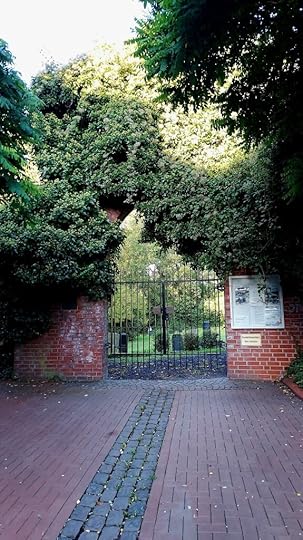
The entrance to the Jewish cemetery in Castrop-Rauxel.
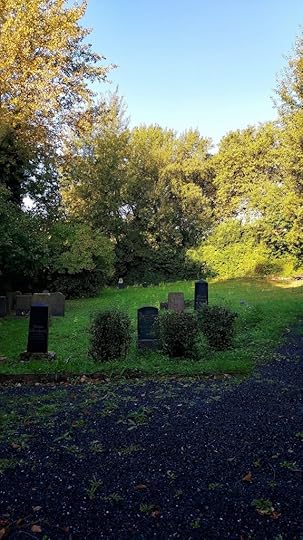
A look through the gates of the Jewish cemetery of Castrop-Rauxel. Many of the headstones were destroyed by the Nazis, though 56 remain.
Right next to the Jewish cemetery, I also came upon this delightful piece of public art called the “Taubenvatta” (Pigeon Daddy), which celebrates the popularity of keeping and racing homing pigeons in the Ruhrgebiet. Indeed, homing pigeons used to be called “the race horses of the working class” in the Ruhrgebiet. Though the association of pigeon racing with working class culture isn’t just a thing in Germany, but in the UK as well. If you’ve seen the 1984 nuclear war drama Threads, the character of Jimmy, a young working class man, keeps homing pigeons and his little brother Michael is graphically incinerated by a nuclear bomb while huddling in the cote with the pigeons. Yes, it’s that kind of movie.
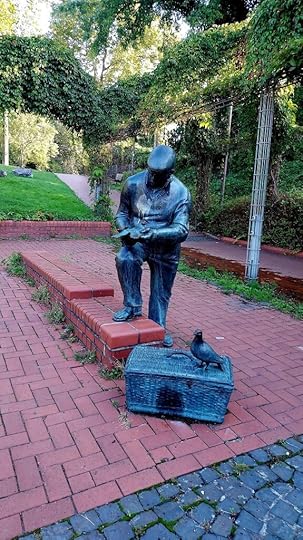
The “Taubenvatta” (pigeon daddy) statue in Castrop-Rauxel was erected in 1986 to commemorate the popularity of pigeon racing among the working class people of the Ruhrgebiet.
As I ventured further into the city center, I had to stop at a pedestrian crossing where the pedestrian traffic light symbol was not the regular stick figure, but a little miner with a lantern. Apparently, this is a thing in the Ruhrgebiet. Coal mining may be dead, but the miners are still around, immortalised as “Ampelmännchen”. In many ways, this is very illustrative of how the Ruhrgebiet has turned its industrial history into a tourist attraction.
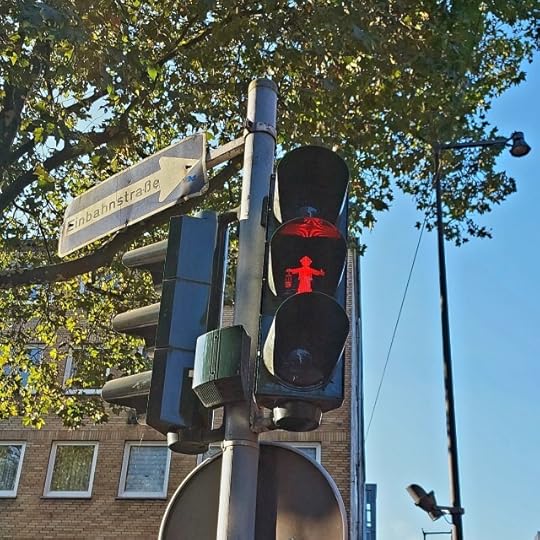
A little miner with helmet and lantern serves as an “Ampelmännchen” in Castrop-Rauxel.
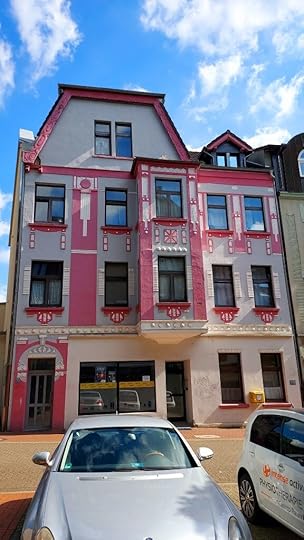
Barbie’s Art Noveau dreamhouse, Castrop-Rauxel edition.
The city center of Castrop-Rauxel isn’t anything to write home about. The Ruhrgebiet was heavily bombed in WWII due to its status as an industrial powerhouse, so you basically have a pedestrian zone with lots of drab postwar buildings. Since it was Sunday, the shops were closed anyway and most of them were the same chains you’ll find in any city center or mall anywhere in Germany anyway. And of course there was the obligatory husk of a former Karstadt department store (or maybe it was a Kaufhof/Horten or Hertie, though the architecture suggests Karstadt) occupied by some smaller stores that in no way fill the giant building. Personally, I think the death of the department store is one of the great tragedies of our age, but then the department stores are to blame for their own demise, because they removed all the stuff that provided a reason to go there, the toy departments, household good departments, stationery departments, fabric and craft departments, media and music departments, and basically became giant fashion stores offering overpiced clothing that you could easily get elsewhere. A lot of the surviving so-called department stores wouldn’t even qualify as department stores anymore by my personal definition, since they only have clothing and maybe shoes.
One thing that struck me as odd was that I saw several closed food stalls in the city center. Now food stalls aren’t that uncommon in pedestrian zones, but there were a lot of them and they offered not just classic standbys like currywurst and roast chicken, but typical fairground food like cotton candy and candied almonds. I later learned that Castrop-Rauxel’s annual autun fair actually took place that very same weekend. But since I was so early in the morning, it of course wasn’t open yet. Here is a video from last year’s fair.
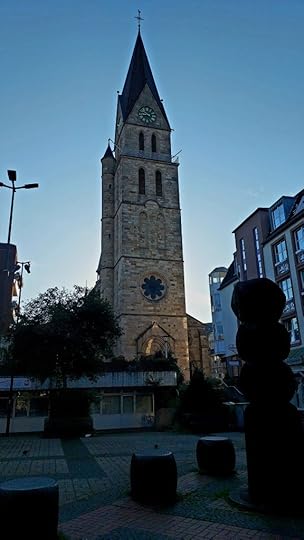
The Catholic St. Lambertus Church in Castrop-Rauxel. There has been a church on this spot since the times of Charlesmagne, but when the city crew in the 19th century, the medieval church was expanded and partially demolished for this one, which dates from 1889.
I also found a bakery and it turned out to be a branch of Bakery Grobe, a Dortmund based chain with branches all over the Ruhrgebiet. During my trip to Neuss, I’d stopped at another branch of the same chain, so I knew they were good. I settled down and ordered a coffee and something called a Dortmund market omelette, which turned out to be a cheese and tomato omelette. It tasted very good, but then I really like omelette, though I’m not good at making it myself.

Dortmund market omelette, courtesy of Bakery Grobe in Castrop-Rauxel.
Once I’d finished breakfast, it was half past nine. So I strolled back to my car and headed to the con, which will be covered in part 2.
Cora Buhlert's Blog
- Cora Buhlert's profile
- 14 followers



